Search the Blog
Categories
- Books & Reading
- Broadband Buzz
- Census
- Education & Training
- General
- Grants
- Information Resources
- Library Management
- Nebraska Center for the Book
- Nebraska Memories
- Now hiring @ your library
- Preservation
- Pretty Sweet Tech
- Programming
- Public Library Boards of Trustees
- Public Relations
- Talking Book & Braille Service (TBBS)
- Technology
- Uncategorized
- What's Up Doc / Govdocs
- Youth Services
Archives
Subscribe
Search Results for: Book Briefs
Book Briefs: New University of Nebraska Press Books at the Nebraska Publications Clearinghouse

The Nebraska Publications Clearinghouse receives documents every month from all Nebraska state agencies, including the University of Nebraska Press (UNP). Each month we will be showcasing the UNP books that the Clearinghouse receives. UNP books, as well as all Nebraska state documents, are available for checkout by libraries and librarians for their patrons.
Here are the UNP books the Clearinghouse received in November and December 2020:
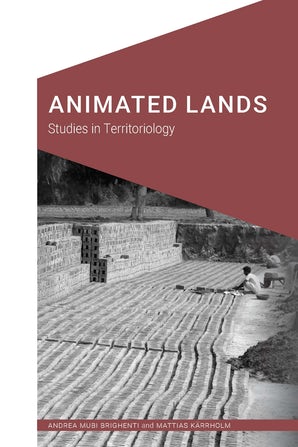
Animated Lands : Studies in Territoriology by Andrea Mubi Brighenti and Mattias Karrholm (Series: Cultural Geographies ; Rewriting the Earth)
In Animated Lands Andrea Mubi Brighenti and Mattias Kärrholm focus on territory as a living phenomenon—and territoriality as an active and constantly reshaping force. They explore the complexity of territorial production through a series of parallel investigations into fundamental territorial themes, such as rhythm, synchronization, melody, morphogenesis, and animism.
The notion of territory is excavated through case studies including the analysis of urban playgrounds, homemaking, the transformations of urban walls, and the stabilization of peculiar building types such as the house-museum. These empirical examples span such cities as Ahmedabad, Amsterdam, London, and Rome. Animated Lands provides a broad introduction to what a theory of territories could be and how it could help to advance sociospatial studies.
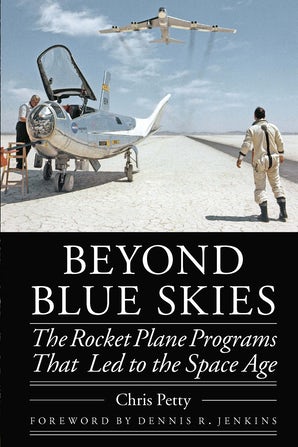
Beyond Blue Skies : The Rocket Plant Programs That Led to the Space Age by Chris Petty (Series: Outward Odyssey:A People’s History of Spaceflight)
In 1945 some experts still considered the so-called sound barrier an impenetrable wall, while winged rocket planes remained largely relegated to science fiction. But soon a series of unique rocket-powered research aircraft and the dedicated individuals who built, maintained, and flew them began to push the boundaries of flight in aviation’s quest to move ever higher, ever faster, toward the unknown. Beyond Blue Skies examines the thirty-year period after World War II during which aviation experienced an unprecedented era of progress that led the United States to the boundaries of outer space.
Between 1946 and 1975, an ancient dry lakebed in California’s High Desert played host to a series of rocket-powered research aircraft built to investigate the outer reaches of flight. The western Mojave’s Rogers Dry Lake became home to Edwards Air Force Base, NASA’s Flight Research Center, and an elite cadre of test pilots. Although one of them—Chuck Yeager—would rank among the most famous names in history, most who flew there during those years played their parts away from public view. The risks they routinely accepted were every bit as real as those facing NASA’s astronauts, but no magazine stories or free Corvettes awaited them—just long days in a close-knit community in the High Desert.
The role of not only the test pilots but the engineers, aerodynamicists, and support staff in making supersonic flight possible has been widely overlooked. Beyond Blue Skies charts the triumphs and tragedies of the rocket-plane era and the unsung efforts of the men and women who made amazing achievements possible.
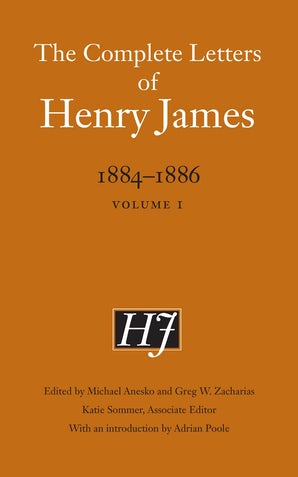
The Complete Letters of Henry James, 1884-1886, Volume I Edited by Michael Anesko and Greg W. Zacharias (Series: The Complete Letters of Henry James)Recipient of the Approved Edition seal from the Modern Language Association’s Committee on Scholarly Editions
This volume of The Complete Letters of Henry James, 1884–1886 includes 179 letters, 94 published for the first time, written between November 11, 1884, and December 21, 1885. The letters mark Henry James’s ongoing efforts to care for his sister, develop his work, strengthen his professional status, build friendships old and new, and maximize his income. James details work on midcareer novels The Bostonians and The Princess Casamassima as well as on tales that would help to define his career. He reveals his close acquaintance with British politics and politicians. This volume opens with Alice James’s arrival in England and concludes with Henry James’s plans to leave his flat in Piccadilly for his new address in De Vere Gardens, Kensington.
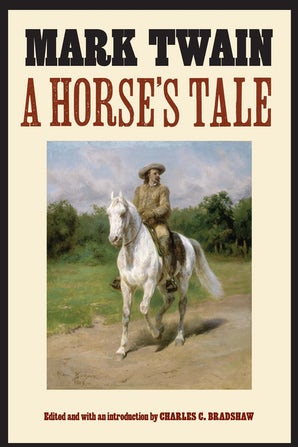
A Horse’s Tale by Mark Twain ; Edited and with an introduction by Charles C. Bradshaw. (Series: The Papers of William F. “Buffalo Bill” Cody)
At the turn of the twentieth century Minnie Maddern Fiske, a New York actress, socialite, and animal rights activist, wrote to Mark Twain with an unusual request: for Twain to write about the evils of bullfighting equal to that of his anti-vivisectionist story A Dog’s Tale. Twain responded with A Horse’s Tale, a comic animal tale that doubled as a frontier adventure and political diatribe.
A Horse’s Tale concerns Soldier Boy, Buffalo Bill Cody’s favorite horse, as the protagonist and sometime narrator at a fictional frontier outpost with the U.S. Seventh Cavalry. When the general’s orphaned niece arrives, Buffalo Bill takes her under his wing and ultimately lends her Soldier Boy so that they may seek adventure together. Twain uses the friendship between the girl and the horse as the basis for his eventual indictment of the barbarism of Spanish bullfighting. Twain’s novella is unusual for its complex tone—combining a comic children’s story and a dark portrait of animal cruelty. Including the themes of transatlantic relations and frontier culture, Twain offers a fresh look into the world of Buffalo Bill Cody from the perspective of one of America’s most beloved authors.
First published in 1906 in Harper’s Monthly and as a single volume the following year, A Horse’s Tale never again appeared in print except in anthologies of Twain’s work. This edition includes the full text of Twain’s original story, an introduction that situates the work in historical and biographical context, thorough annotations, and the addition of significant archival material related to Twain, Cody, and Fiske.
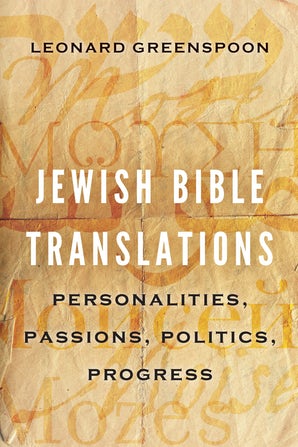
Jewish Bible Translations : Personalities, Passions, Politics, Progress by Leonard Greenspoon
Jewish Bible Translations is the first book to examine Jewish Bible translations from the third century BCE to our day. It is an overdue corrective of an important story that has been regularly omitted or downgraded in other histories of Bible translation.
Examining a wide range of translations over twenty-four centuries, Leonard Greenspoon delves into the historical, cultural, linguistic, and religious contexts of versions in eleven languages: Arabic, Aramaic, English, French, German, Greek, Hungarian, Italian, Russian, Spanish, and Yiddish. He profiles many Jewish translators, among them Buber, Hirsch, Kaplan, Leeser, Luzzatto, Mendelssohn, Orlinsky, and Saadiah Gaon, framing their aspirations within the Jewish and larger milieus in which they worked.
Greenspoon differentiates their principles, styles, and techniques—for example, their choice to emphasize either literal reflections of the Hebrew or distinctive elements of the vernacular language—and their underlying rationales. As he highlights distinctive features of Jewish Bible translations, he offers new insights regarding their shared characteristics and their limits. Additionally, Greenspoon shows how profoundly Jewish translators and interpreters influenced the style and diction of the King James Bible.
Accessible and authoritative for all from beginners to scholars, Jewish Bible Translations enables readers to make their own informed evaluations of individual translations and to holistically assess Bible translation within Judaism.
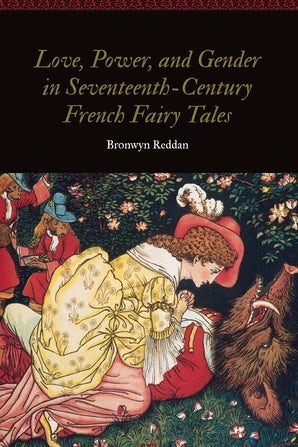
Love, Power, and Gender in Seventeenth-Century French Fairy Tales by Bronwyn Reddan (Series: Women and Gender in the Early Modern World)
Love is a key ingredient in the stereotypical fairy-tale ending in which everyone lives happily ever after. This romantic formula continues to influence contemporary ideas about love and marriage, but it ignores the history of love as an emotion that shapes and is shaped by hierarchies of power including gender, class, education, and social status. This interdisciplinary study questions the idealization of love as the ultimate happy ending by showing how the conteuses, the women writers who dominated the first French fairy-tale vogue in the 1690s, used the fairy-tale genre to critique the power dynamics of courtship and marriage. Their tales do not sit comfortably in the fairy-tale canon as they explore the good, the bad, and the ugly effects of love and marriage on the lives of their heroines.
Bronwyn Reddan argues that the conteuses’ scripts for love emphasize the importance of gender in determining the “right” way to love in seventeenth-century France. Their version of fairy-tale love is historical and contingent rather than universal and timeless. This conversation about love compels revision of the happily-ever-after narrative and offers incisive commentary on the gendered scripts for the performance of love in courtship and marriage in seventeenth-century France.
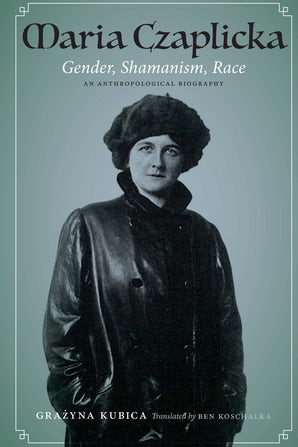
Maria Czaplicka : Gender, Shamanism, Race by Grazyna Kubica ; Translated by Ben Koschalka (Series: Critical Studies in the History of Anthropology)
This biography of the Polish British anthropologist Maria Czaplicka (1884–1921) is also a cultural study of the dynamics of the anthropological collective presented from a researcher-centric perspective. Czaplicka, together with Bronisław Malinowski, studied anthropology in London and later at Oxford, then she headed the Yenisei Expedition to Siberia (1914–15) and was the first female lecturer of anthropology at Oxford. She was an engaged feminist and an expert on political issues in Northern Asia and Eastern Europe. But this remarkable woman’s career was cut short by suicide. Like many women anthropologists of the time, Czaplicka journeyed through various academic institutions, and her legacy has been dispersed and her field materials lost.
Grażyna Kubica covers the major events in Czaplicka’s life and provides contextual knowledge about the intellectual formation in which Czaplicka grew up, including the Warsaw radical intelligentsia and the contemporary anthropology of which she became a part. Kubica also presents a critical analysis of Czaplicka’s scientific and literary works, related to the issues of gender, shamanism, and race. Kubica shows how Czaplicka’s sense of agency and subjectivity enriched and shaped the practice of anthropology and sheds light on how scientific knowledge arises and is produced.
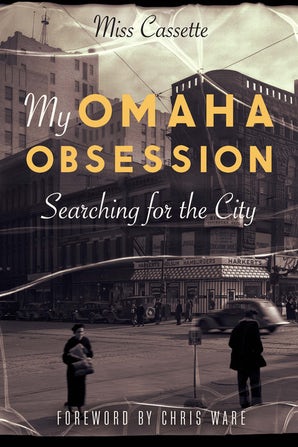
My Omaha Obsession : Searching for the City by Miss Cassette
My Omaha Obsession takes the reader on an idiosyncratic tour through some of Omaha’s neighborhoods, buildings, architecture, and people, celebrating the city’s unusual history. Rather than covering the city’s best-known sites, Miss Cassette is irresistibly drawn to strange little buildings and glorious large homes that don’t exist anymore as well as to stories of Harkert’s Holsum Hamburgers and the Twenties Club.
Piecing together the records of buildings and homes and everything interesting that came after, Miss Cassette shares her observations of the property and its significance to Omaha. She scrutinizes land deeds, insurance maps, tax records, and old newspaper articles to uncover a property’s singular story. Through conversations with fellow detectives and history enthusiasts, she guides readers along her path of hunches, personal interests, mishaps, and more.
As a longtime resident of Omaha, Miss Cassette is informed by memories of her youth combined with an enduring curiosity about the city’s offbeat relics and remains. Part memoir and part research guide with a healthy dose of colorful wandering, My Omaha Obsession celebrates the historic built environment and searches for the people who shaped early Omaha.
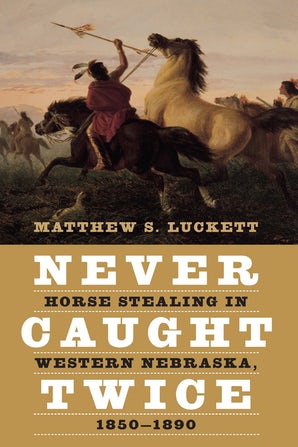
Never Caught Twice : Horse Stealing in Western Nebraska, 1850-1890 by Matthew S. Luckett
Never Caught Twice presents the untold history of horse raiding and stealing on the Great Plains of western Nebraska. By investigating horse stealing by and from four Plains groups—American Indians, the U.S. Army, ranchers and cowboys, and farmers—Matthew S. Luckett clarifies a widely misunderstood crime in Western mythology and shows that horse stealing transformed plains culture and settlement in fundamental and surprising ways.
From Lakota and Cheyenne horse raids to rustling gangs in the Sandhills, horse theft was widespread and devastating across the region. The horse’s critical importance in both Native and white societies meant that horse stealing destabilized communities and jeopardized the peace throughout the plains, instigating massacres and murders and causing people to act furiously in defense of their most expensive, most important, and most beloved property. But as it became increasingly clear that no one legal or military institution could fully control it, would-be victims desperately sought a solution that would spare their farms and families from the calamitous loss of a horse. For some, that solution was violence. Never Caught Twice shows how the story of horse stealing across western Nebraska and the Great Plains was in many ways the story of the old West itself.
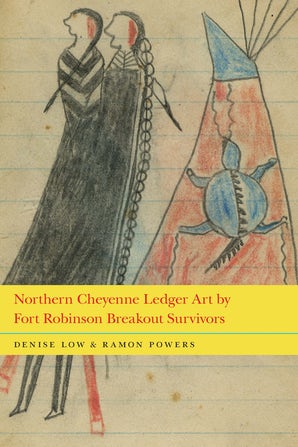
Northern Cheyenne Ledger Art by Fort Robinson Breakout Survivors by Denise Low and Ramon Powers
Northern Cheyenne Ledger Art by Fort Robinson Breakout Survivors presents the images of Native warriors—Wild Hog, Porcupine, and Left Hand, as well as possibly Noisy Walker (or Old Man), Old Crow, Blacksmith, and Tangled Hair—as they awaited probable execution in the Dodge City jail in 1879. When Sheriff Bat Masterson provided drawing materials, the men created war books that were coded to avoid confrontation with white authorities and to narrate survival from a Northern Cheyenne point of view. The prisoners used the ledger-art notebooks to maintain their cultural practices during incarceration and as gifts and for barter with whites in the prison where they struggled to survive.
The ledger-art notebooks present evidence of spiritual practice and include images of contemporaneous animals of the region, hunting, courtship, dance, social groupings, and a few war-related scenes. Denise Low and Ramon Powers include biographical materials from the imprisonment and subsequent release, which extend the historical arc of Northern Cheyenne heroes of the Plains Indian Wars into reservation times. Sources include selected ledger drawings, army reports, letters, newspapers, and interviews with some of the Northern Cheyenne men and their descendants. Accounts from a firsthand witness of the drawings and composition of the ledgers themselves give further information about Native perspectives on the conflicted history of the North American West in the nineteenth century and beyond.
This group of artists jailed after the tragedy of the Fort Robinson Breakout have left a legacy of courage and powerful art.
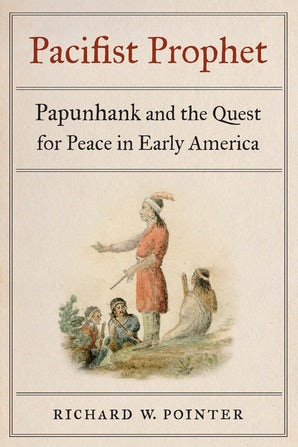
Pacifist Prophet : Paunhank and the Quest for Peace in Early America by Richard W. Pointer
Pacifist Prophet recounts the untold history of peaceable Native Americans in the eighteenth century, as explored through the world of Papunhank (ca. 1705–75), a Munsee and Moravian prophet, preacher, reformer, and diplomat. Papunhank’s life was dominated by a search for a peaceful homeland in Pennsylvania and the Ohio country amid the upheavals of the era between the Seven Years’ War and the American Revolution.
His efforts paralleled other Indian quests for autonomy but with a crucial twist: he was a pacifist committed to using only nonviolent means. Such an approach countered the messages of other Native prophets and ran against the tide in an early American world increasingly wrecked with violence, racial hatred, and political turmoil. Nevertheless, Papunhank was not alone. He followed and contributed to a longer and wider indigenous peace tradition.
Richard W. Pointer shows how Papunhank pushed beyond the pragmatic pacifism of other Indians and developed from indigenous and Christian influences a principled pacifism that became the driving force of his life and leadership. Hundreds of Native people embraced his call to be “a great Lover of Peace” in their quests for home. Against formidable odds, Papunhank’s prophetic message spoke boldly to Euro-American and Native centers of power and kept many Indians alive during a time when their very survival was constantly threatened. Papunhank’s story sheds critical new light on the responses of some Munsees, Delawares, Mahicans, Nanticokes, and Conoys for whom the “way of war” was no way at all.
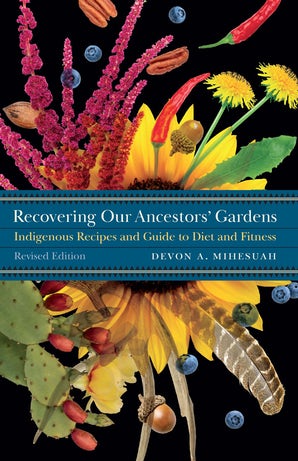
Recovering Our Ancestors’ Gardens : Indigenous Recipes and Guide to Diet and Fitness by Devon A. Mihesuah
2020 Gourmand World Cookbook Award
Winner of the Gourmand International World Cookbook Award,Recovering Our Ancestors’ Gardens is back! Featuring an expanded array of tempting recipes of indigenous ingredients and practical advice about health, fitness, and becoming involved in the burgeoning indigenous food sovereignty movement, the acclaimed Choctaw author and scholar Devon A. Mihesuah draws on the rich indigenous heritages of this continent to offer a helpful guide to a healthier life.
Recovering Our Ancestors’ Gardens features pointed discussions about the causes of the generally poor state of indigenous health today. Diminished health, Mihesuah contends, is a pervasive consequence of colonialism, but by advocating for political, social, economic, and environmental changes, traditional food systems and activities can be reclaimed and made relevant for a healthier lifestyle today.
New recipes feature pawpaw sorbet, dandelion salad, lima bean hummus, cranberry pie with cornmeal crust, grape dumplings, green chile and turkey posole, and blue corn pancakes, among other dishes. Savory, natural, and steeped in the Native traditions of this land, these recipes are sure to delight and satisfy.
This new edition is revised, updated, and contains new information, new chapters, and an extensive curriculum guide that includes objectives, resources, study questions, assignments, and activities for teachers, librarians, food sovereignty activists, and anyone wanting to know more about indigenous foodways.
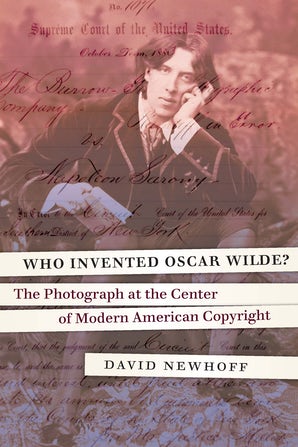
Who Invented Oscar Wilde? : The Photograph at the Center of Modern American Copyright by David Newhoff
In early 1882, before young Oscar Wilde embarked on his lecture tour across America, he posed for publicity photos taken by a famously eccentric New York photographer named Napoleon Sarony. Few would guess that one of those photographs would become the subject of the Supreme Court case that challenged copyright protection for all photography—a constitutional question that asked how a machine-made image could possibly be a work of human creativity.
Who Invented Oscar Wilde? is a story about the nature of authorship and the “convenient fiction” we call copyright. While a seemingly obscure topic, copyright has been a hotly contested issue almost since the day the internet became publicly accessible. The presumed obsolescence of authorial rights in this age of abundant access has fueled a debate that reaches far beyond the question of compensation for authors of works. Much of the literature on the subject is either highly academic, highly critical of copyright, or both.
With a light and balanced touch, David Newhoff makes a case for intellectual property law, tracing the concept of authorship from copyright’s ancient beginnings to its adoption in American culture to its eventual confrontation with photography and its relevance in the digital age. Newhoff tells a little-known story that will appeal to a broad spectrum of interests while making an argument that copyright is an essential ingredient to upholding the principles on which liberal democracy is founded.
**All book covers and synopses courtesy of University of Nebraska Press (https://www.nebraskapress.unl.edu/)
Book Briefs: New University of Nebraska Press Books at the Nebraska Publications Clearinghouse

The Nebraska Publications Clearinghouse receives documents every month from all Nebraska state agencies, including the University of Nebraska Press (UNP). Each month we will be showcasing the UNP books that the Clearinghouse receives. UNP books, as well as all Nebraska state documents, are available for checkout by libraries and librarians for their patrons.
Here are the UNP books the Clearinghouse received in September and October 2020:
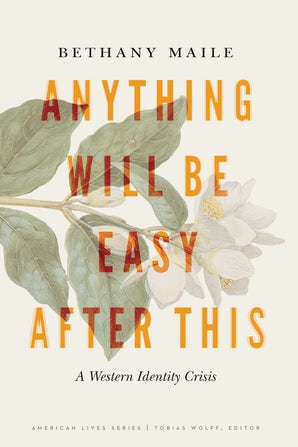
Anything Will Be Easy After This : A Western Identity Crisis Bethany Maile (Series: American Lives)
Bethany Maile had a mythological American West in mind when she returned to Idaho after dropping out of college in Boston, only to find a farm-town-turned-suburb instead of the Wild West wonderland she remembered. Haunted by what she had so completely misremembered, Maile resolved to investigate her attachment to the western myth, however flawed.
Deciding to engage in a variety of “western” events, Maile trailed rodeo queens, bid on cattle, fired .22s at the gun range, and searched out wild horses. With lively reportage and a sharp wit, she recounts her efforts to understand how the western myth is outdated yet persistent while ultimately exploring the need for story and the risks inherent to that need. Anything Will Be Easy after This traces Maile’s evolution from a girl suckered by a busted-down story to a more knowing woman who discovers a new narrative that enchants without deluding.
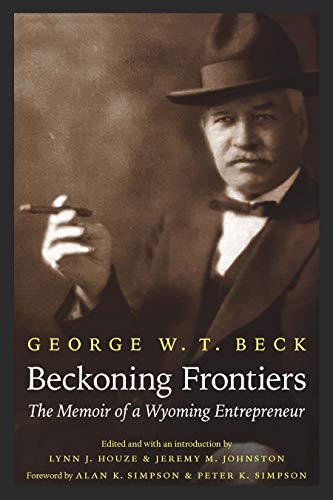
Beckoning Frontiers : The Memoir of a Wyoming Entrepreneur George W. T. Beck, Edited and with an introduction by Lynn J. Houze and Jeremy M. Johnston (Series: The Papers of William F. “Buffalo Bill” Cody)
George W. T. Beck, an influential rancher and entrepreneur in the American West, collaborated with William F. “Buffalo Bill” Cody to establish the town of Cody, Wyoming, in the 1890s. He advanced his financial investments in Wyoming through his numerous personal and professional contacts with various eastern investors and politicians in Washington DC. Beck’s family—his father a Kentucky senator and his mother a grandniece of George Washington—and his adventures in the American West resulted in personal associates who ranged from western legends Buffalo Bill, Jesse James, and Calamity Jane to wealthy American elites such as George and Phoebe Hearst and Theodore Roosevelt.
This definitive edition of Beck’s memoir provides a glimpse of early life in Wyoming, offering readers a rare perspective on how community boosters cooperated with political leaders and wealthy financiers. Beck’s memoir, introduced and annotated by Lynn J. Houze and Jeremy M. Johnston, offers a unique and sometimes amusing view of financial dealings in eastern boardrooms, as well as stories of Beck’s adventures with Buffalo Bill in Wyoming. Beck’s memoir demonstrates not only his interest in developing the West but also his humor and his willingness to collaborate with a variety of people.

Foxlogic, Fireweed Jennifer K. Sweeney (Series: The Backwaters Prize in Poetry)
Winner of the Backwaters Prize in Poetry, Jennifer K. Sweeney’s Foxlogic, Fireweed follows a lyrical sequence of five physical and emotional terrains—floodplain, coast, desert, suburbia, and mesa—braiding themes of nature, domesticity, isolation, and human relationships. These are poems of the earth’s wild heart, its searing mysteries, its hollows, and its species, poems of the complex domestic space, of before and after motherhood, gun terror, the election, of dislocation and home, and of how we circle toward and away from our centers. Sweeney is not afraid to take up the domestic and inner lives of women, a nuanced relationship with the natural world that feels female or even maternal, or a duty to keeping alive poetry’s big questions of transcendence, revelation, awe, and deep presence in the ordinary.

If the Body Allows It Megan Cummins (Series: Prairie Schooner Book Prize in Fiction
Winner of the Prairie Schooner Book Prize in Fiction, If the Body Allows It is divided into six parts and framed by the story of Marie, a woman in her thirties living in Newark, New Jersey. Suffering from a chronic autoimmune illness, she also struggles with guilt over the overdose and death of her father, whom she feels she betrayed at the end of his life. The stories within the frame—about failed marriages, places of isolation and protection, teenage mistakes, and forging a life in the aftermath—are the stories the narrator writes after she meets and falls in love with a man whose grief mirrors her own. If the Body Allows It explores illness and its aftermath, guilt and addiction, and the relationships the characters form after they’ve lost everyone else, including themselves.
Introspective, devastating, and funny, If the Body Allows It grapples with the idea that life is always on the brink of never being the same again.
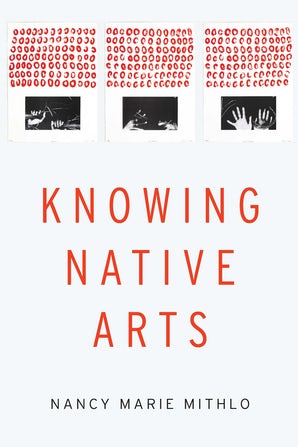
Knowing Native Arts Nancy Marie Mithlo
Knowing Native Arts brings Nancy Marie Mithlo’s Native insider perspective to understanding the significance of Indigenous arts in national and global milieus. These musings, written from the perspective of a senior academic and curator traversing a dynamic and at turns fraught era of Native self-determination, are a critical appraisal of a system that is often broken for Native peoples seeking equity in the arts.
Mithlo addresses crucial issues, such as the professionalization of Native arts scholarship, disparities in philanthropy and training, ethnic fraud, and the receptive scope of Native arts in new global and digital realms. This contribution to the field of fine arts broadens the scope of discussions and offers insights that are often excluded from contemporary appraisals.
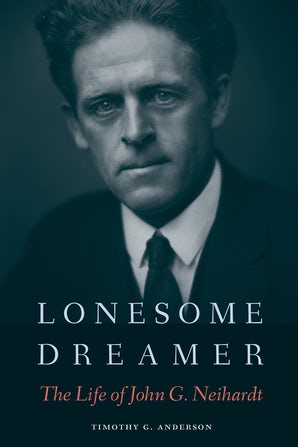
Lonesome Dreamer : the Life of John G. Neihardt Timothy G. Anderson
American poet and writer John G. Neihardt (1881–1973) possessed an inquiring and spiritual mind. Those qualities came to the fore in Black Elk Speaks, the story of the Lakota holy man Black Elk, for which he is best remembered. Over the course of thirty years he also wrote a five-volume epic poem, A Cycle of the West, which told the story of the settling of the American West.
Despite Neihardt’s widespread name recognition, the success of Black Elk Speaks, and a list of critically acclaimed books and poems, Lonesome Dreamer is the first biography of Neihardt in nearly forty years. Timothy G. Anderson describes Neihardt’s life from his humble beginnings in Illinois, to being named poet laureate of Nebraska in 1921, to his appearance on the Dick Cavett Show at the age of ninety. Anderson also delves into Neihardt’s success as a poet far from the East Coast literary establishment, his resistance to modernist movements in poetry, and his wish to understand and describe the experience of the Plains Indians. Offering insight into both his personal and his literary life, this biography reaffirms Neihardt’s place in American literary history, his successes and failures, and his unbreakable spirit.
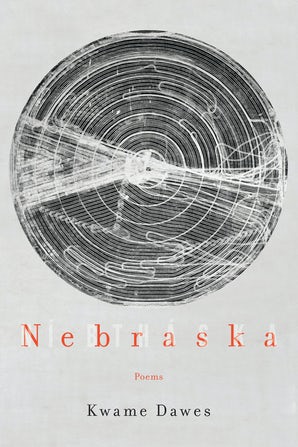
Nebraska : Poems Kwame Dawes
Kwame Dawes is not a native Nebraskan. Born in Ghana, he later moved to Jamaica, where he spent most of his childhood and early adulthood. In 1992 he relocated to the United States and eventually found himself an American living in Lincoln, Nebraska.
In Nebraska, this beautiful and evocative collection of poems, Dawes explores a theme constant in his work—the intersection of memory, home, and artistic invention. The poems, set against the backdrop of Nebraska’s discrete cycle of seasons, are meditative even as they search for a sense of place in a new landscape. While he shovels snow or walks in the bitter cold to his car, he is engulfed with memories of Kingston, yet when he travels, he finds himself longing for the open space of the plains and the first snowfall. With a strong sense of place and haunting memories, Dawes grapples with life in Nebraska as a transplant.
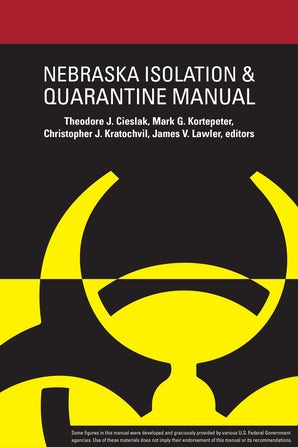
Nebraska Isolation & Quarantine Manual Edited by Theodore J. Cieslak, Mark G. Kortepeter, Christopher J. Kratochvil, and James V. Lawler
The University of Nebraska Medical Center has gained international recognition for its expertise in the control and management of highly infectious diseases, with a good deal of public attention given to its work during the 2014 Ebola outbreak in west Africa and now in 2020 with its biocontainment and treatment of more than a dozen cruise ship evacuees who were exposed to the coronavirus. The Nebraska Isolation and Quarantine Manual is a practical guide for local public health officials, emergency management personnel, and health care providers looking to implement evidence-based best practices in the event of an infectious disease outbreak.

Nebraska’s Bucks & Bulls : the Greatest Stories of Hunting Whitetail, Mule Deer, and Elk in the Cornhusker State Joel W. Helmer
Eclipsing Memorial Stadium on a Husker football game day, deer season is arguably the largest single sporting event of the year in Nebraska, with more than one hundred thousand hunters going afield with the hopes of tagging a trophy buck or bull.
Nebraska’s Bucks and Bulls tells the stories and shares the photographs of the greatest whitetail, mule deer, and elk shot in Nebraska. Collected through firsthand interviews with the hunters, these personal hunting stories span the decades from the mid-1940s through the 2010s. Each story shares the excitement and adventure of the hunt while weaving in Nebraska history, ecology, and geography. Photographs of the trophy animals showcase not only the quality and variety of big-game hunting in Nebraska but also the changes in hunting clothes, gear, guns, and vehicles through the state’s history.
Recounted by Joel W. Helmer, an avid hunter and official measurer for the Boone and Crockett Club, which created the scoring system for measuring North American big-game animals, each chapter tells the story of a buck or bull certified through official state or national records books. Nebraska’s Bucks and Bulls has finally gathered the state’s greatest hunting tales in one place.
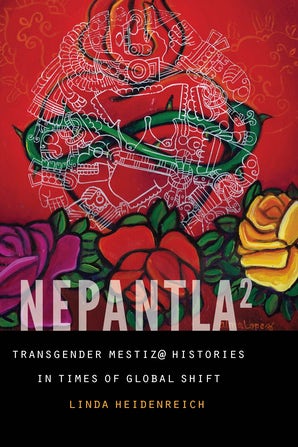
Nepantla Squared : Transgender Mestiz@ Histories in Times of Global Shift Linda Heidenreich (Series: Expanding Frontiers: Interdisciplinary Approaches to Studies of Women, Gender, and Sexuality)
Nepantla Squared maps the lives of two transgender mestiz@s, one during the turn of the twentieth century and one during the turn of the twenty-first century, to chart the ways race, gender, sex, ethnicity, and capital function differently in different times. To address the erasure of transgender mestiz@ realities from history, Linda Heidenreich employs an intersectional analysis that critiques monopoly and global capitalism. Heidenreich builds on the work of Gloria Anzaldúa’s concept of nepantleras, those who could live between and embody more than one culture, to coin the term nepantla², marking times of capitalist transition where gender was also in motion. Transgender mestiz@s, too, embodied that movement.
Heidenreich insists on a careful examination of the multiple in-between spaces that construct lives between cultures and genders during in-between times of shifting empire and capital. In so doing, they offer an important discussion of race, class, nation, and citizenship centered on transgender bodies of color that challenges readers to rethink the way they understand the gendered social and economic challenges of today.

Sky Songs : Meditations on Loving a Broken World Jennifer Sinor (Series: American Lives)
Sky Songs is a collection of essays that takes inspiration from the ancient seabed in which Jennifer Sinor lives, an elemental landscape that reminds her that our lives are shaped by all that has passed through. Beginning with the conception of her first son, which coincided with the tragic death of her uncle on an Alaskan river, and ending a decade later in the Himalayan home of the Dalai Lama, Sinor offers a lyric exploration of language, love, and the promise inherent in the stories we tell: to remember.
In these essays, Sinor takes us through the mountains, deserts, and rivers of the West and along with her on her travels to India. Whether rooted in the dailiness of raising children or practicing yoga, Sinor searches for the places where grace resides. The essays often weave several narrative threads together in the search for relationship and connection. A mother, writer, teacher, and yoga instructor, Sinor ultimately tackles the most difficult question: how to live in a broken world filled with both suffering and grace.
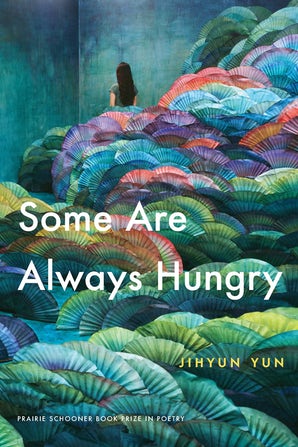
Some Are Always Hungry Jihyun Yun (Series: Prairie Schooner Book Prize in Poetry)
Winner of the Prairie Schooner Book Prize in Poetry, Some Are Always Hungry chronicles a family’s wartime survival, immigration, and heirloom trauma through the lens of food, or the lack thereof. Through the vehicle of recipe, butchery, and dinner table poems, the collection negotiates the myriad ways diasporic communities comfort and name themselves in other nations, as well as the ways cuisine is inextricably linked to occupation, transmission, and survival. Dwelling on the personal as much as the historical, Some Are Always Hungry traces the lineage of the speaker’s place in history and diaspora through mythmaking and cooking, which is to say, conjuring.
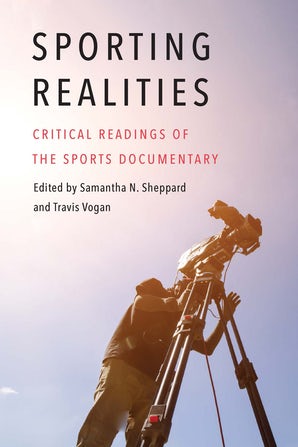
Sporting Realitites : Critical Readings of the Sports Documentary Edited by Samantha N. Sheppard and Travis Vogan (Series: Sports, Media, and Society)
Despite the increasing number of popular and celebrated sports documentaries in contemporary culture, such as ESPN’s 30 for 30 series, there has been little scholarly engagement with this genre. Sports documentaries, like all films, do not merely showcase objective reality but rather construct specific versions of sporting culture that serve distinct economic, industrial, institutional, historical, and sociopolitical ends ripe for criticism, contextualization, and exploration.
Sporting Realities brings together a diverse group of scholars to probe the sports documentary’s cultural meanings, aesthetic practices, industrial and commercial dimensions, and political contours across historical, social, medium-specific, and geographic contexts. It considers and critiques the sports documentary’s visible and powerful position in contemporary culture and forges novel connections between the study of nonfiction media and sport.
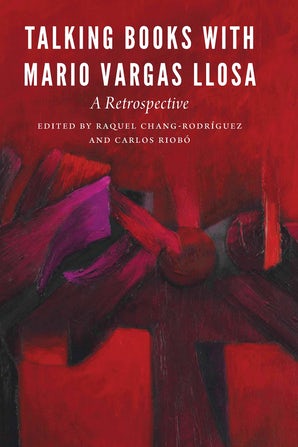
Talking Books with Mario Vargas Llosa : A Retrospective Edited by Raquel Chang-Rodríguez and Carlos Riobó (Series: New Hispanisms)
The essays included in Talking Books with Mario Vargas Llosa celebrate Mario Vargas Llosa’s visits to the City College of New York, the creation of the Cátedra Vargas Llosa in his honor, and the interests of the Peruvian author in reading and books. This volume contains previously unpublished material by Vargas Llosa himself, as well as by novelists and literary critics associated with the Cátedra.
This collection offers readers an opportunity to learn about Vargas Llosa’s body of work through multiple perspectives: his own and those of eminent fiction writers and important literary critics. The book offers significant analysis and rich conversation that bring to life many of the Nobel Laureate’s characters and provide insights into his writing process and imagination. As the last surviving member of the original group of writers of the Latin American Boom—which included Gabriel García Márquez, Carlos Fuentes, and Julio Cortázar—Vargas Llosa endures as a literary icon because his fiction has remained fresh and innovative. His prolific works span many different themes and subgenres.
A combination of literary analyses and anecdotal contributions in this volume reveal the little-known human and intellectual dimensions of Vargas Llosa the writer and Vargas Llosa the man.
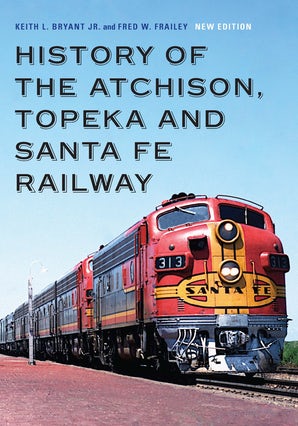
History of the Atchison, Topeka and Santa Fe Railway Keith L. Bryant Jr. and Fred W. Frailey
Cyrus K. Holliday envisioned a railroad that would run from Kansas to the Pacific, increasing the commerce and prosperity of the nation. With farsighted investors and shrewd management, the Atchison, Topeka and Santa Fe Railway grew from Holliday’s idea into a model of the modern, rapid, and efficient railroad. There were many growing pains early on, including rustlers, thieves, and desperadoes as well as the nineteenth century’s economic and climatic hardships. The railroad eventually extended from Chicago to San Francisco, with substantial holdings in oil fields, timber land, uranium mines, pipelines, and real estate.
This is the first comprehensive history of the iconic Atchison, Topeka and Santa Fe Railway, from its birth in 1859 to its termination in 1996. This volume discusses the construction and operation of the railway, the strategies of its leaders, the evolution of its locomotive fleet, and its famed passenger service with partner Fred Harvey. The vast changes within the nation’s railway system led to a merger with the Burlington Northern and the creation of the BNSF Railway.
An iconic railroad, the Santa Fe at its peak operated thirteen thousand miles of routes and served the southwestern region of the nation with the corporate slogan “Santa Fe All the Way.” This new edition covers almost twenty-five more years of history, including the merger of the Santa Fe and Burlington Northern railroads and new material on labor, minorities, and women on the carrier along with new and updated maps and photographs.
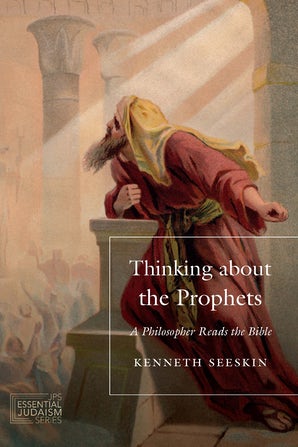
Thinking About the Prophets : A Philosopher Reads the Bible Kenneth Seeskin (Series: JPS Essential Judaism)
Rethinking the great literary prophets whose ministry ran from the eighth to the sixth centuries BCE—Amos, Hosea, First Isaiah, Jeremiah, Ezekiel, Second Isaiah, and Job—Thinking about the Prophets examines their often-shocking teachings in light of their times, their influence on later Western and Jewish thinkers, and their enduring lessons for all of us. As a noted scholar of Jewish philosophy, Kenneth Seeskin teases out philosophical, ethical, and theological questions in the writings, such as the nature of moral reasoning, the divine persona, divine providence, the suffering of the innocent, the power of repentance, and what it means to believe in a monotheistic conception of God.
Seeskin demonstrates that great ideas are not limited by time or place, but rather once put forth, take on a life of their own. Thus he interweaves the medieval and modern philosophers Maimonides, Kant, Cohen, Buber, Levinas, Heschel, and Soloveitchik, all of whom read the prophets and had important things to say as a result. We come to see the prophets perhaps in equal measure as divinely authorized whistle-blowers and profound thinkers of the human condition.
Readers of all levels will find this volume an accessible and provoking introduction to the enduring significance of biblical prophecy.
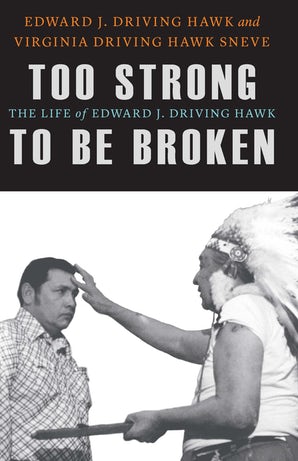
Too Strong To Be Broken : The Life of Edward J. Driving Hawk Edward J. Driving Hawk and Virginia Driving Hawk Sneve (Series: American Indian Lives)
Too Strong to Be Broken explores the dynamic life of Edward J. Driving Hawk, a Vietnam and Korean War veteran, chairman of the Rosebud Sioux Tribe, former president of the National Congress of American Indians, husband, father, recovered alcoholic, and convicted felon.
Driving Hawk’s story begins with his childhood on the rural plains of South Dakota, then follows him as he travels back and forth to Asia for two wars and journeys across the Midwest and Southwest. In his positions of leadership back in the United States, Driving Hawk acted in the best interest of his community, even when sparring with South Dakota governor Bill Janklow and the FBI.
After retiring from public service, he started a construction business and helped create the United States Reservation Bank and Trust. Unfortunately, a key participant in the bank embezzled millions and fled, leaving Driving Hawk to take the blame. Rather than plead guilty to a crime he did not commit, the seventy-four-year-old grandfather went to prison for a year and a day, even as he suffered the debilitating effects of Agent Orange.
Driving Hawk fully believes that the spirits of his departed ancestors watched out for him during his twenty-year career in the U.S. Air Force, including his exposure to Agent Orange, and throughout his life as he survived surgeries, strokes, a tornado, a plane crash, and alcoholism. With the help of his sister, Virginia Driving Hawk Sneve, Driving Hawk recounts his life’s story alongside his wife, Carmen, and their five children.

Wildlife of Nebraska : A Natural History Paul A. Johnsgard
In Wildlife of Nebraska: A Natural History, Paul A. Johnsgard surveys the variety and biology of more than six hundred Nebraska species. Narrative accounts describe the ecology and biology of the state’s birds, its mammals, and its reptiles and amphibians, summarizing the abundance, distributions, and habitats of this wildlife. To provide an introduction to the state’s major ecosystems, climate, and topography, Johnsgard examines major public-access natural areas, including national monuments, wildlife refuges and grasslands, state parks and wildlife management areas, and nature preserves.
Including more than thirty-five line drawings by the author along with physiographic, ecological, and historical maps, Wildlife of Nebraska is an essential guide to the wildlife of the Cornhusker State.
**
All book covers and synopses courtesy of University of Nebraska Press (https://www.nebraskapress.unl.edu/)
Book Briefs: New University of Nebraska Press Books at the Nebraska Publications Clearinghouse

The Nebraska Publications Clearinghouse receives documents every month from all Nebraska state agencies, including the University of Nebraska Press (UNP). Each month we will be showcasing the UNP books that the Clearinghouse receives. UNP books, as well as all Nebraska state documents, are available for checkout by libraries and librarians for their patrons.
Here are the UNP books the Clearinghouse received in July and August 2020:
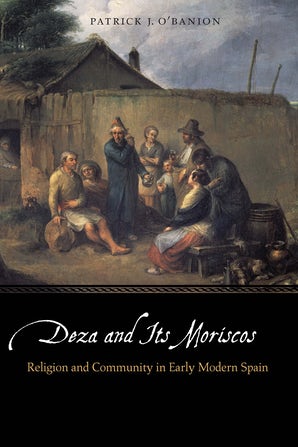
DEZA AND ITS MORISCOS : RELIGION AND COMMUNITY IN EARLY MODERN SPAIN. Patrick J. O’Banion (Series: Early Modern Cultural Studies)
Deza and Its Moriscos addresses an incongruity in early modern Spanish historiography: a growing awareness of the importance played by Moriscos in Spanish society and culture alongside a dearth of knowledge about individuals or local communities. By reassessing key elements in the religious and social history of early modern Spain through the experience of the small Castilian town of Deza, Patrick J. O’Banion asserts the importance of local history in understanding large-scale historical events and challenges scholars to rethink how marginalized people of the past exerted their agency.
Moriscos, baptized Muslims and their descendants, were pressured to convert to Christianity at the end of the Middle Ages but their mass baptisms led to fears about lingering crypto-Islamic activities. Many political and religious authorities, and many of the Moriscos’ neighbors as well, concluded that the conversions had produced false Christians. Between 1609 and 1614 nearly all of Spain’s Moriscos—some three hundred thousand individuals—were thus expelled from their homeland.
Contrary to the assumptions of many modern scholars, rich source materials show the town’s Morisco minority wielded remarkable social, economic, and political power. Drawing deeply on a diverse collection of archival material as well as early printed works, this study illuminates internal conflicts, external pressures brought to bear by the Inquisition, the episcopacy, and the crown, and the possibilities and limitations of negotiated communal life at the dawn of modernity.
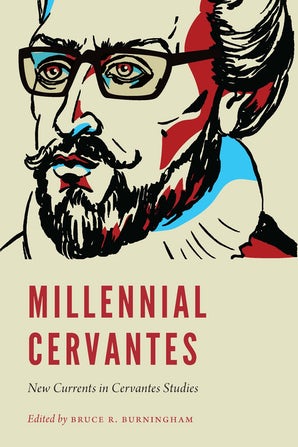
Millennial Cervantes : New Currents in Cervantes Studies Edited by Bruce R. Burningham (Series: New Hispanisms)
Millennial Cervantes explores some of the most important recent trends in Cervantes scholarship in the twenty-first century. It brings together leading Cervantes scholars of the United States in order to showcase their cutting-edge work within a cultural studies frame that encompasses everything from ekphrasis to philosophy, from sexuality to Cold War political satire, and from the culinary arts to the digital humanities.
Millennial Cervantes is divided into three sets of essays—conceptually organized around thematic and methodological lines that move outward in a series of concentric circles. The first group, focused on the concept of “Cervantes in his original contexts,” features essays that bring new insights to these texts within the primary context of early modern Iberian culture. The second group, focused on the concept of “Cervantes in comparative contexts,” features essays that examine Cervantes’s works in conjunction with those of the English-speaking world, both seventeenth- and twentieth-century. The third group, focused on the concept of “Cervantes in wider cultural contexts,” examines Cervantes’s works—principally Don Quixote—as points of departure for other cultural products and wider intellectual debates.
This collection articulates the state of Cervantes studies in the first two decades of the new millennium as we move further into a century that promises both unimagined technological advances and the concomitant cultural changes that will naturally adhere to this new technology, whatever it may be.
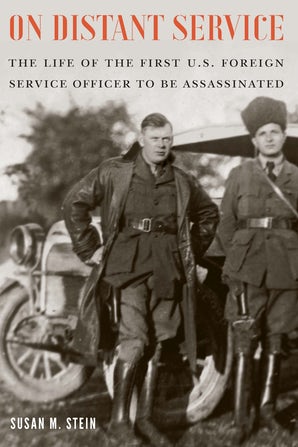
ON DISTANT SERVICE : THE LIFE OF THE FIRST U.S. FOREIGN SERVICE OFFICER TO BE ASSASSINATED. Susan M. Stein
On July 18, 1924, a mob in Tehran killed U.S. foreign service officer Robert Whitney Imbrie. His violent death, the first political murder in the history of the service, outraged the American people. Though Imbrie’s loss briefly made him a cause célèbre, subsequent events quickly obscured his extraordinary life and career.
Susan M. Stein tells the story of a figure steeped in adventure and history. Imbrie rejected a legal career to volunteer as an ambulance driver during World War I and joined the State Department when the United States entered the war. Assigned to Russia, he witnessed the October Revolution, fled ahead of a Bolshevik arrest order, and continued to track communist activity in Turkey even as the country’s war of independence unfolded around him. His fateful assignment to Persia led to his death at age forty-one and set off political repercussions that cloud relations between the United States and Iran to this day.
Drawing on a wealth of untapped materials, On Distant Service returns readers to an era when dash and diplomacy went hand-in-hand.
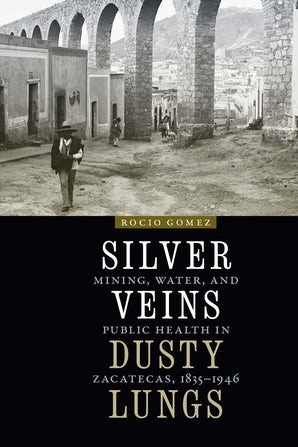
SILVER VEIN, DUSTY LUNGS : MONING, WATER, AND PUBLIC HEALTH IN ZACATECAS, 1835-1946. Rocio Gomez (Series: The Mexican Experience)
In Mexico environmental struggles have been fought since the nineteenth century in such places as Zacatecas, where United States and European mining interests have come into open conflict with rural and city residents over water access, environmental health concerns, and disease compensation.
In Silver Veins, Dusty Lungs, Rocio Gomez examines the detrimental effects of the silver mining industry on water resources and public health in the city of Zacatecas and argues that the human labor necessary to the mining industry made the worker and the mine inseparable through the land, water, and air. Tensions arose between farmers and the mining industry over water access while the city struggled with mudslides, droughts, and water source contamination. Silicosis-tuberculosis, along with accidents caused by mining technologies like jackhammers and ore-crushers, debilitated scores of miners. By emphasizing the perspective of water and public health, Gomez illustrates that the human body and the environment are not separate entities but rather in a state of constant interaction.

Teaching Western American Literature Edited by Brady Harrison and Randi Lynn Tanglen (Series: Postwestern Horizons)
In this volume experienced and new college- and university-level teachers will find practical, adaptable strategies for designing or updating courses in western American literature and western studies. Teaching Western American Literature features the latest developments in western literary research and cultural studies as well as pedagogical best practices in course development. Contributors provide practical models and suggestions for courses and assignments while presenting concrete strategies for teaching works both inside and outside the canon. In addition, Brady Harrison and Randi Lynn Tanglen have assembled insights from pioneering western studies instructors with workable strategies and practical advice for translating this often complex material for classrooms from freshman writing courses to graduate seminars.
Teaching Western American Literature reflects the cutting edge of western American literary study, featuring diverse approaches allied with women’s, gender, queer, environmental, disability, and Indigenous studies and providing instructors with entrée into classrooms of leading scholars in the field.

THINKING ABOUT GOD : JEWISH VIEWS. Rabbi Kari H. Tuling (Series: JPS Essential Judaism)
Who—or what—is God? Is God like a person? Does God have a gender? Does God have a special relationship with the Jewish people? Does God intervene in our lives? Is God good—and, if yes, why does evil persist in the world? In investigating how Jewish thinkers have approached these and other questions, Rabbi Kari H. Tuling elucidates many compelling—and contrasting—ways of thinking about God in Jewish tradition.
Thinking about God addresses the genuinely intertextual nature of evolving Jewish God concepts. Just as in Jewish thought the Bible and other historical texts are living documents, still present and relevant to the conversation unfolding now, and just as a Jewish theologian examining a core concept responds to the full tapestry of Jewish thought on the subject all at once, this book is organized topically, covers Jewish sources (including liturgy) from the biblical to the postmodern era, and highlights the interplay between texts over time, up through our own era.
A highly accessible resource for introductory students, Thinking about God also makes important yet challenging theological texts understandable. By breaking down each selected text into its core components, Tuling helps the reader absorb it both on its own terms and in the context of essential theological questions of the ages. Readers of all backgrounds will discover new ways to contemplate God.
**All book covers and synopses courtesy of University of Nebraska Press (https://www.nebraskapress.unl.edu/)
Book Briefs: New University of Nebraska Press Books at the Nebraska Publications Clearinghouse

The Nebraska Publications Clearinghouse receives documents every month from all Nebraska state agencies, including the University of Nebraska Press (UNP). Each month we will be showcasing the UNP books that the Clearinghouse receives. UNP books, as well as all Nebraska state documents, are available for checkout by libraries and librarians, for their patrons, in Nebraska.
Here are the UNP books the Clearinghouse received in May and June 2020:
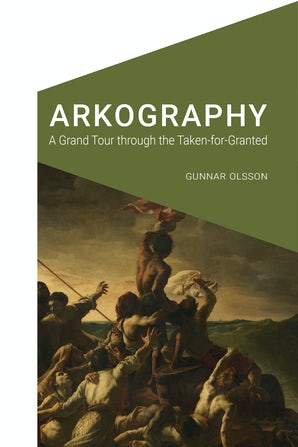
Arkography : A Grand Tour Through the Taken-for-Granted Gunnar Olsson (Series: Cultural Geographies + Rewriting the Earth)
In this fascinating text Gunnar Olsson tells the story of an arkographer, who with Pallas Athene’s blessings, travels down the Red River Valley, navigates the Kantian Island of Truth, and takes a house-tour through the Crystal Palace, the latter edifice an imagination grown out of Gunnael Jensson’s sculpture Mappa Mundi Universalis. This travel story carries the arkographer from the oldest creation epics extant to the power struggles of today—nothing less than a codification of the taken-for-granted, a mapping of the no-man’s-land between the five senses of the body and the sixth sense of culture. By constantly asking how we are made so obedient and predictable, the explorer searches for the present-day counterparts to the biblical ark, the chest that held the commandments and the rules of behavior that came with them—hence the term “arkography,” a word hinting at an as-yet-unrecognized discipline.
In Arkography Olsson strips bare the governing techniques of self-declared authorities, including those of the God of the Old Testament and countless dictators, the latter supported by a horde of lackeys often disguised as elected representatives and governmental functionaries. From beginning to end, Arkography is an illustration of how every creation epic is a variation on the theme of chaos turning into cosmic order. A palimpsest of layered meanings, a play of things and relations, identity and difference. One and many, you and me.
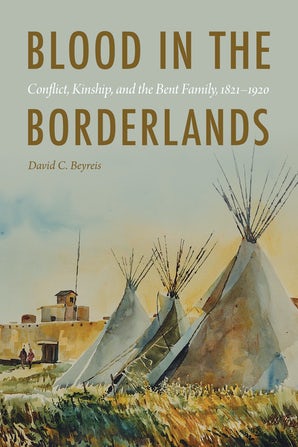
Blood in the Borderlands : Conflict, Kinship, and the Bent Family, 1821-1920 David C. Beyreis
The Bents might be the most famous family in the history of the American West. From the 1820s to 1920 they participated in many of the major events that shaped the Rocky Mountains and Southern Plains. They trapped beaver, navigated the Santa Fe Trail, intermarried with powerful Indian tribes, governed territories, became Indian agents, fought against the U.S. government, acquired land grants, and created historical narratives.
The Bent family’s financial and political success through the mid-nineteenth century derived from the marriages of Bent men to women of influential borderland families—New Mexican and Southern Cheyenne. When mineral discoveries, the Civil War, and railroad construction led to territorial expansions that threatened to overwhelm the West’s oldest inhabitants and their relatives, the Bents took up education, diplomacy, violence, entrepreneurialism, and the writing of history to maintain their status and influence.
In Blood in the Borderlands David C. Beyreis provides an in-depth portrait of how the Bent family creatively adapted in the face of difficult circumstances. He incorporates new material about the women in the family and the “forgotten” Bents and shows how indigenous power shaped the family’s business and political strategies as the family adjusted to American expansion and settler colonist ideologies. The Bent family history is a remarkable story of intercultural cooperation, horrific violence, and pragmatic adaptability in the face of expanding American power.
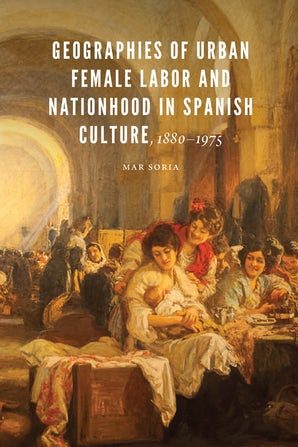
Geographies of Urban Female Labor and Nationhood in Spanish Culture, 1880-1975 Mar Soria (Series: New Hispanisms)
Mar Soria presents an innovative cultural analysis of female workers in Spanish literature and films. Drawing from nation-building theories, the work of feminist geographers, and ideas about the construction of the marginal subject in society, Soria examines how working women were perceived as Other in Spain from 1880 to 1975.
By studying the representation of these marginalized individuals in a diverse array of cultural artifacts, Soria contends that urban women workers symbolized the desires and anxieties of a nation caught between traditional values and rapidly shifting socioeconomic forces. Specifically, the representation of urban female work became a mode of reinforcing and contesting dominant discourses of gender, class, space, and nationhood in critical moments after 1880, when social and economic upheavals resulted in fears of impending national instability. Through these cultural artifacts Spaniards wrestled with the unresolved contradictions in the gender and class ideologies used to construct and maintain the national imaginary.
Whether for reasons of inattention or disregard of issues surrounding class dynamics, nineteenth- and twentieth-century Spanish literary and cultural critics have assumed that working women played only a minimal role in the development of Spain as a modern nation. As a result, relatively few critics have investigated cultural narratives of female labor during this period. Soria demonstrates that without considering the role working women played in the construction and modernization of Spain, our understanding of Spanish culture and life at that time remains incomplete.

Matters of Justice : Pueblos, the Judiciary, and Agrarian Reform in Revolutionary Mexico Helga Baltenmann (Series: The Mexican Experience)
After the fall of the Porfirio Díaz regime, pueblo representatives sent hundreds of petitions to Pres. Francisco I. Madero, demanding that the executive branch of government assume the judiciary’s control over their unresolved lawsuits against landowners, local bosses, and other villages. The Madero administration tried to use existing laws to settle land conflicts but always stopped short of invading judicial authority.
In contrast, the two main agrarian reform programs undertaken in revolutionary Mexico—those implemented by Emiliano Zapata and Venustiano Carranza—subordinated the judiciary to the executive branch and thereby reshaped the postrevolutionary state with the support of villagers, who actively sided with one branch of government over another.
In Matters of Justice Helga Baitenmann offers the first detailed account of the Zapatista and Carrancista agrarian reform programs as they were implemented in practice at the local level and then reconfigured in response to unanticipated inter- and intravillage conflicts. Ultimately, the Zapatista land reform, which sought to redistribute land throughout the country, remained an unfulfilled utopia. In contrast, Carrancista laws, intended to resolve quickly an urgent problem in a time of war, had lasting effects on the legal rights of millions of land beneficiaries and accidentally became the pillar of a program that redistributed about half the national territory.
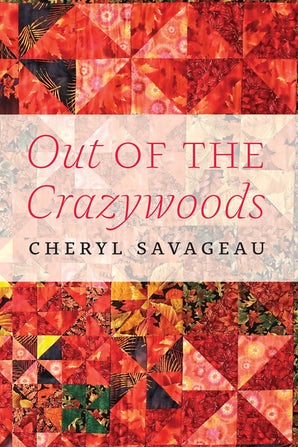
Out of the Crazywoods Cheryl Savageau (Series: American Indian Lives)
Out of the Crazywoods is the riveting and insightful story of Abenaki poet Cheryl Savageau’s late-life diagnosis of bipolar disorder. Without sensationalizing, she takes the reader inside the experience of a rapid-cycling variant of the disorder, providing a lens through which to understand it and a road map for navigating the illness. The structure of her story—impressionistic, fragmented—is an embodiment of the bipolar experience and a way of perceiving the world.
Out of the Crazywoods takes the reader into the euphoria of mania as well as its ugly, agitated rage and into “the lying down of desire” that is depression. Savageau articulates the joy of being consort to a god and the terror of being chased by witchcraft, the sound of voices that are always chattering in your head, the smell of wet ashes that invades your home, the perception that people are moving in slow motion and death lurks at every turnpike, and the feeling of being loved by the universe and despised by everyone you’ve ever known.
Central to the journey out of the Crazywoods is the sensitive child who becomes a poet and writer who finds clarity in her art and a reason to heal in her grandchildren. Her journey reveals the stigma and the social, personal, and economic consequences of the illness but reminds us that the disease is not the person. Grounded in Abenaki culture, Savageau questions cultural definitions of madness and charts a path to recovery through a combination of medications, psychotherapy, and ceremony.
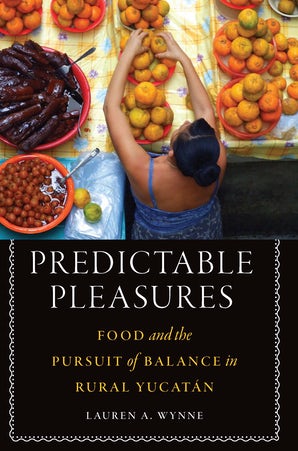
Predictable Pleasures : Food and the Pursuit of Balance In Rural Yucatan Lauren A Wynne (Series: At Table)
The pursuit of balance pervades everyday life in rural Yucatán, Mexico, from the delicate negotiations between a farmer and the neighbor who wants to buy his beans to the careful addition of sour orange juice to a rich plate of eggs fried in lard. Based on intensive fieldwork in one indigenous Yucatecan community, Predictable Pleasures explores the desire for balance in this region and the many ways it manifests in human interactions with food. As shifting social conditions, especially a decline in agriculture and a deepening reliance on regional tourism, transform the manners in which people work and eat, residents of this community grapple with new ways of surviving and finding pleasure.
Lauren A. Wynne examines the convergence of food and balance through deep analysis of what locals describe as acts of care. Drawing together rich ethnographic data on how people produce, exchange, consume, and talk about food, this book posits food as an accessible, pleasurable, and deeply important means by which people in rural Yucatán make clear what matters to them, finding balance in a world that seems increasingly imbalanced.
Unlike many studies of globalization that point to the dissolution of local social bonds and practices, Predictable Pleasures presents an array of enduring values and practices, tracing their longevity to the material constraints of life in rural Yucatán, the deep historical and cosmological significance of food in this region, and the stubborn nature of bodily habits and tastes.
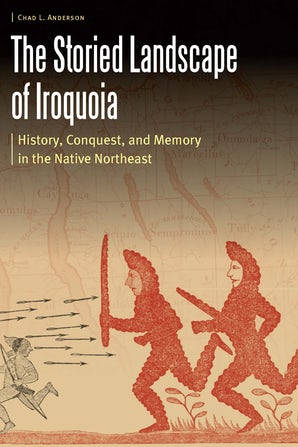
The Storied Landscape of Iroquoia : History, Conquest, and Memory in the Native Northeast Chad L. Anderson (Series: Borderlands and Transcultural Studies)
The Storied Landscape of Iroquoia explores the creation, destruction, appropriation, and enduring legacy of one of early America’s most important places: the homelands of the Haudenosaunees (also known as the Iroquois Six Nations). Throughout the late seventeenth, eighteenth, and early nineteenth centuries of European colonization the Haudenosaunees remained the dominant power in their homelands and one of the most important diplomatic players in the struggle for the continent following European settlement of North America by the Dutch, British, French, Spanish, and Russians. Chad L. Anderson offers a significant contribution to understanding colonialism, intercultural conflict, and intercultural interpretations of the Iroquoian landscape during this time in central and western New York.
Although American public memory often recalls a nation founded along a frontier wilderness, these lands had long been inhabited in Native American villages, where history had been written on the land through place-names, monuments, and long-remembered settlements. Drawing on a wide range of material spanning more than a century, Anderson uncovers the real stories of the people—Native American and Euro-American—and the places at the center of the contested reinvention of a Native American homeland. These stories about Iroquoia were key to both Euro-American and Haudenosaunee understandings of their peoples’ pasts and futures.
For more information about The Storied Landscape of Iroquoia, visit storiedlandscape.com.
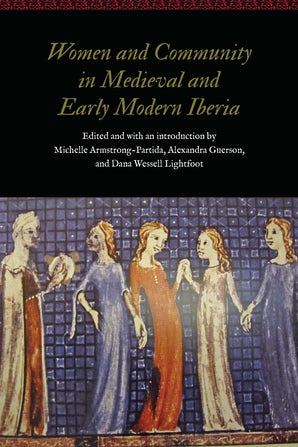
Women and Community in Medieval and Early Modern Iberia Edited and with an introduction by Michelle Armstrong-Partida, Alexandra Guerson, and Dana Wessell Lightfoot ; Series: Women and Gender in the Early Modern World
Women and Community in Medieval and Early Modern Iberia draws on recent research to underscore the various ways Iberian women influenced and contributed to their communities, engaging with a broader academic discussion of women’s agency and cultural impact in the Iberian Peninsula. By focusing on women from across the socioeconomic and religious spectrum—elite, bourgeois, and peasant Christian women, Jewish, Muslim, converso, and Morisco women, and married, widowed, and single women—this volume highlights the diversity of women’s experiences, examining women’s social, economic, political, and religious ties to their families and communities in both urban and rural environments.
Comprised of twelve essays from both established and new scholars, Women and Community in Medieval and Early Modern Iberia showcases groundbreaking work on premodern women, revealing the complex intersections between gender and community while highlighting not only relationships of support and inclusion but also the tensions that worked to marginalize and exclude women.
**All synopses courtesy of University of Nebraska Press (https://www.nebraskapress.unl.edu/)
Book Briefs: New University of Nebraska Press Books at the Nebraska Publications Clearinghouse

The Nebraska Publications Clearinghouse receives documents every month from all Nebraska state agencies, including the University of Nebraska Press (UNP). Each month we will be showcasing the UNP books that the Clearinghouse receives. UNP books, as well as all Nebraska state documents, are available for checkout by libraries and librarians, for their patrons, in Nebraska.
Here are the UNP books the Clearinghouse received in March and April 2020:
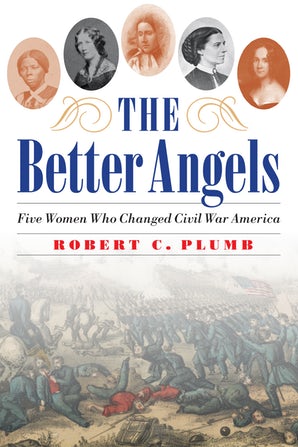
The Better Angels : Five Women Who Changed Civil War America Robert C. Plumb
Harriet Tubman, Harriet Beecher Stowe, Clara Barton, Julia Ward Howe, and Sarah Josepha Hale came from backgrounds that ranged from abject enslavement to New York City’s elite. Surmounting social and political obstacles, they emerged before and during the worst crisis in American history, the Civil War. Their actions became strands in a tapestry of courage, truth, and patriotism that influenced the lives of millions—and illuminated a new way forward for the nation.
In this collective biography, Robert C. Plumb traces these five remarkable women’s awakenings to analyze how their experiences shaped their responses to the challenges, disappointments, and joys they encountered on their missions. Here is Tubman, fearless conductor on the Underground Railroad, alongside Stowe, the author who awakened the nation to the evils of slavery. Barton led an effort to provide medical supplies for field hospitals, and Union soldiers sang Howe’s “Battle Hymn of the Republic” on the march. And, amid national catastrophe, Hale’s campaign to make Thanksgiving a national holiday moved North and South toward reconciliation.

Exodus ‘Gbenga Adeoba (Series: African Poetry Book Series)
Winner of the Sillerman First Book Prize for African Poetry, ‘Gbenga Adeoba’s collection Exodus focuses on forms of migration due to the slave trade, war, natural disasters, and economic opportunities.
Using the sea as a source of language and metaphor, Adeoba explores themes of memory, transition, and the intersections between the historic and the imagined. With great tenderness and power his poetry of empathy searches for meaning in sharply constructed images, creating scenes of making and unmaking while he investigates experiences of exile and displacement across time and place.
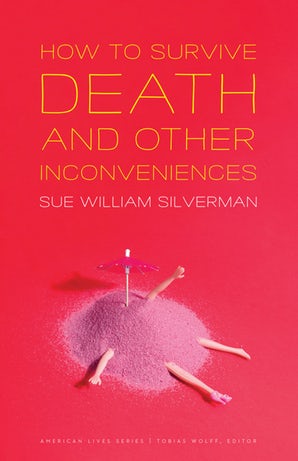
How to Survive Death and Other Inconveniences Sue William Silverman (Series: American Lives)
Many are haunted and obsessed by their own eventual deaths, but perhaps no one as much as Sue William Silverman. This thematically linked collection of essays charts Silverman’s attempt to confront her fears of that ultimate unknown. Her dread was fomented in part by a sexual assault, hidden for years, that led to an awareness that death and sex are in some ways inextricable, an everyday reality many women know too well.
Through gallows humor, vivid realism, and fantastical speculation, How to Survive Death and Other Inconveniences explores this fear of death and the author’s desire to survive it. From cruising New Jersey’s industry-blighted landscape in a gold Plymouth to visiting the emergency room for maladies both real and imagined to suffering the stifling strictness of an intractable piano teacher, Silverman guards her memories for the same reason she resurrects archaic words—to use as talismans to ward off the inevitable. Ultimately, Silverman knows there is no way to survive death physically. Still, through language, commemoration, and metaphor, she searches for a sliver of transcendent immortality.
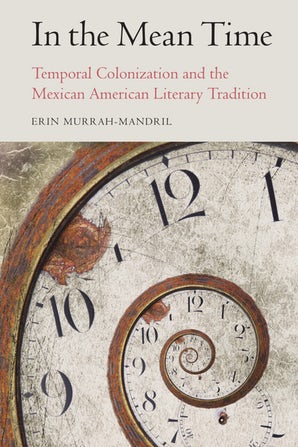
In the Mean Time : Temporal Colonization and the Mexican American Literary Tradition Erin Murrah-Mandril (Series: Postwestern Horizons)
The 1848 Treaty of Guadalupe Hidalgo, which transferred more than a third of Mexico’s territory to the United States, deferred full U.S. citizenship for Mexican Americans but promised, “in the mean time,” to protect their property and liberty. Erin Murrah-Mandril demonstrates that the U.S. government deployed a colonization of time in the Southwest to insure political and economic underdevelopment in the region and to justify excluding Mexican Americans from narratives of U.S. progress. In In the Mean Time, Murrah-Mandril contends that Mexican American authors challenged modern conceptions of empty, homogenous, linear, and progressive time to contest U.S. colonization.
Taking a cue from Latina/o and borderlands spatial theories, Murrah-Mandril argues that time, like space, is a socially constructed, ideologically charged medium of power in the Southwest. In the Mean Time draws on literature, autobiography, political documents, and historical narratives composed between 1870 and 1940 to examine the way U.S. colonization altered time in the borderlands.
Rather than reinforce the colonial time structure, early Mexican American authors exploited the internal contradictions of Manifest Destiny and U.S. progress to resist domination and situate themselves within the shifting political, economic, and historical present. Read as decolonial narratives, the Mexican American cultural productions examined in this book also offer a new way of understanding Latina/o literary history.
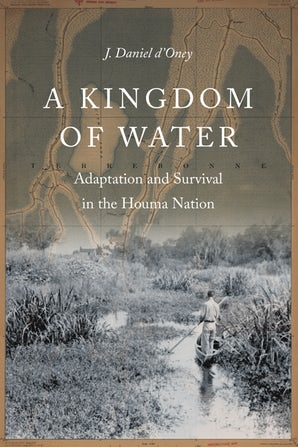
A Kingdom of Water : Adaptation and Survival in the Houma Nation J. Daniel d’Oney (Series: Indians of the Southeast)
A Kingdom of Water is a study of how the United Houma Nation in Louisiana successfully navigated a changing series of political and social landscapes under French, Spanish, British, and American imperial control between 1699 and 2005. After 1699 the Houma assimilated the French into their preexisting social and economic networks and played a vital role in the early history of Louisiana. After 1763 and Gallic retreat, both the British and Spanish laid claim to tribal homelands, and the Houma cleverly played one empire against the other.
In the early 1700s the Houma began a series of adaptive relocations, and just before the Louisiana Purchase in 1803 the nation began their last migration, a journey down Bayou Lafourche. In the early 1800s, as settlers pushed the nation farther down bayous and into the marshes of southeastern Louisiana, the Houma quickly adapted to their new physical environment. After the Civil War and consequent restructuring of class systems, the Houma found themselves caught in a three-tiered system of segregation. Realizing that education was one way to retain lands constantly under assault from trappers and oil companies, the Houma began their first attempt to integrate Terrebonne Parish schools in the early twentieth century, though their situation was not resolved until five decades later. In the early twenty-first century, the tribe is still fighting for federal recognition.
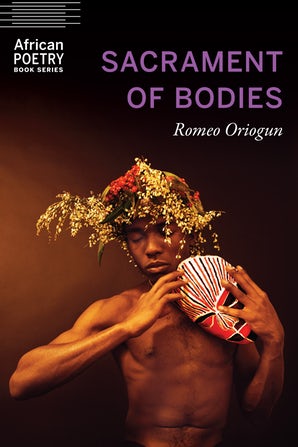
Sacrament of Bodies Romeo Oriogun (Series: African Poetry Book Series)
In this groundbreaking collection of poems, Sacrament of Bodies, Romeo Oriogun fearlessly interrogates how a queer man in Nigeria can heal in a society where everything is designed to prevent such restoration. With honesty, precision, tenderness of detail, and a light touch, Oriogun explores grief and how the body finds survival through migration.
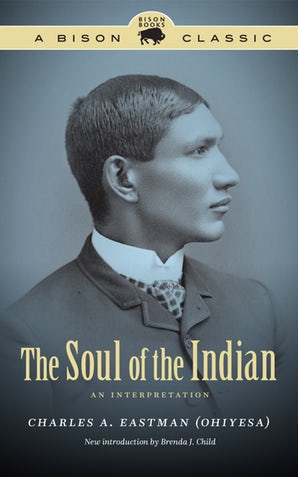
The Soul of the Indian : An Interpretation Charles A. Eastman (Ohiyesa) (Series: Bison Classic Editions)
The Soul of the Indian is Charles A. Eastman’s exploration and documentation of religion as he experienced it during the late nineteenth century. A Dakota physician and writer who sought to bring understanding between Native and non-Native Americans, Eastman (1858–1939) became one of the best-known Native Americans of his time and a significant intellectual figure whose clarity of vision endures today.
In a straightforward manner Eastman emphasizes the universal quality and personal appeal of his Dakota religious heritage. First published in 1911, The Soul of the Indian draws on his childhood teaching and ancestral ideals to counter the research written by outsiders who treated the Dakotas’ ancient worldviews chiefly as a matter of curiosity. Eastman writes with deep respect for his ancestors and their culture and history, including a profound reverence for the environment, animals, and plants. Though written more than a century ago, Eastman could be speaking to our own time with its spiritual confusion and environmental degradation. The new introduction by Brenda J. Child grounds this important book in contemporary studies.
**All synopses courtesy of University of Nebraska Press (https://www.nebraskapress.unl.edu/)
Book Briefs: New University of Nebraska Press Books at the Nebraska Publications Clearinghouse

The Nebraska Publications Clearinghouse receives documents every month from all Nebraska state agencies, including the University of Nebraska Press (UNP). Each month we will be showcasing the UNP books that the Clearinghouse receives. UNP books, as well as all Nebraska state documents, are available for checkout by libraries and librarians, for their patrons, in Nebraska.
Here are the UNP books the Clearinghouse received in February 2020:

Assembling Moral Mobilities : Cycling, Cities, & the Common Good Nicholas A. Scott
In the years since the new mobilities paradigm burst onto the social scientific scene, scholars from various disciplines have analyzed the social, cultural, and political underpinnings of transport, contesting its long-dominant understandings as defined by engineering and economics. Still, the vast majority of mobility studies, and even key works that mention the “good life” and its dependence on the car, fail to consider mobilities in connection with moral theories of the common good.
In Assembling Moral Mobilities Nicholas A. Scott presents novel ways of understanding how cycling and driving animate urban space, place, and society and investigates how cycling can learn from the ways in which driving has become invested with moral value. By jointly analyzing how driving and cycling reassembled the “good city” between 1901 and 2017, with a focus on various cities in Canada, in Detroit, and in Oulu, Finland, Scott confronts the popular notion that cycling and driving are merely antagonistic systems and challenges social-scientific research that elides morality and the common good. Instead of pitting bikes against cars, Assembling Moral Mobilities looks at five moral values based on canonical political philosophies of the common good, and argues that both cycling and driving figure into larger, more important “moral assemblages of mobility,” finally concluding that the deeper meta-lesson that proponents of cycling ought to take from driving is to focus on ecological responsibility, equality, and home at the expense of neoliberal capitalism. Scott offers a fresh perspective of mobilities and the city through a multifaceted investigation of cycling informed by historical lessons of automobility.

Death at the Edges of Empire : Fallen Soldiers, Cultural Memory, and the Making of an American Nation, 1863-1921 Shannon Bontrager (Series: Studies in War, Society, and the Military)
Hundreds of thousands of individuals perished in the epic conflict of the American Civil War. As battles raged and the specter of death and dying hung over the divided nation, the living worked not only to bury their dead but also to commemorate them. President Abraham Lincoln’s Gettysburg Address perhaps best voiced the public yearning to memorialize the war dead. His address marked the beginning of a new tradition of commemorating American soldiers and also signaled a transformation in the relationship between the government and the citizenry through an embedded promise and obligation for the living to remember the dead.
In Death at the Edges of Empire Shannon Bontrager examines the culture of death, burial, and commemoration of American war dead. By focusing on the Civil War, the Spanish-Cuban-American War, the Philippine-American War, and World War I, Bontrager produces a history of collective memories of war expressed through American cultural traditions emerging within broader transatlantic and transpacific networks. Examining the pragmatic collaborations between middle-class Americans and government officials negotiating the contradictory terrain of empire and nation, Death at the Edges of Empire shows how Americans imposed modern order on the inevitability of death as well as how they used the war dead to reimagine political identities and opportunities into imperial ambitions.
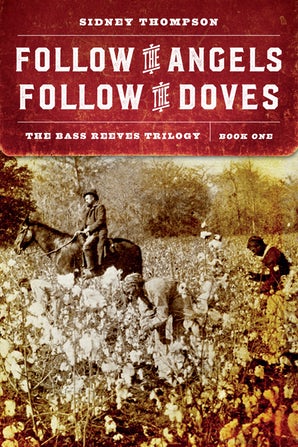
Follow the Angels, Follow the Doves : The Bass Reeves Trilogy, Book One Sidney Thompson (Series: The Bass Reeves Trilogy)
Follow the Angels, Follow the Doves is an origin story in the true American tradition. Before Bass Reeves could stake his claim as the most successful nineteenth-century American lawman, arresting more outlaws than any other deputy during his thirty-two-year career as a deputy U.S. marshal in some of the most dangerous regions of the Wild West, he was a slave.
After a childhood picking cotton, he became an expert marksman under his master’s tutelage, winning shooting contests throughout the region. His skill had serious implications, however, as the Civil War broke out. Reeves was given to his master’s mercurial, sadistic, Moby-Dick-quoting son in the hopes that Reeves would keep him safe in battle. The ensuing humiliation, love, heroics, war, mind games, and fear solidified Reeves’s determination to gain his freedom and drew him one step further on his fated path to an illustrious career.
Follow the Angels, Follow the Doves is an important historical work that places Reeves in the pantheon of American heroes and a thrilling historical novel that narrates a great man’s exploits amid the near-mythic world of the nineteenth-century frontier.

The Grass Shall Grow : Helen Post Photographs the Native American West Mick Gidley
The Grass Shall Grow is a succinct introduction to the work and world of Helen M. Post (1907–79), who took thousands of photographs of Native Americans. Although Post has been largely forgotten and even in her heyday never achieved the fame of her sister, Farm Security Administration photographer Marion Post Wolcott, Helen Post was a talented photographer who worked on Indian reservations throughout the West and captured images that are both striking and informative.
Post produced the pictures for the novelist Oliver La Farge’s nonfiction book As Long As the Grass Shall Grow (1940), among other publications, and her output constitutes a powerful representation of Native American life at that time. Mick Gidley recounts Post’s career, from her coming of age in the turbulent 1930s to her training in Vienna and her work for the U.S. Indian Service, tracking the arc of her professional reputation. He treats her interactions with public figures, including La Farge and editor Edwin Rosskam, and describes her relationships with Native Americans, whether noted craftspeople such as the Sioux quilter Nellie Star Boy Menard, tribal leaders such as Crow superintendent Robert Yellowtail, or ordinary individuals like the people she photographed at work in the fields or laboring for federal projects, at school or in the hospital, cooking or dancing.
The images reproduced here are analyzed both for their own sake and in order to understand their connection to broader national concerns, including the 1934 Indian Reorganization Act. The thoroughly researched and accessibly written text represents a serious reappraisal of a neglected artist.
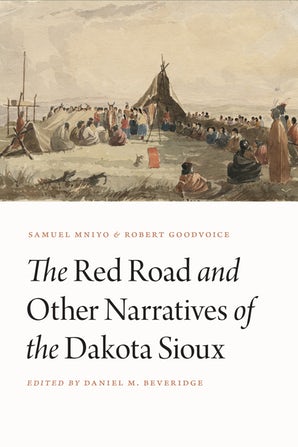
The Red Road and Other Narratives of the Dakota Sioux Samuel Mniyo & Robert Goodvoice; Edited by Daniel M. Beveridge (Series: Studies in the Anthropology of North American Indians)
This book presents two of the most important traditions of the Dakota people, the Red Road and the Holy Dance, as told by Samuel Mniyo and Robert Goodvoice, two Dakota men from the Wahpeton Dakota Nation near Prince Albert, Saskatchewan, Canada. Their accounts of these central spiritual traditions and other aspects of Dakota life and history go back seven generations and help to illuminate the worldview of the Dakota people for the younger generation of Dakotas, also called the Santee Sioux.
“The Good Red Road,” an important symbolic concept in the Holy Dance, means the good way of living or the path of goodness. The Holy Dance (also called the Medicine Dance) is a Dakota ceremony of earlier generations. Although it is no longer practiced, it too was a central part of the tradition and likely the most important ceremonial organization of the Dakotas. While some people believe that the Holy Dance is sacred and that the information regarding its subjects should be allowed to die with the last believers, Mniyo believed that these spiritual ceremonies played a key role in maintaining connections with the spirit world and were important aspects of shaping the identity of the Dakota people.
In The Red Road and Other Narratives of the Dakota Sioux, Daniel Beveridge brings together Mniyo and Goodvoice’s narratives and biographies, as well as songs of the Holy Dance and the pictographic notebooks of James Black (Jim Sapa), to make this volume indispensable for scholars and members of the Dakota community.
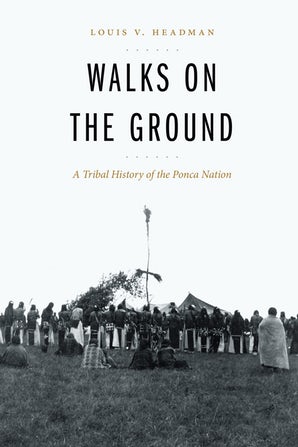
Walks on the Ground : A Tribal History of the Ponca Nation Louis V. Headman
Walks on the Ground is a record of Louis V. Headman’s personal study of the Southern Ponca people, spanning seven decades beginning with the historic notation of the Ponca people’s origins in the East. The last of the true Ponca speakers and storytellers entered Indian Territory in 1877 and most lived into the 1940s.
In Ponca heritage the history of individuals is told and passed along in songs of tribal members. Headman acquired information primarily when singing with known ceremonial singers such as Harry Buffalohead, Ed Littlecook, Oliver Littlecook, Eli Warrior, Dr. Sherman Warrior (son of Sylvester Warrior), Roland No Ear, and “Pee-wee” Clark. Headman’s father, Kenneth Headman, shared most of this history and culture with Louis. During winter nights, after putting a large log into the fireplace, Kenneth would begin his storytelling. The other elders in the tribe confirmed Kenneth’s stories and insights and contributed to the history Louis has written about the Ponca.
Walks on the Ground traces changes in the tribe as reflected in educational processes, the influences and effects of the federal government, and the dominant social structure and culture. Headman includes children’s stories and recognizes the contribution made by Ponca soldiers who served during both world wars, the Korean Conflict, the Vietnam War, Desert Storm, and the ongoing conflict in the Middle East.
**All synopses courtesy of University of Nebraska Press (https://www.nebraskapress.unl.edu/)
Book Briefs: New University of Nebraska Press Books at the Nebraska Publications Clearinghouse

The Nebraska Publications Clearinghouse receives documents every month from all Nebraska state agencies, including the University of Nebraska Press (UNP). Each month we will be showcasing the UNP books that the Clearinghouse receives. UNP books, as well as all Nebraska state documents, are available for checkout by libraries and librarians, for their patrons, in Nebraska.
Here are the UNP books the Clearinghouse received in January 2020:

Chaucer’s losers, Nintento’s Children, and Other Forays in Queer Ludonarratology Tison Pugh (Series: Frontiers of Narrative)
Tison Pugh examines the intersection of narratology, ludology, and queer studies, pointing to the ways in which the blurred boundaries between game and narrative provide both a textual and a metatextual space of queer narrative potential. By focusing on these three distinct yet complementary areas, Pugh shifts understandings of the way their play, pleasure, and narrative potential are interlinked.
Through illustrative readings of an eclectic collection of cultural artifacts—from Chaucer’s Canterbury Tales to Nintendo’s Legend of Zelda franchise, from Edward Albee’s dramatic masterpiece Who’s Afraid of Virginia Woolf? to J. K. Rowling’s Harry Potter fantasy novels—Pugh offers perspectives of blissful ludonarratology, sadomasochistic ludonarratology, the queerness of rules, the queerness of godgames, and the queerness of children’s questing video games. Collectively, these analyses present a range of interpretive strategies for uncovering the disruptive potential of gaming texts and textual games while demonstrating the wide applicability of queer ludonarratology throughout the humanities.
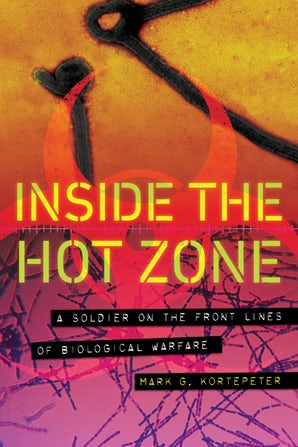
Inside the Hot Zone : A Soldier on the Front Lines of Biological Warfare Mark G. Kortepeter
Inside the Hot Zone is an insider’s account of one of the most dangerous workplaces on earth: the United States Army Medical Research Institute of Infectious Diseases (USAMRIID) in Fort Detrick, Maryland. Retired U.S. Army Col. Mark G. Kortepeter, a leading biodefense expert, recounts his journey from the lecture hall to the role of department chief, to the battlefield, to the Biosafety Level-4 maximum containment lab, and finally, to the corner office.
During Kortepeter’s seven and a half years in leadership at USAMRIID, the United States experienced some of the most serious threats in modern germ warfare, including the specter of biological weapons during the Iraq War, the anthrax letters sent after 9/11, and a little-known crisis involving a presumed botulism attack on the president of the United States. Inside the Hot Zone is a shocking, frightening eye-opener as Kortepeter describes in gripping detail how he and his USAMRIID colleagues navigated threats related to anthrax, botulism, smallpox, Lassa, and Ebola.
Kortepeter crafts a rich and riveting narrative as he wrestles with life-and-death decisions managing biological weapon exposures. The stories are real, but they could just as easily serve as plotlines in popular fiction or Hollywood thrillers. He gives the reader a seat at the table as each crisis unfolds, with an unvarnished and personal perspective on the dangers, the drama, the fear, the frustrations, the irony, and the uncertainty he encountered as a physician in the role of “Biodefender.”
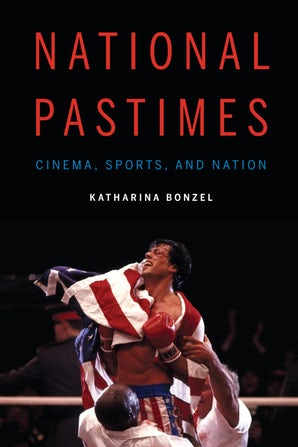
National Pastimes : Cinema, Sports, and Nation Katharina Bonzel (Series: Sports, Media, and Society)
Sports have long fascinated filmmakers from Hollywood and beyond, from Bend It Like Beckham to Chariots of Fire to Rocky. Though sports films are diverse in their approach, style, and storytelling modes, National Pastimes discloses the common emotional and visual cues that belie each sports film’s underlying nationalistic impulses. Katharina Bonzel unravels the delicate matrix of national identity, sports, and emotion through the lens of popular sports films in comparative national contexts, demonstrating in the process how popular culture provides a powerful vehicle for the development and maintenance of identities of place across a range of national cinemas.
As films reflect the ways in which myths of nation and national belonging change over time, they are implicated in important historical moments, from Cold War America to the class dynamics of 1980s Thatcherite Britain to the fragmented sense of nation in post-unification Germany. Bonzel shows how sports films provide a means for renegotiating the boundaries of national identity in an accessible, engaging form. National Pastimes opens up new ways of understanding how films appeal to the emotions, using myth-like constructions of the past to cultivate spectators’ engagement with historical events.
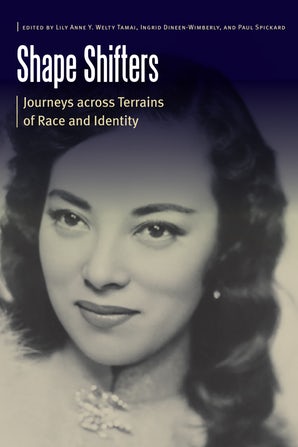
Shape Shifters : Journeys Across Terrains of Race and Identity Edited by Lily Anne Y. Welty Tamai, Ingrid Dineen-Wimberly, and Paul Spickard (Series: Borderlands and Transcultural Studies)
Shape Shifters presents a wide-ranging array of essays that examine peoples of mixed racial identity. Moving beyond the static “either/or” categories of racial identification found within typical insular conversations about mixed-race peoples, Shape Shifters explores these mixed-race identities as fluid, ambiguous, contingent, multiple, and malleable. This volume expands our understandings of how individuals and ethnic groups identify themselves within their own sociohistorical contexts.
The essays in Shape Shifters explore different historical eras and reach across the globe, from the Roman and Chinese borderlands of classical antiquity to medieval Eurasian shape shifters, the Native peoples of the missions of Spanish California, and racial shape shifting among African Americans in the post–civil rights era. At different times in their lives or over generations in their families, racial shape shifters have moved from one social context to another. And as new social contexts were imposed on them, identities have even changed from one group to another. This is not racial, ethnic, or religious imposture. It is simply the way that people’s lives unfold in fluid sociohistorical circumstances.
With contributions by Ryan Abrecht, George J. Sánchez, Laura Moore, and Margaret Hunter, among others, Shape Shifters explores the forces of migration, borderlands, trade, warfare, occupation, colonial imposition, and the creation and dissolution of states and empires to highlight the historically contingent basis of identification among mixed-race peoples across time and space.

Willa Cather and the Arts Edited by Guy J. Renolds (Series: Cather Studies, Vol. 12)
Over the five decades of her writing career Willa Cather responded to, and entered into dialogue with, shifts in the terrain of American life. These cultural encounters informed her work as much as the historical past in which much of her writing is based. Cather was a multifaceted cultural critic, immersing herself in the arts, broadly defined: theater and opera, art, narrative, craft production. Willa Cather and the Arts shows that Cather repeatedly engaged with multiple forms of art, and that even when writing about the past she was often addressing contemporary questions.
The essays in this volume are informed by new modes of contextualization, including the increasingly popular view of Cather as a pivotal or transitional figure working between and across very different cultural periods and by the recent publication of Cather’s correspondence. The collection begins by exploring the ways Cather encountered and represented high and low cultures, including Cather’s use of “racialized vernacular” in Sapphira and the Slave Girl. The next set of essays demonstrates how historical research, often focusing on local features in Cather’s fiction, contributes to our understanding of American culture, from musicological sources to the cultural development of Pittsburgh. The final trio of essays highlights current Cather scholarship, including a food studies approach to O Pioneers! and an examination of Cather’s use of ancient philosophy in The Professor’s House. Together the essays reassess Cather’s lifelong encounter with, and interpretation and reimagining of, the arts.
**All synopses courtesy of University of Nebraska Press (https://www.nebraskapress.unl.edu/)
Book Briefs: New University of Nebraska Press Books at the Nebraska Publications Clearinghouse
 The Nebraska Publications Clearinghouse receives documents every month from all Nebraska state agencies, including the University of Nebraska Press (UNP). Each month we will be showcasing the UNP books that the Clearinghouse receives. UNP books, as well as all Nebraska state documents, are available for checkout by libraries and librarians, for their patrons, in Nebraska.
The Nebraska Publications Clearinghouse receives documents every month from all Nebraska state agencies, including the University of Nebraska Press (UNP). Each month we will be showcasing the UNP books that the Clearinghouse receives. UNP books, as well as all Nebraska state documents, are available for checkout by libraries and librarians, for their patrons, in Nebraska.
Here are the UNP books the Clearinghouse received in November and December 2019:
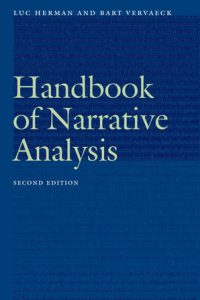 Handbook of Narrative Analysis Luc Herman and Bart Vervaeck (Series: Frontiers of Narrative)
Handbook of Narrative Analysis Luc Herman and Bart Vervaeck (Series: Frontiers of Narrative)
Stories are everywhere, from fiction across media to politics and personal identity. Handbook of Narrative Analysis sorts out both traditional and recent narrative theories, providing the necessary skills to interpret any story. In addition to discussing classical theorists, such as Gérard Genette, Mieke Bal, and Seymour Chatman, Handbook of Narrative Analysis presents precursors (such as E. M. Forster), related theorists (Franz Stanzel, Dorrit Cohn), and a large variety of postclassical critics. Among the latter particular attention is paid to rhetorical, cognitive, and cultural approaches; intermediality; storyworlds; gender theory; and natural and unnatural narratology.
Not content to consider theory as an end in itself, Luc Herman and Bart Vervaeck use two short stories and a graphic narrative by contemporary authors as touchstones to illustrate each approach to narrative. In doing so they illuminate the practical implications of theoretical preferences and the ideological leanings underlying them. Marginal glosses guide the reader through discussions of theoretical issues, and an extensive bibliography points readers to the most current publications in the field. Written in an accessible style, this handbook combines a comprehensive treatment of its subject with a user-friendly format appropriate for specialists and nonspecialists alike.
Handbook of Narrative Analysis is the go-to book for understanding and interpreting narrative. This new edition revises and extends the first edition to describe and apply the last fifteen years of cutting-edge scholarship in the field of narrative theory.
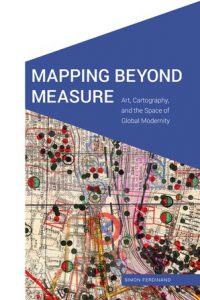 Mapping Beyond Measure : Art, Cartography, and the Space of Global Modernity Simon Ferdinand (Series: Cultural Geographies + Rewriting the Earth)
Mapping Beyond Measure : Art, Cartography, and the Space of Global Modernity Simon Ferdinand (Series: Cultural Geographies + Rewriting the Earth)
Over the last century a growing number of visual artists have been captivated by the entwinements of beauty and power, truth and artifice, and the fantasy and functionality they perceive in geographical mapmaking. This field of “map art” has moved into increasing prominence in recent years yet critical writing on the topic has been largely confined to general overviews of the field.
In Mapping Beyond Measure Simon Ferdinand analyzes diverse map-based works of painting, collage, film, walking performance, and digital drawing made in Britain, Japan, the Netherlands, Ukraine, the United States, and the former Soviet Union, arguing that together they challenge the dominant modern view of the world as a measurable and malleable geometrical space. This challenge has strong political ramifications, for it is on the basis of modernity’s geometrical worldview that states have legislated over social space; that capital has coordinated global markets and exploited distant environments; and that powerful cartographic institutions have claimed exclusive authority in mapmaking.
Mapping Beyond Measure breaks fresh ground in undertaking a series of close readings of significant map artworks in sustained dialogue with spatial theorists, including Peter Sloterdijk, Zygmunt Bauman, and Michel de Certeau. In so doing Ferdinand reveals how map art calls into question some of the central myths and narratives of rupture through which modern space has traditionally been imagined and establishes map art’s distinct value amid broader contemporary shifts toward digital mapping.
 The Mysterious Sofia : One Woman’s Mission to Save Catholicism in Twentieth-Century Mexico Stephen J.C. Andes (Series: The Mexican Experience)
The Mysterious Sofia : One Woman’s Mission to Save Catholicism in Twentieth-Century Mexico Stephen J.C. Andes (Series: The Mexican Experience)
Who was the “Mysterious Sofía,” whose letter in November 1934 was sent from Washington DC to Mexico City and intercepted by the Mexican Secret Service? In The Mysterious Sofía Stephen J. C. Andes uses the remarkable story of Sofía del Valle to tell the history of Catholicism’s global shift from north to south and the importance of women to Catholic survival and change over the course of the twentieth century. As a devout Catholic single woman, neither nun nor mother, del Valle resisted religious persecution in an era of Mexican revolutionary upheaval, became a labor activist in a time of class conflict, founded an educational movement, toured the United States as a public lecturer, and raised money for Catholic ministries—all in an age dominated by economic depression, gender prejudice, and racial discrimination. The rise of the Global South marked a new power dynamic within the Church as Latin America moved from the margins of activism to the vanguard.
Del Valle’s life and the stories of those she met along the way illustrate the shared pious practices, gender norms, and organizational networks that linked activists across national borders. Told through the eyes of a little-known laywoman from Mexico, Andes shows how women journeyed from the pews into the heart of the modern world.
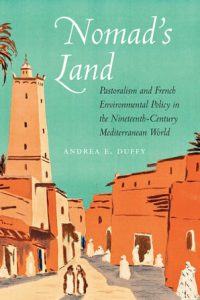 Nomad’s Land : Pastoralism and French Environmental Policy in the Nineteenth-Century Mediterranean World Andrea E. Duffy (Series: France Overseas –Studies in Empire and Decolonization)
Nomad’s Land : Pastoralism and French Environmental Policy in the Nineteenth-Century Mediterranean World Andrea E. Duffy (Series: France Overseas –Studies in Empire and Decolonization)
During the nineteenth century, the development and codification of forest science in France were closely linked to Provence’s time-honored tradition of mobile pastoralism, which formed a major part of the economy. At the beginning of the century, pastoralism also featured prominently in the economies and social traditions of North Africa and southwestern Anatolia until French forest agents implemented ideas and practices for forest management in these areas aimed largely at regulating and marginalizing Mediterranean mobile pastoral traditions. These practices changed not only landscapes but also the social order of these three Mediterranean societies and the nature of French colonial administration.
In Nomad’s Land Andrea E. Duffy investigates the relationship between Mediterranean mobile pastoralism and nineteenth-century French forestry through case studies in Provence, French colonial Algeria, and Ottoman Anatolia. By restricting the use of shared spaces, foresters helped bring the populations of Provence and Algeria under the control of the state, and French scientific forestry became a medium for state initiatives to sedentarize mobile pastoral groups in Anatolia. Locals responded through petitions, arson, violence, compromise, and adaptation. Duffy shows that French efforts to promote scientific forestry both internally and abroad were intimately tied to empire building and paralleled the solidification of Western narratives condemning the pastoral tradition, leading to sometimes tragic outcomes for both the environment and pastoralists.
 Pathologies of Love : Medicine and the Woman Question in Early Modern France Judy Kem (Series: Women and Gender in the Early Modern World)
Pathologies of Love : Medicine and the Woman Question in Early Modern France Judy Kem (Series: Women and Gender in the Early Modern World)
Pathologies of Love examines the role of medicine in the debate on women, known as the querelle des femmes, in early modern France. Questions concerning women’s physical makeup and its psychological and moral consequences played an integral role in the querelle. This debate on the status of women and their role in society began in the fifteenth century and continued through the sixteenth and, as many critics would say, well beyond. In querelle works early modern medicine, women’s sexual difference, literary reception, and gendered language often merge. Literary authors perpetuated medical ideas such as the notion of allegedly fatal lovesickness, and physicians published works that included disquisitions on the moral nature of women.
In Pathologies of Love, Judy Kem looks at the writings of Christine de Pizan, Jean Molinet, Symphorien Champier, Jean Lemaire de Belges, and Marguerite de Navarre, examining the role of received medical ideas in the querelle des femmes. She reconstructs how these authors interpreted the traditional courtly understanding of women’s pity or mercy on a dying lover, their understanding of contemporary debates about women’s supposed sexual insatiability and its biological effects on men’s lives and fertility, and how erotomania or erotic melancholy was understood as a fatal illness. While the two women who frame this study defended women and based much of what they wrote on personal experience, the three men appealed to male authority and tradition in their writings.
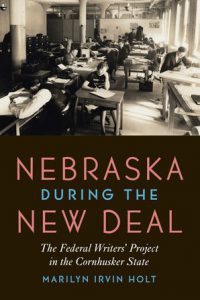 Nebraska During the New Deal : The Federal Writers’ Project in the Cornhusker State Marilyn Irvin Holt
Nebraska During the New Deal : The Federal Writers’ Project in the Cornhusker State Marilyn Irvin Holt
As a New Deal program, the Federal Writers’ Project (FWP) aimed to put unemployed writers, teachers, and librarians to work. The contributors were to collect information, write essays, conduct interviews, and edit material with the goal of producing guidebooks in each of the then forty-eight states and U.S. territories. Project administrators hoped that these guides, known as the American Guide Series, would promote a national appreciation for America’s history, culture, and diversity and preserve democracy at a time when militarism was on the rise and parts of the world were dominated by fascism.
Marilyn Irvin Holt focuses on the Nebraska project, which was one of the most prolific branches of the national program. Best remembered for its state guide and series of folklore and pioneer pamphlets, the project also produced town guides, published a volume on African Americans in Nebraska, and created an ethnic study of Italians in Omaha. In Nebraska during the New Deal Holt examines Nebraska’s contribution to the project, both in terms of its place within the national FWP as well as its operation in comparison to other state projects.
 Xurt’an : The End of the World and Other Myths, Songs, Charms, and Chants by the Northern Lacandones of Naha’ Suzanne Cook (Series: Native Literatures of the Americas and Indigenous World Literatures)
Xurt’an : The End of the World and Other Myths, Songs, Charms, and Chants by the Northern Lacandones of Naha’ Suzanne Cook (Series: Native Literatures of the Americas and Indigenous World Literatures)
Xurt’an (the end of the world) showcases the rich storytelling traditions of the northern Lacandones of Naha’ through a collection of traditional narratives, songs, and ritual speech. Formerly isolated in the dense, tropical rainforest of Chiapas, Mexico, the Lacandon Maya constitute one of the smallest language groups in the world. Although their language remains active and alive, their traditional culture was abandoned after the death of their religious and civic leader in 1996. Lacking the traditional contexts in which the culture was transmitted, the oral traditions are quickly being forgotten.
This collection includes creation myths that describe the cycle of destruction and renewal of the world, the structure of the universe, the realms of the gods and their intercessions in the affairs of their mortals, and the journey of the souls after death. Other traditional stories are non-mythic and fictive accounts involving talking animals, supernatural beings, and malevolent beings that stalk and devour hapless victims. In addition to traditional narratives, Xurt’an presents many songs that are claimed to have been received from the Lord of Maize, magical charms that invoke the forces of the natural world, invocations to the gods to heal and protect, and work songs of Lacandon women, whose contribution to Lacandon culture has been hitherto overlooked by scholars. Women’s songs offer a rare glimpse into the other half of Lacandon society and the arduous distaff work that sustained the religion. The compilation concludes with descriptions of rainbows, the Milky Way as “the white road of Our Lord,” and an account of the solstices.
Transcribed and translated by a foremost linguist of the northern Lacandon language, the literary traditions of the Lacandones are finally accessible to English readers. The result is a masterful and authoritative collection of oral literature that will both entertain and provoke, while vividly testifying to the power of Lacandon Maya aesthetic expression.
**All synopses courtesy of University of Nebraska Press (https://www.nebraskapress.unl.edu/)
Book Briefs: New University of Nebraska Press Books at the Nebraska Publications Clearinghouse
 The Nebraska Publications Clearinghouse receives documents every month from all Nebraska state agencies, including the University of Nebraska Press (UNP). Each month we will be showcasing the UNP books that the Clearinghouse receives. UNP books, as well as all Nebraska state documents, are available for checkout by libraries and librarians, for their patrons, in Nebraska.
The Nebraska Publications Clearinghouse receives documents every month from all Nebraska state agencies, including the University of Nebraska Press (UNP). Each month we will be showcasing the UNP books that the Clearinghouse receives. UNP books, as well as all Nebraska state documents, are available for checkout by libraries and librarians, for their patrons, in Nebraska.
Here are the UNP books the Clearinghouse received in October:
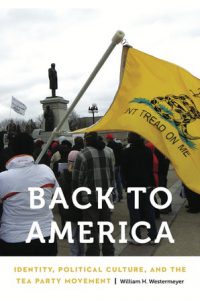 Back to America : Identity, Political Culture, and the Tea Party Movement William H. Westermeyer (Series: Anthropology of Contemporary North America)
Back to America : Identity, Political Culture, and the Tea Party Movement William H. Westermeyer (Series: Anthropology of Contemporary North America)
Back to America is an ethnography of local activist groups within the Tea Party, one of the most important recent political movements to emerge in the United States and one that continues to influence American politics. Though often viewed as the brainchild of conservative billionaires and Fox News, the success of the Tea Party movement was as much, if not more, the result of everyday activists at the grassroots level. William H. Westermeyer traces how local Tea Party groups (LTPGs) create submerged spaces where participants fashion action-oriented collective and personal political identities forged in the context of cultural or figured worlds. These figured worlds allow people to establish meaningful links between their own lives and concerns, on the one hand, and the movement’s goals and narratives, on the other. Collectively, the production and circulation of the figured worlds within LTPGs provide the basis for subjectivities that often nurture political activism.
Westermeyer reveals that LTPGs are vibrant and independent local organizations that, while constantly drawing on nationally disseminated cultural images and discourses, are far from simple agents of the larger organizations and the media. Back to America offers a welcome anthropological approach to this important social movement and to our understanding of grassroots political activism writ large.
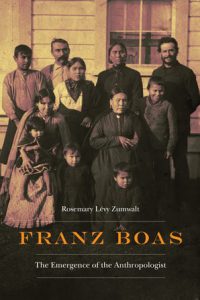 Franz Boas : The Emergence of the Anthropologist Rosemary Levy Zumwalt (Series: Critical Studies in the History of Anthropology)
Franz Boas : The Emergence of the Anthropologist Rosemary Levy Zumwalt (Series: Critical Studies in the History of Anthropology)
Rosemary Lévy Zumwalt tells the remarkable story of Franz Boas, one of the leading scholars and public intellectuals of the late nineteenth and early twentieth centuries. The first book in a two-part biography, Franz Boas begins with the anthropologist’s birth in Minden, Germany, in 1858 and ends with his resignation from the American Museum of Natural History in 1906, while also examining his role in training professional anthropologists from his berth at Columbia University in New York City.
Zumwalt follows the stepping-stones that led Boas to his vision of anthropology as a four-field discipline, a journey demonstrating especially his tenacity to succeed, the passions that animated his life, and the toll that the professional struggle took on him. Zumwalt guides the reader through Boas’s childhood and university education, describes his joy at finding the great love of his life, Marie Krackowizer, traces his 1883 trip to Baffin Land, and recounts his efforts to find employment in the United States. A central interest in the book is Boas’s widely influential publications on cultural relativism and issues of race, particularly his book The Mind of Primitive Man (1911), which reshaped anthropology, the social sciences, and public debates about the problem of racism in American society.
Franz Boas presents the remarkable life story of an American intellectual giant as told in his own words through his unpublished letters, diaries, and field notes. Zumwalt weaves together the strands of the personal and the professional to reveal Boas’s love for his family and for the discipline of anthropology as he shaped it.
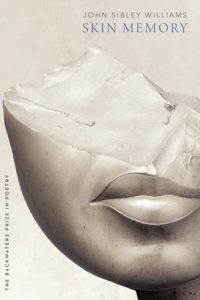 Skin Memory John Sibley Williams (Series: Backwaters Prize in Poetry)
Skin Memory John Sibley Williams (Series: Backwaters Prize in Poetry)
A stark, visceral collection of free verse and prose poetry, Skin Memory scours a wild landscape haunted by personal tragedy and the cruel consequences of human acts in search of tenderness and regeneration. In this book of daring and introspection, John Sibley Williams considers the capriciousness of youth, the terrifying loss of cultural identity and self-identity, and what it means to live in an imperfect world. He reveals each body as made up of all bodies, histories, and shared dreams of the future.
In these poems absence can be held, the body’s dust is just dust, and though childhood is but a poorly edited memory and even our well-intentioned gestures tend toward ruin, Williams nonetheless says, “I’m pretty sure, everything within us says something beautiful.”
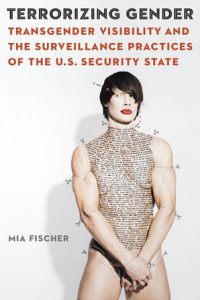 Terrorizing Gender : Transgender Visibility and the Surveillance Practices of the U.S. Security States Mia Fischer (Series: Expanding Frontiers: Interdisciplinary Approaches to Studies of Women, Gender, and Sexuality)
Terrorizing Gender : Transgender Visibility and the Surveillance Practices of the U.S. Security States Mia Fischer (Series: Expanding Frontiers: Interdisciplinary Approaches to Studies of Women, Gender, and Sexuality)
The increased visibility of transgender people in mainstream media, exemplified by Time magazine’s declaration that 2014 marked a “transgender tipping point,” was widely believed to signal a civil rights breakthrough for trans communities in the United States. In Terrorizing Gender Mia Fischer challenges this narrative of progress, bringing together transgender, queer, critical race, legal, surveillance, and media studies to analyze the cases of Chelsea Manning, CeCe McDonald, and Monica Jones. Tracing how media and state actors collude in the violent disciplining of these trans women, Fischer exposes the traps of visibility by illustrating that dominant representations of trans people as deceptive, deviant, and threatening are integral to justifying, normalizing, and reinforcing the state-sanctioned violence enacted against them.
The heightened visibility of transgender people, Fischer argues, has actually occasioned a conservative backlash characterized by the increased surveillance of trans people by the security state, evident in debates over bathroom access laws, the trans military ban, and the rescission of federal protections for transgender students and workers. Terrorizing Gender concludes that the current moment of trans visibility constitutes a contingent cultural and national belonging, given the gendered and racialized violence that the state continues to enact against trans communities, particularly those of color.
**All synopses courtesy of University of Nebraska Press (https://www.nebraskapress.unl.edu/)
Book Briefs: New University of Nebraska Press Books at the Nebraska Publications Clearinghouse
 The Nebraska Publications Clearinghouse receives documents every month from all Nebraska state agencies, including the University of Nebraska Press (UNP). Each month we will be showcasing the UNP books that the Clearinghouse receives. UNP books, as well as all Nebraska state documents, are available for checkout by libraries and librarians, for their patrons, in Nebraska.
The Nebraska Publications Clearinghouse receives documents every month from all Nebraska state agencies, including the University of Nebraska Press (UNP). Each month we will be showcasing the UNP books that the Clearinghouse receives. UNP books, as well as all Nebraska state documents, are available for checkout by libraries and librarians, for their patrons, in Nebraska.
Here are the UNP books the Clearinghouse received in September:
 An Army in Crisis : Social Conflict and the U.. Army in Germany, 1968-1975 Alexander Vazansky
An Army in Crisis : Social Conflict and the U.. Army in Germany, 1968-1975 Alexander Vazansky
Following the decision to maintain 250,000 U.S. troops in Germany after the Allied victory in 1945, the U.S. Army had, for the most part, been a model of what a peacetime occupying army stationed in an ally’s country should be. The army had initially benefited from the positive results of U.S. foreign policy toward West Germany and the deference of the Federal Republic toward it, establishing cordial and even friendly relations with German society. By 1968, however, the disciplined military of the Allies had been replaced with rundown barracks and shabby-looking GIs, and U.S. bases in Germany had become a symbol of the army’s greatest crisis, a crisis that threatened the army’s very existence.
In An Army in Crisis Alexander Vazansky analyzes the social crisis that developed among the U.S. Army forces stationed in Germany between 1968 and 1975. This crisis was the result of shifting deployment patterns across the world during the Vietnam War; changing social and political realities of life in postwar Germany and Europe; and racial tensions, drug use, dissent, and insubordination within the U.S. Army itself, influenced by the civil rights movement, the Vietnam War, and the youth movement in the States. With particular attention to 1968, An Army in Crisis examines the changing relationships between American and German soldiers, from German deference to familiarity and fraternization, and the effects that a prolonged military presence in Germany had on American military personnel, their dependents, and the lives of Germans. Vazansky presents an innovative study of opposition and resistance within the ranks, affected by the Vietnam War and the limitations of personal freedom among the military during this era.
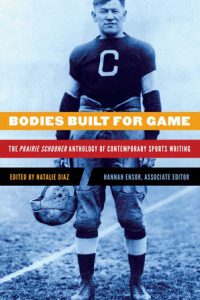 Bodies Built for Game : The Prairie Schooner Anthology of Contemporary Sports Writing Edited by Natalie Diaz; Hannah Ensor, Associate Editor
Bodies Built for Game : The Prairie Schooner Anthology of Contemporary Sports Writing Edited by Natalie Diaz; Hannah Ensor, Associate Editor
Sport has always been central to the movements of both the nation-state and the people who resist that nation-state. Think of the Roman Colosseum, Jesse Owens’s four gold-medal victories in the 1936 Nazi Olympics, Kareem Abdul-Jabbar’s protest at the 1968 Olympics, and the fallout Colin Kaepernick suffered as a result of his recent protest on the sidelines of an NFL game. Sport is a place where the body and the mind are the most dangerous because they are allowed to be unified as one energy.
Bodies Built for Game brings together poems, essays, and stories that challenge our traditional ideas of sport and question the power structures that athletics enforce. What is it that drives us to athletics? What is it that makes us break our own bodies or the bodies of others as we root for these unnatural and performed victories? Featuring contributions from a diverse group of writers, including Hanif Abdurraqib, Fatimah Asghar, Reginald Dwayne Betts, Louise Erdrich, Toni Jensen, Ada Limón, Tommy Orange, Claudia Rankine, Danez Smith, and Maya Washington, this book challenges America by questioning its games.
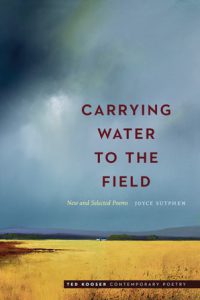 Carrying Water to the Field : New and Selected Poems Joyce Sutphen; Introduction by Ted Kooser (Series: Ted Kooser Contemporary Poetry Series)
Carrying Water to the Field : New and Selected Poems Joyce Sutphen; Introduction by Ted Kooser (Series: Ted Kooser Contemporary Poetry Series)
Joyce Sutphen’s evocations of life on a small farm, coming of age in the late 1960s, and traveling and searching for balance in a very modern world are both deeply personal and familiar. Readers from Maine to Minnesota and beyond will recognize themselves, their parents, aunts and uncles, and neighbors in these poems, which move us from delight in keen description toward something like wisdom or solace in the things of this world.
In addition to poems selected from the last twenty-five years, Carrying Water to the Field includes more than forty new poems on the themes of luck, hard work, and the ravages of time—erasures that Sutphen attempts to ameliorate with her careful attention to language and lyrical precision.
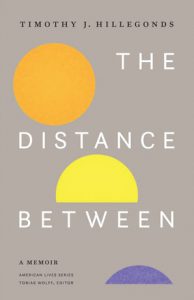 The Distance Between : A Memoir Timothy J. Hillegonds
The Distance Between : A Memoir Timothy J. Hillegonds
At eighteen years old, with no high school diploma, a growing rap sheet, and a failed relationship with his estranged father, Timothy J. Hillegonds took a one-way flight from Chicago to Colorado in hopes of leaving his mounting rage and frustration behind. His plan was simple: snowboard, hang out, live an uncomplicated life.
The Distance Between chronicles how Hillegonds’s plan went awry after he immediately jumped head first into a turbulent relationship with April, a Denny’s coworker and single mother. At once passionate and volatile, their relationship was fueled by vodka, crystal methamphetamine, and poverty—and it sometimes became violent. Mere months after moving to the mountains, when the stakes felt like they couldn’t be higher, Hillegonds learned April was pregnant with his child.
More than just a harrowing story of addiction and abuse or a simple mea culpa, The Distance Between is a finely wrought exploration of, and reckoning with, absent fathers, fatherhood, violence, adolescent rage, white male privilege, and Hillegonds’s own toxic masculinity. With nuance and urgency, The Distance Between takes readers through the grit of life on the margins while grappling with the problematic nature of one man’s existence.
 Edith Wharton, Willa Cather, and the Place of Culture Julie Olin-Ammentorp
Edith Wharton, Willa Cather, and the Place of Culture Julie Olin-Ammentorp
Edith Wharton and Willa Cather wrote many of the most enduring American novels from the first half of the twentieth century, including Wharton’s The House of Mirth, Ethan Frome, and The Age of Innocence, and Cather’s O Pioneers!, My Ántonia, and Death Comes for the Archbishop. Yet despite their perennial popularity and their status as major American novelists, Wharton (1862–1937) and Cather (1873–1947) have rarely been studied together. Indeed, critics and scholars seem to have conspired to keep them at a distance: Wharton is seen as “our literary aristocrat,” an author who chronicles the lives of the East Coast, Europe-bound elite, while Cather is considered a prairie populist who describes the lives of rugged western pioneers. These depictions, though partially valid, nonetheless rely on oversimplifications and neglect the striking and important ways the works of these two authors intersect.
The first comparative study of Edith Wharton and Willa Cather in thirty years, this book combines biographical, historical, and literary analyses with a focus on place and aesthetics to reveal Wharton’s and Cather’s parallel experiences of dislocation, their relationship to each other as writers, and the profound similarities in their theories of fiction. Julie Olin-Ammentorp provides a new assessment of the affinities between Wharton and Cather by exploring the importance of literary and geographic place in their lives and works, including the role of New York City, the American West, France, and travel. In doing so she reveals the two authors’ shared concern about the culture of place and the place of culture in the United States.
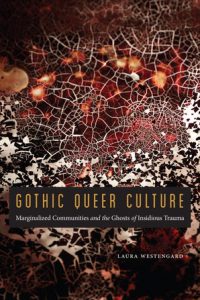 Gothic Queer Culture : Marginalized Communities and the Ghosts of Insidious Trauma Laura Westengard (Series: Expanding Frontiers: Interdisciplinary Approaches to Studies of Women, Gender, and Sexuality)
Gothic Queer Culture : Marginalized Communities and the Ghosts of Insidious Trauma Laura Westengard (Series: Expanding Frontiers: Interdisciplinary Approaches to Studies of Women, Gender, and Sexuality)
In Gothic Queer Culture, Laura Westengard proposes that contemporary U.S. queer culture is gothic at its core. Using interdisciplinary cultural studies to examine the gothicism in queer art, literature, and thought—including ghosts embedded in queer theory, shadowy crypts in lesbian pulp fiction, monstrosity and cannibalism in AIDS poetry, and sadomasochism in queer performance—Westengard argues that during the twentieth and twenty-first centuries a queer culture has emerged that challenges and responds to traumatic marginalization by creating a distinctly gothic aesthetic.
Gothic Queer Culture examines the material effects of marginalization, exclusion, and violence and explains why discourse around the complexities of genders and sexualities repeatedly returns to the gothic. Westengard places this queer knowledge production within a larger framework of gothic queer culture, which inherently includes theoretical texts, art, literature, performance, and popular culture.
By analyzing queer knowledge production alongside other forms of queer culture, Gothic Queer Culture enters into the most current conversations on the state of gender and sexuality, especially debates surrounding negativity, anti-relationalism, assimilation, and neoliberalism. It provides a framework for understanding these debates in the context of a distinctly gothic cultural mode that acknowledges violence and insidious trauma, depathologizes the association between trauma and queerness, and offers a rich counterhegemonic cultural aesthetic through the circulation of gothic tropes.
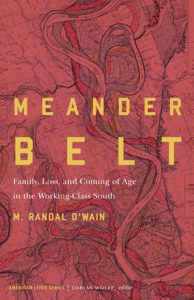 Meander Belt : Family, Loss, and Coming of Age in the Working-Class South M. Randal O’Wain (Series: American Lives)
Meander Belt : Family, Loss, and Coming of Age in the Working-Class South M. Randal O’Wain (Series: American Lives)
In Meander Belt M. Randal O’Wain offers a reflection on how a working-class boy from Memphis, Tennessee, came to fall in love with language, reading, writing, and the larger world outside of the American South. This memoir examines what it means for the son of a carpenter to value mental rather than physical labor and what this does to his relationship with his family, whose livelihood and sensibility are decidedly blue collar. Straining the father-son bond further, O’Wain leaves home to find a life outside Memphis, roaming from place to place, finding odd jobs, and touring with his band. From memory and observation, O’Wain assembles a subtle and spare portrait of his roots, family, and ultimately discovers that his working-class upbringing is not so antithetical to the man he has become.
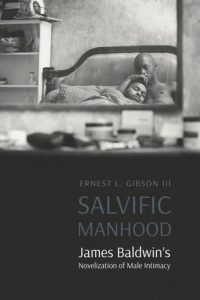 Salvific Manhood : James Baldwin’s Novelization of Male Intimacy Ernest L. Gibson III (Series: Expanding Frontiers: Interdisciplinary Approaches to Studies of Women, Gender, and Sexuality)
Salvific Manhood : James Baldwin’s Novelization of Male Intimacy Ernest L. Gibson III (Series: Expanding Frontiers: Interdisciplinary Approaches to Studies of Women, Gender, and Sexuality)
Salvific Manhood foregrounds the radical power of male intimacy and vulnerability in surveying each of James Baldwin’s six novels. Asserting that manhood and masculinity hold the potential for both tragedy and salvation, Ernest L. Gibson III highlights the complex and difficult emotional choices Baldwin’s men must make within their varied lives, relationships, and experiences. In Salvific Manhood, Gibson offers a new and compelling way to understand the hidden connections between Baldwin’s novels. Thematically daring and theoretically provocative, he presents a queering of salvation, a nuanced approach that views redemption through the lenses of gender and sexuality.
Exploring how fraternal crises develop out of sociopolitical forces and conditions, Salvific Manhood theorizes a spatiality of manhood, where spaces in between men are erased through expressions of intimacy and love. Positioned at the intersections of literary criticism, queer studies, and male studies, Gibson deconstructs Baldwin’s wrestling with familial love, American identity, suicide, art, incarceration, and memory by magnifying the potent idea of salvific manhood. Ultimately, Salvific Manhood calls for an alternate reading of Baldwin’s novels, introducing new theories for understanding the intricacies of African American manhood and American identity, all within a space where the presence of tragedy can give way to the possibility of salvation.
**All synopses courtesy of University of Nebraska Press (https://www.nebraskapress.unl.edu/)
Book Briefs: New University of Nebraska Press Books at the Nebraska Publications Clearinghouse
 The Nebraska Publications Clearinghouse receives documents every month from all Nebraska state agencies, including the University of Nebraska Press (UNP). Each month we will be showcasing the UNP books that the Clearinghouse receives. UNP books, as well as all Nebraska state documents, are available for checkout by libraries and librarians, for their patrons, in Nebraska.
The Nebraska Publications Clearinghouse receives documents every month from all Nebraska state agencies, including the University of Nebraska Press (UNP). Each month we will be showcasing the UNP books that the Clearinghouse receives. UNP books, as well as all Nebraska state documents, are available for checkout by libraries and librarians, for their patrons, in Nebraska.
Here are the UNP books the Clearinghouse received in August:
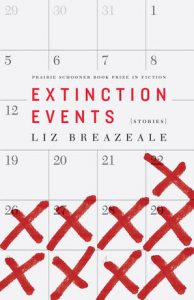 Extinction Events [Stories]
Extinction Events [Stories]
Liz Breazeale (Series: Prairie Schooner Book Prize in Fiction)
In this collection of short stories, Liz Breazeale explores the connections between humans and the natural world by examining the processes and history of our planet. A myriad of extinction events large and small have ruptured the history of the earth, and so it is with the women of this book, who struggle to define themselves amid their own personal cataclysms and those igniting the world around them. They are a mother watching the islands of the world disappear one by one, a new bride using alien abduction to get closer to her estranged parent, a daughter searching for her mother among the lost cities of the world, a sister trying and failing to protect her mythical continent–obsessed brother.
Here extinction events come in all sizes and shapes: as volcanic eruptions and devastating plagues and meteor impacts, as estrangements and betrayals and losses. Dark, angry, and apocalyptic, Extinction Events is a compendium of all the ways in which life can be annihilated.
 Hard Damage
Hard Damage
Aria Aber (Series: Prairie Schooner Book Prize in Poetry)
Hard Damage works to relentlessly interrogate the self and its shortcomings. In lyric and documentary poems and essayistic fragments, Aria Aber explores the historical and personal implications of Afghan American relations. Drawing on material dating back to the 1950s, she considers the consequences of these relations—in particular the funding of the Afghan mujahedeen, which led to the Taliban and modern-day Islamic terrorism—for her family and the world at large.
Invested in and suspicious of the pain of family and the shame of selfhood, the speakers of these richly evocative and musical poems mourn the magnitude of citizenship as a state of place and a state of mind. While Hard Damage is framed by free-verse poetry, the middle sections comprise a lyric essay in fragments and a long documentary poem. Aber explores Rilke in the original German, the urban melancholia of city life, inherited trauma, and displacement on both linguistic and environmental levels, while employing surrealist and eerily domestic imagery.
 Low Mountains or High Tea : Misadventures in Britain’s National Parks
Low Mountains or High Tea : Misadventures in Britain’s National Parks
Steve Sieberson
When Steve Sieberson and his wife unexpectedly found themselves in Britain with an entire summer on their hands, they readily agreed to avoid the usual tourist attractions, opting instead for a road trip to the UK’s far-flung national parks. As they set out, however, he envisioned bracing days of energetic hillwalking, while she assumed they would relax in tearooms and cozy pubs.
Seldom planning more than a few days in advance, the two traversed the country in a rented Vauxhall, subjecting themselves to single-track lanes, diabolical signage, and whimsical advice from locals. They discovered a town called Mirthless, a place where cats’ eyes are removed, and a vibrating cottage, while at mealtimes they dove fearlessly into black pudding, Eton mess, and barely recognizable enchiladas. Meanwhile, after their initial attempts at hiking together nearly ended in disaster, Sieberson received dispensation to scramble alone to the highest point in each national park—as long as he was quick about it and left plenty of time for more sedentary pursuits. Low Mountains or High Tea dishes up the charms and eccentricities of rural Great Britain as seen through the eyes of two Americans who never really knew what was coming next.
 Midwestern Strange : Hunting Monsters, Martians, and the Weird in Flyover Country
Midwestern Strange : Hunting Monsters, Martians, and the Weird in Flyover Country
B.J. Hollars
Midwestern Strange chronicles B.J. Hollars’s exploration of the mythic, lesser-known oddities of flyover country. The mysteries, ranging from bipedal wolf sightings to run-ins with pancake-flipping space aliens to a lumberjack-inspired “Hodag hoax,” make this book a little bit X-Files, a little bit Ghostbusters, and a whole lot of Sherlock Holmes. Hollars’s quest is not to confirm or debunk these mysteries but rather to seek out these unexplained phenomena to understand how they complicate our worldview and to discover what truths might be gleaned by reexamining the facts in our “post-truth” era.
Part memoir and part journalism, Midwestern Strange offers a fascinating, funny, and quirky account of flyover folklore that also contends with the ways such oddities retain cultural footholds. Hollars shows how grappling with such subjects might fortify us against the glut of misinformation now inundating our lives. By confronting monsters, Martians, and a cabinet of curiosities, we challenge ourselves to look beyond our presumptions and acknowledge that just because something is weird, doesn’t mean it is wrong.
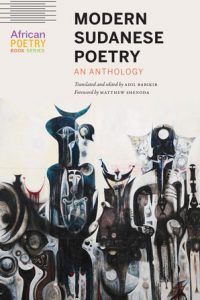 Modern Sudanese Poetry : an Anthology
Modern Sudanese Poetry : an Anthology
Translated and edited by Adil Babiker, Forward by Matthew Shenoda (Series: African Poetry Book Series)
Spanning more than six decades of Sudan’s post-independence history, this collection features work by some of Sudan’s most renowned modern poets, largely unknown in the United States. Adil Babikir’s extensive introduction provides a conceptual framework to help the English reader understand the cultural context. Translated from Arabic, the collection addresses a wide range of themes—identity, love, politics, Sufism, patriotism, war, and philosophy—capturing the evolution of Sudan’s modern history and cultural intersections.
Modern Sudanese Poetry features voices as diverse as the country’s ethnic, cultural, and natural composition. By bringing these voices together, Babikir provides a glimpse of Sudan’s poetry scene as well as the country’s modern history and post-independence trajectory.
 Wilderness of Hope : Fly Fishing and Public Lands in the American West
Wilderness of Hope : Fly Fishing and Public Lands in the American West
Quinn Grover (Series: Outdoor Lives)
Longtime fly fisherman Quinn Grover had contemplated the “why” of his fishing identity before more recently becoming focused on the “how” of it. He realized he was a dedicated fly fisherman in large part because public lands and public waterways in the West made it possible. In Wilderness of Hope Grover recounts his fly-fishing experiences with a strong evocation of place, connecting those experiences to the ongoing national debate over public lands.
Because so much of America’s public lands are in the Intermountain West, this is where arguments about the use and limits of those lands rage the loudest. And those loudest in the debate often become caricatures: rural ranchers who hate the government; West Coast elites who don’t know the West outside Vail, Colorado; and energy and mining companies who extract from once-protected areas. These caricatures obscure the complexity of those who use public lands and what those lands mean to a wider population.
Although for Grover fishing is often an “escape” back to wildness, it is also a way to find a home in nature and recalibrate his interactions with other parts of his life as a father, son, husband, and citizen. Grover sees fly fishing on public waterways as a vehicle for interacting with nature that allows humans to inhabit nature rather than destroy or “preserve” it by keeping it entirely separate from human contact. These essays reflect on personal fishing experiences with a strong evocation of place and an attempt to understand humans’ relationship with water and public land in the American West.
Book Briefs: New University of Nebraska Press Books at the Nebraska Publications Clearinghouse
 The Nebraska Publications Clearinghouse receives documents every month from all Nebraska state agencies, including the University of Nebraska Press (UNP). Each month we will be showcasing the UNP books that the Clearinghouse receives. UNP books, as well as all Nebraska state documents, are available for checkout by libraries and librarians, for their patrons, in Nebraska.
The Nebraska Publications Clearinghouse receives documents every month from all Nebraska state agencies, including the University of Nebraska Press (UNP). Each month we will be showcasing the UNP books that the Clearinghouse receives. UNP books, as well as all Nebraska state documents, are available for checkout by libraries and librarians, for their patrons, in Nebraska.
Here are the UNP books the Clearinghouse received in July:
 Art from Trauma : Genocide and Healing Beyond Rwanda Edited and with an introduction by Rangira Bea Gallimore and Gerise Herndon
Art from Trauma : Genocide and Healing Beyond Rwanda Edited and with an introduction by Rangira Bea Gallimore and Gerise Herndon
What is the role of aesthetic expression in responding to discrimination, tragedy, violence, even genocide? How does gender shape responses to both literal and structural violence, including implicit linguistic, familial, and cultural violence? How might writing or other works of art contribute to healing? Art from Trauma: Genocide and Healing beyond Rwanda explores the possibility of art as therapeutic, capable of implementation by mental health practitioners crafting mental health policy in Rwanda.
This anthology of scholarly, personal, and hybrid essays was inspired by scholar and activist Chantal Kalisa (1965–2015). At the commemoration of the nineteenth anniversary of the genocide in Rwanda, organized by the Rwandan Embassy in Washington DC, Kalisa gave a presentation, “Who Speaks for the Survivors of the Genocide against Tutsi?” Kalisa devoted her energy to giving expression to those whose voices had been distorted or silenced. The essays in this anthology address how the production and experience of visual, dramatic, cinematic, and musical arts, in addition to literary arts, contribute to healing from the trauma of mass violence, offering preliminary responses to questions like Kalisa’s and honoring her by continuing the dialogue in which she participated with such passion, sharing the work of scholars and colleagues in genocide studies, gender studies, and francophone literatures.
Give the Word : Responses to Werner Hamacher’s 95 Theses on Philology Edited by Gerhard Richter and Ann Smock (Series: Stages)
Edited by Gerhard Richter and Ann Smock (Series: Stages)
Werner Hamacher’s witty and elliptical 95 Theses on Philology challenges the humanities—and particularly academic philology—that assume language to be a given entity rather than an event. In Give the Word eleven scholars of literature and philosophy (Susan Bernstein, Michèle Cohen-Halimi, Peter Fenves, Sean Gurd, Daniel Heller-Roazen, Jan Plug, Gerhard Richter, Avital Ronell, Thomas Schestag, Ann Smock, and Vincent van Gerven Oei) take up the challenge presented by Hamacher’s theses. At the close Hamacher responds to them in a spirited text that elaborates on the context of his 95 Theses and its rich theoretical and philosophical ramifications.
The 95 Theses, included in this volume, makes this collection a rich resource for the study and practice of “radical philology.” Hamacher’s philology interrupts and transforms, parting with tradition precisely in order to remain faithful to its radical but increasingly occluded core.
The contributors test Hamacher’s break with philology in a variety of ways, attempting a philological practice that does not take language as an object of knowledge, study, or even love. Thus, in responding to Hamacher’s Theses, the authors approach language that, because it can never be an object of any kind, awakens an unfamiliar desire. Taken together these essays problematize philological ontology in a movement toward radical reconceptualizations of labor, action, and historical time.
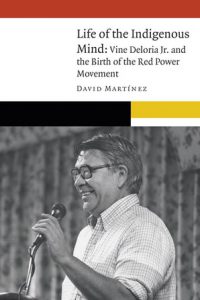 Life of the Indigenous Mind : Vine Deloria Jr. and the Birth of the Red Power Movement David Martinez (Series: New Visions in Native American and Indigenous Studies)
Life of the Indigenous Mind : Vine Deloria Jr. and the Birth of the Red Power Movement David Martinez (Series: New Visions in Native American and Indigenous Studies)
In Life of the Indigenous Mind David Martínez examines the early activism, life, and writings of Vine Deloria Jr. (1933–2005), the most influential indigenous activist and writer of the twentieth century and one of the intellectual architects of the Red Power movement. An experienced activist, administrator, and political analyst, Deloria was motivated to activism and writing by his work as executive director of the National Congress of American Indians, and he came to view discourse on tribal self-determination as the most important objective for making a viable future for tribes.
In this work of both intellectual and activist history, Martínez assesses the early life and legacy of Deloria’s “Red Power Tetralogy,” his most powerful and polemical works: Custer Died for Your Sins (1969), We Talk, You Listen (1970), God Is Red (1973), and Behind the Trail of Broken Treaties (1974). Deloria’s gift for combining sharp political analysis with a cutting sense of humor rattled his adversaries as much as it delighted his growing readership.
Life of the Indigenous Mind reveals how Deloria’s writings addressed Indians and non-Indians alike. It was in the spirit of protest that Deloria famously and infamously confronted the tenets of Christianity, the policies of the Bureau of Indian Affairs, and the theories of anthropology. The concept of tribal self-determination that he initiated both overturned the presumptions of the dominant society, including various “Indian experts,” and asserted that tribes were entitled to the rights of independent sovereign nations in their relationship with the United States, be it legally, politically, culturally, historically, or religiously.
Messianic Fulfillments : Staging Indigenous Salvation in America Hayes Peter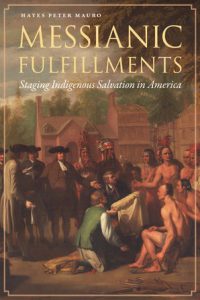 Mauro
Mauro
In Messianic Fulfillments Hayes Peter Mauro examines the role of Christian evangelical movements in shaping American identity in the seventeenth, eighteenth, and nineteenth centuries. Focusing on Christianity’s fervent pursuit of Native American salvation, Mauro discusses Anglo American artists influenced by Christian millenarianism, natural history, and racial science in America. Artists on the colonial, antebellum, and post–Civil War frontier graphically projected their idealization of Christian-based identity onto the bodies of American Indians.
Messianic Fulfillments explores how Puritans, Quakers, Mormons, and members of other Christian millenarian movements viewed Native peoples as childlike, primitive, and in desperate need of Christianization lest they fall into perpetual sin and oblivion and slip into eternal damnation. Christian missionaries were driven by the idea that catastrophic Native American spiritual failure would, in Christ’s eyes, reflect on the shortcomings of those Christians tasked with doing the work of Christian “charity” in the New World.
With an interdisciplinary approach drawing from religious studies and the histories of popular science and art, Messianic Fulfillmentsexplores ethnohistorical encounters in colonial and nineteenth-century America through the lens of artistic works by evangelically inspired Anglo American artists and photographers. Mauro takes a critical look at a variety of visual mediums to illustrate how evangelical imagery influenced definitions of “Americaness,” and how such images reinforced or challenged historically prevailing conceptions of what it means (and looks like) to be American.
 National Races : Transnational Power Struggles in the Sciences and Politics of Human Diversity, 1840-1945 Edited by Richard McMahon (Series: Critical Studies in the History of Anthropology)
National Races : Transnational Power Struggles in the Sciences and Politics of Human Diversity, 1840-1945 Edited by Richard McMahon (Series: Critical Studies in the History of Anthropology)
National Races explores how politics interacted with transnational science in the nineteenth and early twentieth centuries. This interaction produced powerful, racialized national identity discourses whose influence continues to resonate in today’s culture and politics. Ethnologists, anthropologists, and raciologists compared modern physical types with ancient skeletal finds to unearth the deep prehistoric past and true nature of nations. These scientists understood certain physical types to be what Richard McMahon calls “national races,” or the ageless biological essences of nations.
Contributors to this volume address a central tension in anthropological race classification. On one hand, classifiers were nationalists who explicitly or implicitly used race narratives to promote political agendas. Their accounts of prehistoric geopolitics treated “national races” as the proxies of nations in order to legitimize present-day geopolitical positions. On the other hand, the transnational community of race scholars resisted the centrifugal forces of nationalism. Their interdisciplinary project was a vital episode in the development of the social sciences, using biological race classification to explain the history, geography, relationships, and psychologies of nations.
National Races goes to the heart of tensions between nationalism and transnationalism, politics and science, by examining transnational science from the perspective of its peripheries. Contributors to the book supplement the traditional focus of historians on France, Britain, and Germany, with myriad case studies and examples of nineteenth- and early twentieth-century racial and national identities in countries such as Russia, Italy, Poland, Greece, and Yugoslavia, and among Jewish anthropologists.
Place and Postcolonial Ecofeminism : Pakistani Women’s Literary and  Cinematic Fictions Shazia Rahman (Series: Expanding Frontiers : Interdisciplinary Approaches to Studies of Women, Gender, and Sexuality)
Cinematic Fictions Shazia Rahman (Series: Expanding Frontiers : Interdisciplinary Approaches to Studies of Women, Gender, and Sexuality)
While news reports about Pakistan tend to cover Taliban attacks and bombings, and academics focus on security issues, the environment often takes a backseat in media reportage and scholarship. In particular, Pakistani women’s attachment to their environment and their environmental concerns are almost always ignored. Shazia Rahman traces the ways in which Pakistani women explore alternative, environmental modes of belonging, examines the vitality of place-based identities within Pakistani culture, and thereby contributes to evolving understandings of Pakistani women—in relation to both their environment and to various discourses of nation and patriarchy.
Through an astute analysis of such works as Sabiha Sumar’s Khamosh Pani (2003), Mehreen Jabbar’s Ramchand Pakistani (2008), Sorayya Khan’s Noor (2006), Uzma Aslam Khan’s Trespassing (2003), and Kamila Shamsie’s Burnt Shadows (2009), Rahman illuminates how Pakistani women’s creative works portray how people live with one another, deal with their environment, and intuit their relationship with the spiritual. She considers how literary and cinematic documentation of place-based identities simultaneously critiques and counters stereotypes of Pakistan as a country of religious nationalism and oppressive patriarchy. Rahman’s analysis discloses fresh perspectives for thinking about the relationship between social and environmental justice.
 The Virgin of Prince Street : Expeditions into Devotion Sonja Livingston (Series: American Lives)
The Virgin of Prince Street : Expeditions into Devotion Sonja Livingston (Series: American Lives)
With organized religion becoming increasingly divisive and politicized and Americans abandoning their pews in droves, it’s easy to question aspects of traditional spirituality and devotion. In response to this shifting landscape, Sonja Livingston undertakes a variety of expeditions—from a mobile confessional in Cajun Country to a eucharistic procession in Galway, Ireland, to the Death and Marigolds Parade in Albuquerque, New Mexico, and Mass in a county jail on Thanksgiving Day—to better understand devotion in her own life.
The Virgin of Prince Street chronicles her quest, offering an intimate and unusually candid view into Livingston’s relationship with the swiftly changing Catholic Church and into her own changing heart. Ultimately, Livingston’s meditations on quirky rituals and fading traditions thoughtfully and dynamically interrogate traditional elements of sacramental devotion, especially as they relate to concepts of religion, relationships, and the sacred.
Book Briefs: New University of Nebraska Press Books at the Nebraska Publications Clearinghouse
 The Nebraska Publications Clearinghouse receives documents every month from all Nebraska state agencies, including the University of Nebraska Press (UNP). Each month we will be showcasing the UNP books that the Clearinghouse receives. UNP books, as well as all Nebraska state documents, are available for checkout by libraries and librarians, for their patrons, in Nebraska.
The Nebraska Publications Clearinghouse receives documents every month from all Nebraska state agencies, including the University of Nebraska Press (UNP). Each month we will be showcasing the UNP books that the Clearinghouse receives. UNP books, as well as all Nebraska state documents, are available for checkout by libraries and librarians, for their patrons, in Nebraska.
Here are the UNP books the Clearinghouse received in June:
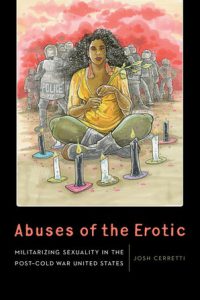 Abuses of the Erotic : Militarizing Sexuality in the Post-Cold War United States Josh Cerretti (Series: Expanding Frontiers–Interdisciplinary Approaches to Studies of Women, Gender, and Sexuality)
Abuses of the Erotic : Militarizing Sexuality in the Post-Cold War United States Josh Cerretti (Series: Expanding Frontiers–Interdisciplinary Approaches to Studies of Women, Gender, and Sexuality)
Events ranging from sexual abuse at Abu Ghraib to the end of “Don’t Ask, Don’t Tell” hint that important issues surrounding gender and sexuality remain at the core of political and cultural problems. Nonetheless, intersectional analyses of militarism that account for questions of race, class, and gender remain exceedingly rare. Abuses of the Erotic fills this gap by offering a comprehensive picture of how military values have permeated the civilian cultural sphere and by investigating connections between sexuality and militarism in the United States since the late 1980s.
Josh Cerretti takes up the urgent task of applying an interdisciplinary, transnational framework to the role of sexuality in promoting, expanding, and sustaining the war on terror to understand the links between what Cerretti calls “domestic militarism” and later projects of state-backed violence and intervention. This work brings together scholarship on domestic and international militarization in relation to both homosexuality and heterosexuality to demonstrate how sexual and gender politics have been deployed to bolster U.S. military policies and, by tracking over a decade of militarized sexuality, how these instances have foundationally changed how we think of sexual and gender politics today.
Apostles of Empire : The Jesuits and New France 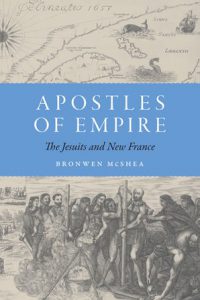 Bronwen McShea (Series: France Overseas–Studies in Empre and Decolonization)
Bronwen McShea (Series: France Overseas–Studies in Empre and Decolonization)
Apostles of Empire is a revisionist history of the French Jesuit mission to indigenous North Americans in the seventeenth and eighteenth centuries, offering a comprehensive view of a transatlantic enterprise in which secular concerns were integral. Between 1611 and 1764, 320 Jesuits were sent from France to North America to serve as missionaries. Most labored in colonial New France, a vast territory comprising eastern Canada and the Great Lakes region that was inhabited by diverse Native American populations. Although committed to spreading Catholic doctrines and rituals and adapting them to diverse indigenous cultures, these missionaries also devoted significant energy to more-worldly concerns, particularly the transatlantic expansion of the absolutist-era Bourbon state and the importation of the culture of elite, urban French society.
In Apostles of Empire Bronwen McShea accounts for these secular dimensions of the mission’s history through candid portraits of Jesuits engaged in a range of secular activities. We see them not only preaching and catechizing in terms that borrowed from indigenous idioms but also cultivating trade and military partnerships between the French and various Indian tribes. Apostles of Empire contributes to ongoing research on the Jesuits, New France, and Atlantic World encounters, as well as on early modern French society, print culture, Catholicism, and imperialism. McShea shows how the Jesuits’ robust conceptions of secular spheres of Christian action informed their efforts from both sides of the Atlantic to build up a French and Catholic empire in North America through significant indigenous cooperation.
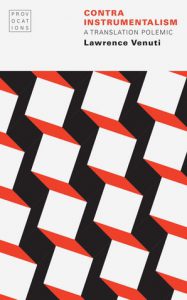
Contra Instrumentalism : a Translation Polemic Lawrence Venuti (Series: Provocations)
Contra Instrumentalism questions the long-accepted notion that translation reproduces or transfers an invariant contained in or caused by the source text. This “instrumental” model of translation has dominated translation theory and commentary for more than two millennia, and its influence can be seen today in elite and popular cultures, in academic institutions and in publishing, in scholarly monographs and in literary journalism, in the most rarefied theoretical discourses and in the most commonly used clichés.
Contra Instrumentalism aims to end the dominance of instrumentalism by showing how it grossly oversimplifies translation practice and fosters an illusion of immediate access to source texts. Lawrence Venuti asserts that all translation is an interpretive act that necessarily entails ethical responsibilities and political commitments. Venuti argues that a hermeneutic model offers a more comprehensive and incisive understanding of translation that enables an appreciation of not only the creative and scholarly aspects of what a translator does but also the crucial role translation plays in the cultural and social institutions that shape human life.
In Defense of Farmers : The Future of Agriculture in the Shadow of Corporate Power Jane W. Gibson and Sara E. Alexander, editors (Series: Our Sustainable Future) 
Industrial agriculture is generally characterized as either the salvation of a growing, hungry, global population or as socially and environmentally irresponsible. Despite elements of truth in this polarization, it fails to focus on the particular vulnerabilities and potentials of industrial agriculture. Both representations obscure individual farmers, their families, their communities, and the risks they face from unpredictable local, national, and global conditions: fluctuating and often volatile production costs and crop prices; extreme weather exacerbated by climate change; complicated and changing farm policies; new production technologies and practices; water availability; inflation and debt; and rural community decline. Yet the future of industrial agriculture depends fundamentally on farmers’ decisions.
In Defense of Farmers illuminates anew the critical role that farmers play in the future of agriculture and examines the social, economic, and environmental vulnerabilities of industrial agriculture, as well as its adaptations and evolution. Contextualizing the conversations about agriculture and rural societies within the disciplines of sociology, geography, economics, and anthropology, this volume addresses specific challenges farmers face in four countries: Bolivia, Brazil, Canada, and the United States.
By concentrating on countries with the most sophisticated production technologies capable of producing the largest quantities of grains, soybeans, and animal proteins in the world, this volume focuses attention on the farmers whose labors, decision-making, and risk-taking throw into relief the implications and limitations of our global industrial food system. The case studies here acknowledge the agency of farmers and offer ways forward in the direction of sustainable agriculture.
 Power Lined : Electricity, Landscape, and the American Mind Daniel L. Wuebben
Power Lined : Electricity, Landscape, and the American Mind Daniel L. Wuebben
The proliferation of electric communication and power networks have drawn wires through American landscapes like vines through untended gardens since 1844. But these wire networks are more than merely the tools and infrastructure required to send electric messages and power between distinct places; the iconic lines themselves send powerful messages. The wiry webs above our heads and the towers rhythmically striding along the horizon symbolize the ambiguous effects of widespread industrialization and the shifting values of electricity and landscape in the American mind.
In Power-Lined Daniel L. Wuebben weaves together personal narrative, historical research, cultural analysis, and social science to provide a sweeping investigation of the varied influence of overhead wires on the American landscape and the American mind. Wuebben shows that overhead wires—from Morse’s telegraph to our high-voltage grid—not only carry electricity between American places but also create electrified spaces that signify and complicate notions of technology, nature, progress, and, most recently, renewable energy infrastructure. Power-Lined exposes the subtle influences wrought by the wiring of the nation and shows that, even in this age of wireless devices, perceptions of overhead lines may be key in progressing toward a more sustainable energy future.
The Supernatural Sublime : The Wondrous Ineffability of the Everyday 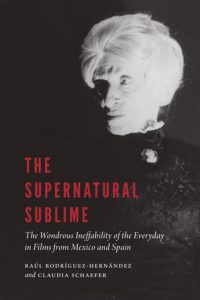 in Films from Mexico and Spain Raul Rodriguez-Hernandez and Claudia Schaefer (Series: New Hispanisms)
in Films from Mexico and Spain Raul Rodriguez-Hernandez and Claudia Schaefer (Series: New Hispanisms)
The Supernatural Sublime explores the long-neglected element of the supernatural in films from Spain and Mexico by focusing on the social and cultural contexts of their production and reception, their adaptations of codes and conventions for characters and plot, and their use of cinematic techniques to create the experience of emotion without explanation. Deploying the overarching concepts of the supernatural and the sublime, Raúl Rodríguez-Hernández and Claudia Schaefer detail the dovetailing of the unnatural and the experience of limitlessness associated with the sublime.
The Supernatural Sublime embeds the films in the social histories of twentieth- and twenty-first-century Mexico and Spain, both of which made a forced leap into modernity after historical periods founded on official ideologies and circumscribed visions of the nation. Evoking Kant’s definition of the experience of the sublime, Rodríguez-Hernández and Schaefer concentrate on the unrepresentable and the contradictory that oppose purported universal truths and instead offer up illusion, deception, and imagination through cinema, itself a type of illusion: writing with light.
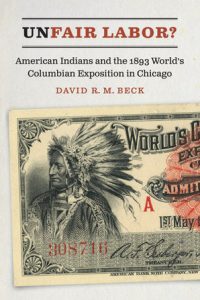 Unfair Labor? : American Indians and the 1893 World’s Columbian Exposition in Chicago David R. M. Beck
Unfair Labor? : American Indians and the 1893 World’s Columbian Exposition in Chicago David R. M. Beck
Unfair Labor? is the first book to explore the economic impact of Native Americans who participated in the 1893 World’s Columbian Exposition held in Chicago. By the late nineteenth century, tribal economic systems across the Americas were decimated, and tribal members were desperate to find ways to support their families and control their own labor. As U.S. federal policies stymied economic development in tribal communities, individual Indians found creative new ways to make a living by participating in the cash economy. Before and during the exposition, American Indians played an astonishingly broad role in both the creation and the collection of materials for the fair, and in a variety of jobs on and off the fairgrounds.
While anthropologists portrayed Indians as a remembrance of the past, the hundreds of Native Americans who participated were carving out new economic pathways. Once the fair opened, Indians from tribes across the United States, as well as other indigenous people, flocked to Chicago. Although they were brought in to serve as displays to fairgoers, they had other motives as well. Once in Chicago they worked to exploit circumstances to their best advantage. Some succeeded; others did not.
Unfair Labor? breaks new ground by telling the stories of individual laborers at the fair, uncovering the roles that Indians played in the changing economic conditions of tribal peoples, and redefining their place in the American socioeconomic landscape.
We Average Unbeautiful Watchers : Fan Narratives and the Reading of 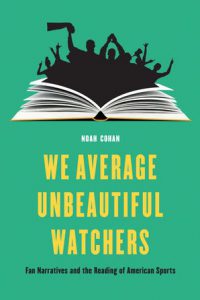 American Sports Noah Cohan (Series: Sports, Media, and Society)
American Sports Noah Cohan (Series: Sports, Media, and Society)
Sports fandom—often more than religious, political, or regional affiliation—determines how millions of Americans define themselves. In We Average Unbeautiful Watchers, Noah Cohan examines contemporary sports culture to show how mass-mediated athletics are in fact richly textured narrative entertainments rather than merely competitive displays. While it may seem that sports narratives are “written” by athletes and journalists, Cohan demonstrates that fans are not passive consumers but rather function as readers and writers who appropriate those narratives and generate their own stories in building their sense of identity.
Critically reading stories of sports fans’ self-definition across genres, from the novel and the memoir to the film and the blog post, We Average Unbeautiful Watchers recovers sports games as sites where fan-authors theorize interpretation, historicity, and narrative itself. Fan stories demonstrate how unscripted sporting entertainments function as identity-building narratives—which, in turn, enhances our understanding of the way we incorporate a broad range of texts into our own life stories.
Building on the work of sports historians, theorists of fan behavior, and critics of American literature, Cohan shows that humanistic methods are urgently needed for developing nuanced critical conversations about athletics. Sports take shape as stories, and it is scholars in the humanities who can best identify how they do so—and why that matters for American culture more broadly.
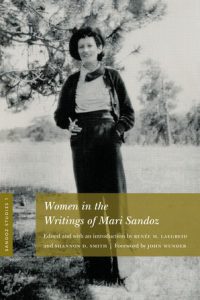 Women in the Writings of Mari Sandoz Edited and with an introduction by Renee M. Laegreid and Shannon D. Smith, Foreword by John Wunder (Series: Sandoz Studies, Volume 1)
Women in the Writings of Mari Sandoz Edited and with an introduction by Renee M. Laegreid and Shannon D. Smith, Foreword by John Wunder (Series: Sandoz Studies, Volume 1)
Mari Sandoz, born on Mirage Flats, south of Hay Springs, Nebraska, on May 11, 1896, was the eldest daughter of Swiss immigrants. She experienced firsthand the difficulties and pleasures of the family’s remote plains existence and early on developed a strong desire to write. Her keen eye for detail combined with meticulous research enabled her to become one of the most valued authorities of her time on the history of the plains and the culture of Native Americans.
Women in the Writings of Mari Sandoz is the first volume of the Sandoz Studies series, a collection of thematically grouped essays that feature writing by and about Mari Sandoz and her work. When Sandoz wrote about the women she knew and studied, she did not shy away from drawing attention to the sacrifices, hardships, and disappointments they endured to forge a life in the harsh plains environment. But she also wrote about moments of joy, friendship, and—for some—a connection to the land that encouraged them to carry on.
The scholarly essays and writings of Sandoz contained in this book help place her work into broader contexts, enriching our understanding of her as an author and as a woman deeply connected to the Sandhills of Nebraska.
Book Briefs: New University of Nebraska Press Books at the Nebraska Publications Clearinghouse

The Nebraska Publications Clearinghouse receives documents every month from all Nebraska state agencies, including the University of Nebraska Press (UNP). Each month we will be showcasing the UNP books that the Clearinghouse receives. UNP books, as well as all Nebraska state documents, are available for checkout by libraries and librarians, for their patrons, in Nebraska.
Here are the UNP books the Clearinghouse received in May:
 Age in Love : Shakespeare and the Elizabethan Court Jacqueline Vanhoutte (Series: Early Modern Cultural Studies)
Age in Love : Shakespeare and the Elizabethan Court Jacqueline Vanhoutte (Series: Early Modern Cultural Studies)
The title Age in Love is taken from Shakespeare’s sonnet 138, a poem about an aging male speaker who, by virtue of his entanglement with the dark lady, “vainly” performs the role of “some untutor’d youth.” Jacqueline Vanhoutte argues that this pattern of “age in love” pervades Shakespeare’s mature works, informing his experiments in all the dramatic genres. Bottom, Malvolio, Claudius, Falstaff, and Antony all share with the sonnet speaker a tendency to flout generational decorum by assuming the role of the lover, normally reserved in Renaissance culture for young men. Hybrids and upstarts, cross-dressers and shape-shifters, comic butts and tragic heroes—Shakespeare’s old-men-in-love turn in boundary-blurring performances that probe the gendered and generational categories by which early modern subjects conceived of identity.
In Age in Love Vanhoutte shows that questions we have come to regard as quintessentially Shakespearean—about the limits of social mobility, the nature of political authority, the transformative powers of the theater, the vagaries of human memory, or the possibility of secular immortality—come to indelible expression through Shakespeare’s artful deployment of the “age in love” trope. Age in Love contributes to the ongoing debate about the emergence of a Tudor public sphere, building on the current interest in premodern constructions of aging and ultimately demonstrating that the Elizabethan court shaped Shakespeare’s plays in unexpected and previously undocumented ways.
Great Plains Weather Kenneth F. Dewey (Series: Discover the Great Plains)
The weather of the Great Plains is extreme and highly variable, from floods to droughts, blizzards to tornadoes. In Great Plains WeatherKenneth F. Dewey explains what makes this region’s climate unique by presenting a historical climatology of extreme weather events. Beginning with tornadoes—perhaps the most formidable plains weather phenomena—he describes the climatology of these storms and discusses memorable tornadoes of the plains. As one of the storm chasers who travels the Great Plains in the spring and summer tracking severe weather, Dewey also shares some of his experiences on the road.
Dewey then goes on to discuss famous blizzards, from the “School Children’s Storm” of 1888 to more recent storms, along with droughts and floods. Precipitation, or the lack thereof, has long determined human activity in the region; exacerbated by the vagaries of climate change, it continues to have a significant economic and cultural impact on the people of the plains. Dewey’s absorbing narrative is complemented by images of tornadoes, snowstorms, and flash floods that he amassed in forty years of climatological research.
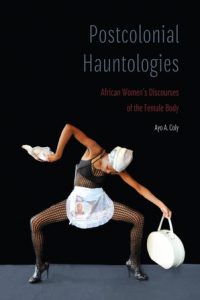 Postcolonial Hauntologies : African Women’s Discourses of the Female Body Ayo A. Coly (Series: Expanding Frontiers–Interdisciplinary Approaches to Studies of Women, Gender, and Sexuality)
Postcolonial Hauntologies : African Women’s Discourses of the Female Body Ayo A. Coly (Series: Expanding Frontiers–Interdisciplinary Approaches to Studies of Women, Gender, and Sexuality)
Postcolonial Hauntologies is an interdisciplinary and comparative analysis of critical, literary, visual, and performance texts by women from different parts of Africa. While contemporary critical thought and feminist theory have largely integrated the sexual female body into their disciplines, colonial representations of African women’s sexuality “haunt” contemporary postcolonial African scholarship which—by maintaining a culture of avoidance about women’s sexuality—generates a discursive conscription that ultimately holds the female body hostage. Ayo A. Coly employs the concept of “hauntology” and “ghostly matters” to formulate an explicative framework in which to examine postcolonial silences surrounding the African female body as well as a theoretical framework for discerning the elusive and cautious presences of female sexuality in the texts of African women.
In illuminating the pervasive silence about the sexual female body in postcolonial African scholarship, Postcolonial Hauntologieschallenges hostile responses to critical and artistic voices that suggest the African female body represents sacred ideological-discursive ground on which one treads carefully, if at all. Coly demonstrates how “ghosts” from the colonial past are countered by discursive engagements with explicit representations of women’s sexuality and bodies that emphasize African women’s power and autonomy.
Songs of Profit, Songs of Loss : Private Equity, Wealth, and Inequality  Daniel Scott Souleles (Series: Anthropology of Contemporary North America)
Daniel Scott Souleles (Series: Anthropology of Contemporary North America)
Since the early 1980s, private equity investors have heralded and shepherded massive changes in American capitalism. From outsourcing to excessive debt taking, private equity investment helped normalize once-taboo business strategies while growing into an over $3 trillion industry in control of thousands of companies and millions of workers. Daniel Scott Souleles opens a window into the rarefied world of private equity investing through ethnographic fieldwork on private equity financiers. Songs of Profit, Songs of Loss documents how and why investors buy, manage, and sell the companies that they do; presents the ins and outs of private equity deals, management, and valuation; and explains the historical context that gave rise to private equity and other forms of investor-led capitalism.
In addition to providing invaluable ethnographic insight, Songs of Profit, Songs of Loss is also an anthropological study of inequality as Souleles connects the core components of financial capitalism to economic disparities. Souleles uses local ideas of “value” and “time” to frame the ways private equity investors comprehend their work and to show how they justify the prosperity and poverty they create. Throughout, Souleles argues that understanding private equity investors as contrasted with others in society writ large is essential to fully understanding private equity within the larger context of capitalism in the United States.
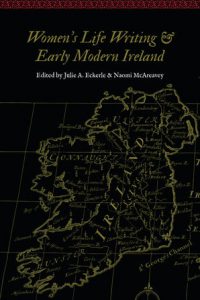 Women’s Life Writing & Early Modern Ireland Edited by Julie A Eckerle & Naomi McAreavey (Series: Women and Gender in the Early Modern World)
Women’s Life Writing & Early Modern Ireland Edited by Julie A Eckerle & Naomi McAreavey (Series: Women and Gender in the Early Modern World)
Women’s Life Writing and Early Modern Ireland provides an original perspective on both new and familiar texts in this first critical collection to focus on seventeenth-century women’s life writing in a specifically Irish context. By shifting the focus away from England—even though many of these writers would have identified themselves as English—and making Ireland and Irishness the focus of their essays, the contributors resituate women’s narratives in a powerful and revealing landscape.
This volume addresses a range of genres, from letters to book marginalia, and a number of different women, from now-canonical life writers such as Mary Rich and Ann Fanshawe to far less familiar figures such as Eliza Blennerhassett and the correspondents and supplicants of William King, archbishop of Dublin. The writings of the Boyle sisters and the Duchess of Ormonde—women from the two most important families in seventeenth-century Ireland—also receive a thorough analysis. These innovative and nuanced scholarly considerations of the powerful influence of Ireland on these writers’ construction of self, provide fresh, illuminating insights into both their writing and their broader cultural context.
Book Briefs: New University of Nebraska Press Books at the Nebraska Publications Clearinghouse

The Nebraska Publications Clearinghouse receives documents every month from all Nebraska state agencies, including the University of Nebraska Press (UNP). Each month we will be showcasing the UNP books that the Clearinghouse receives. UNP books, as well as all Nebraska state documents, are available for checkout by libraries and librarians, for their patrons, in Nebraska.
Here are the UNP books the Clearinghouse received in April:

Imaging Seattle : Social Values in Urban Governance Serin D. Houston (Series: Our Sustainable Future)
Imagining Seattle dives into some of the most pressing and compelling aspects of contemporary urban governance in the United States. Serin D. Houston uses a case study of Seattle to shed light on how ideas about environmentalism, privilege, oppression, and economic growth have become entwined in contemporary discourse and practice in American cities. Seattle has, by all accounts, been hugely successful in cultivating amenities that attract a creative class. But policies aimed at burnishing Seattle’s liberal reputation often unfold in ways that further disadvantage communities of color and the poor, complicating the city’s claims to progressive politics.
Through ethnographic methods and a geographic perspective, Houston explores a range of recent initiatives in Seattle, including the designation of a new cultural district near downtown, the push to charge for disposable shopping bags, and the advent of training about institutional racism for municipal workers. Looking not just at what these policies say but at how they work in practice, she finds that opportunities for social justice, sustainability, and creativity are all constrained by the prevalence of market-oriented thinking and the classism and racism that seep into the architecture of many programs and policies. Houston urges us to consider how values influence actions within urban governance and emphasizes the necessity of developing effective conditions for sustainability, creativity, and social justice in this era of increasing urbanization.
Intersectionality : Origins, Contestations, Horizons Anna Carastathis 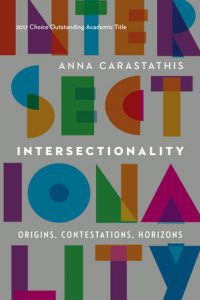 (Series: Expanding Frontiers)
(Series: Expanding Frontiers)
A 2017 Choice Outstanding Academic Title
Intersectionality intervenes in the field of intersectionality studies: the integrative examination of the effects of racial, gendered, and class power on people’s lives. While “intersectionality” tends to circulate merely as a buzzword, Anna Carastathis joins other critical voices in urging a more careful reading. Challenging the narratives of arrival that surround it, Carastathis argues that intersectionality is a horizon, illuminating ways of thinking that have yet to be realized; consequently, calls to “go beyond” intersectionality are premature. A provisional interpretation of intersectionality can disorient habits of essentialism, categorical purity, and prototypicality and overcome dynamics of segregation and subordination in political movements.
Through a close reading of critical race theorist Kimberlé Williams Crenshaw’s germinal texts, published more than twenty-five years ago, Carastathis urges analytic clarity, contextual rigor, and a politicized, historicized understanding of this pervasive concept. Intersectionality’s roots in social justice movements and critical intellectual projects—specifically black feminism—must be retraced and synthesized with a decolonial analysis so that its potential to actualize coalitions can be enacted.
 New Life for Archaeological Collections Edited by Rebecca Allen & Ben Ford (Society for Historical Archaeology Series in Material Culture)
New Life for Archaeological Collections Edited by Rebecca Allen & Ben Ford (Society for Historical Archaeology Series in Material Culture)
New Life for Archaeological Collections explores solutions to what archaeologists are calling the “curation crisis,” that is, too much stuff with too little research, analysis, and public interpretation. This volume demonstrates how archaeologists are taking both large and small steps toward not only solving the dilemma of storage but recognizing the value of these collections through inventorying and cataloging, curation, rehousing, artifact conservation, volunteer and student efforts, and public exhibits.
Essays in this volume highlight new questions and innovative uses for existing archaeological collections. Rebecca Allen and Ben Ford advance ways to make the evaluation and documentation of these collections more accessible to those inside and outside of the scholarly discipline of archaeology. Contributors to New Life for Archaeological Collections introduce readers to their research while opening new perspectives for scientists and students alike to explore the world of archaeology. These essays illuminate new connections between cultural studies and the general availability of archaeological research and information. Drawing from the experience of university professors, government agency professionals, and cultural resource managers, this volume represents a unique commentary on education, research, and the archaeological community.
Of Fathers and Fire : A Novel Steven Wingate (Series: Flyover Fiction) 
When Richie Thorpe and his ragtag religious band of ex-thieves arrive in the High Plains town of Suborney, Colorado, Tommy Sandor is captivated by the group. It’s the summer of 1980 in the dusty, junkyard town, and the seventeen-year-old is wrestling with the forces shaping America and himself: the Iran hostage crisis, the incoming tide of Ronald Reagan’s presidency, and the political rise of the Christian Right.
As Tommy is increasingly drawn to the group, his mother, Connie, grows frantic. She has been hiding the truth from her son, telling him that his father was a saxophonist from New York who never knew he had a child, and is lying low in Suborney to hide from Tommy’s actual father—Richie Thorpe. Connie knows Richie has come for his son, and though she has witnessed Thorpe’s mysterious powers, the desperation to protect her lie, her son, and their life begets a venom with an elemental power that threatens the whole town.
 Shattered Dreams : The Lost and Canceled Space Missions Colin Burgess (Series: Outward Oddyssey : A People’s History of Spaceflight)
Shattered Dreams : The Lost and Canceled Space Missions Colin Burgess (Series: Outward Oddyssey : A People’s History of Spaceflight)
Shattered Dreams delves into the personal stories and recollections of several men and women who were in line to fly a specific or future space mission but lost that opportunity due to personal reasons, mission cancellations, or even tragedies. While some of the subjects are familiar names in spaceflight history, the accounts of others are told here for the first time. Colin Burgess features spaceflight candidates from the United States, Russia, Indonesia, Australia, and Great Britain.
Shattered Dreams brings to new life such episodes and upheavals in spaceflight history as the saga of the three Apollo missions that were cancelled due to budgetary constraints and never flew; NASA astronaut Patricia Hilliard Robertson, who died of burn injuries after her airplane crashed before she had a chance to fly into space; and a female cosmonaut who might have become the first journalist to fly in space. Another NASA astronaut was preparing to fly an Apollo mission before he was diagnosed with a disqualifying illness. There is also the amazing story of the pilot who could have bailed out of his damaged aircraft but held off while heroically avoiding a populated area and later applied to NASA to fulfill his cherished dream of becoming an astronaut despite having lost both legs in the accident.
These are the incredibly human stories of competitive realists fired with an unquenchable passion. Their accounts reveal in their own words—and those of others close to them—how their shared ambition would go awry through personal accidents, illness, the Challenger disaster, death, or other circumstances.
Unlikely Heroes : The Place of Holocaust Rescuers in Research and  Teaching Edited by Ari Kohen and Gerald J. Steinacher (Series: Contemporary Holocaust Studies)
Teaching Edited by Ari Kohen and Gerald J. Steinacher (Series: Contemporary Holocaust Studies)
Classes and books on the Holocaust often center on the experiences of victims, perpetrators, and bystanders, but rescuers also occupy a prominent space in Holocaust courses and literature even though incidents of rescue were relatively few and rescuers constituted less than 1 percent of the population in Nazi-occupied Europe. As inspiring figures and role models, rescuers challenge us to consider how we would act if we found ourselves in similarly perilous situations of grave moral import. Their stories speak to us and move us.
Yet this was not always the case. Seventy years ago these brave men and women, today regarded as the Righteous Among the Nations, went largely unrecognized; indeed, sometimes they were even singled out for abuse from their co-nationals for their selfless actions. Unlikely Heroes traces the evolution of the humanitarian hero, looking at the ways in which historians, politicians, and filmmakers have treated individual rescuers like Raoul Wallenberg and Oskar Schindler, as well as the rescue efforts of humanitarian organizations. Contributors in this edited collection also explore classroom possibilities for dealing with the role of rescuers, at both the university and the secondary level.
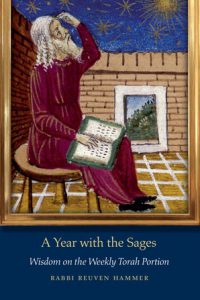 A Year With the Sages : Wisdom on the Weekly Torah Portion Rabbi Reuven Hammer (Series: JPS Daily Inspiration)
A Year With the Sages : Wisdom on the Weekly Torah Portion Rabbi Reuven Hammer (Series: JPS Daily Inspiration)
A Year with the Sages uniquely relates the Sages’ understanding of each Torah portion to everyday life. The importance of these teachings cannot be overstated. The Sages, who lived during the period from the fifth century BCE to the fifth century CE, considered themselves to have inherited the oral teachings God transmitted to Moses, along with the mandate to interpret them to each subsequent generation. Just as the Torah and the entire Hebrew Bible are the foundations of Judaism, the Sages’ teachings form the structures of Jewish belief and practice built on that foundation. Many of these teachings revolve around core concepts such as God’s justice, God’s love, Torah, Israel, humility, honesty, loving-kindness, reverence, prayer, and repentance.
You are invited to spend a year with the inspiring ideas of the Sages through their reflections on the fifty-four weekly Torah portions and the eleven Jewish holidays. Quoting from the week’s Torah portion, Rabbi Reuven Hammer presents a Torah commentary, selections from the Sages that chronicle their process of interpreting the text, a commentary that elucidates these concepts and their consequences, and a personal reflection that illumines the Sages’ enduring wisdom for our era.
Pictures and Synopses from the University of Nebraska Press website: https://www.nebraskapress.unl.edu/
Book Briefs: New University of Nebraska Press Books at the Nebraska Publications Clearinghouse

The Nebraska Publications Clearinghouse receives documents every month from all Nebraska state agencies, including the University of Nebraska Press (UNP). Each month we will be showcasing the UNP books that the Clearinghouse receives. UNP books, as well as all Nebraska state documents, are available for checkout by libraries and librarians, for their patrons, in Nebraska.
Here are the UNP books the Clearinghouse received in March:
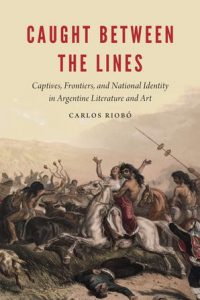 Caught Between the Lines Carlos Riobo (Series: New Hispanisms)
Caught Between the Lines Carlos Riobo (Series: New Hispanisms)
Caught between the Lines examines how the figure of the captive and the notion of borders have been used in Argentine literature and painting to reflect competing notions of national identity from the nineteenth to the twenty-first centuries. Challenging the conventional approach to the nineteenth-century trope of “civilization versus barbary,” which was intended to criticize the social and ethnic divisions within Argentina in order to create a homogenous society, Carlos Riobó traces the various versions of colonial captivity legends. He argues convincingly that the historical conditions of the colonial period created an ethnic hybridity—a mestizo or culturally mixed identity—that went against the state compulsion for a racially pure identity. This mestizaje was signified not only in Argentina’s literature but also in its art, and Riobó thus analyzes colonial paintings as well as texts.
Caught between the Lines focuses on borders and mestizaje (both biological and cultural) as they relate to captives: specifically, how captives have been used to create a national image of Argentina that relies on a logic of separation to justify concepts of national purity and to deny transculturation.

Death is All Around Us : Corpses, Chaos, and Public Health in Porfirian Mexico City Jonathan M. Weber (Series: The Mexican Experience)
Late nineteenth-century Mexico was a country rife with health problems. In 1876, one out of every nineteen people died prematurely in Mexico City, a staggeringly high rate when compared to other major Western world capitals at the time, which saw more modest premature death rates of one out of fifty-two (London), one out of forty-four (Paris), and one out of thirty-five (Madrid). It is not an exaggeration to maintain that each day dozens of bodies could be found scattered throughout the streets of Mexico City, making the capital city one of the most unsanitary places in the Western Hemisphere.
In light of such startling scenes, in Death Is All around Us Jonathan M. Weber examines how Mexican state officials, including President Porfirio Díaz, tried to resolve the public health dilemmas facing the city. By reducing the high mortality rate, state officials believed that Mexico City would be seen as a more modern and viable capital in North America. To this end the government used new forms of technology and scientific knowledge to deal with the thousands of unidentified and unburied corpses found in hospital morgues and cemeteries and on the streets. Tackling the central question of how the government used the latest technological and scientific advancements to persuade citizens and foreigners alike that the capital city—and thus Mexico as a whole—was capable of resolving the hygienic issues plaguing the city, Weber explores how the state’s attempts to exert control over procedures of death and burial became a powerful weapon for controlling the behavior of its citizens.
Ecology and Ethnogenesis : An Environmental History of the Wind River 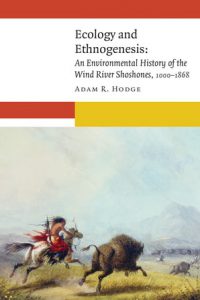 Shoshones, 1000-1868 Adam R. Hodge (Series: New Visions in Native American and Indigenous Studies)
Shoshones, 1000-1868 Adam R. Hodge (Series: New Visions in Native American and Indigenous Studies)
In Ecology and Ethnogenesis Adam R. Hodge argues that the Eastern Shoshone tribe, now located on the Wind River Reservation in Wyoming, underwent a process of ethnogenesis through cultural attachment to its physical environment that proved integral to its survival and existence. He explores the intersection of environmental, indigenous, and gender history to illuminate the historic roots of the Eastern Shoshone bands that inhabited the intermountain West during the nineteenth century.
Hodge presents an impressive longue durée narrative of Eastern Shoshone history from roughly 1000 CE to 1868, analyzing the major developments that influenced Shoshone culture and identity. Geographically spanning the Great Basin, Rocky Mountain, Columbia Plateau, and Great Plains regions, Ecology and Ethnogenesis engages environmental history to explore the synergistic relationship between the subsistence methods of indigenous people and the lands that they inhabited prior to the reservation era. In examining that history, Hodge treats Shoshones, other Native peoples, and Euroamericans as agents who, through their use of the environment, were major components of much broader ecosystems. The story of the Eastern Shoshones over eight hundred years is an epic story of ecological transformation, human agency, and cultural adaptation.
Ecology and Ethnogenesis is a major contribution to environmental history, ethnohistory, and Native American history. It explores Eastern Shoshone ethnogenesis based on interdisciplinary research in history, archaeology, anthropology, and the natural sciences in devoting more attention to the dynamic and often traumatic history of “precontact” Native America and to how the deeper past profoundly influenced the “postcontact” era.
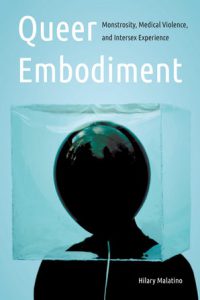 Queer Embodiment : Monstrosity, Medical Violence, and Intersex Experience Hilary Malatino (Series: Expanding Frontiers: Interdisciplinary Approaches to Studies of Women, Gender, and Sexuality)
Queer Embodiment : Monstrosity, Medical Violence, and Intersex Experience Hilary Malatino (Series: Expanding Frontiers: Interdisciplinary Approaches to Studies of Women, Gender, and Sexuality)
Merging critical theory, autobiography, and sexological archival research, Queer Embodiment provides insight into what it means, and has meant, to have a legible body in the West. Hilary Malatino explores how and why intersexuality became an anomalous embodiment requiring correction and how contesting this pathologization can promote medical reform and human rights for intersex and trans persons.
Malatino traces both institutional and interpersonal failures to dignify non–sexually dimorphic bodies and examines the ways in which the ontology of gender difference developed by modern sexologists conflicts with embodied experience. Malatino comprehensively shows how gender-normalizing practices begin at the clinic but are then amplified over time at both intimate and systemic levels, through mechanisms of institutional exclusion and through contemporary Eurocentric cultures’ cis-centric and bio-normative understanding of sexuality, reproductive capacity, romantic partnership, and kinship.
Combining personal accounts with archival evidence, Malatino presents intersexuality as the conceptual shibboleth of queerness, the figure through which nonnormative genders and desires are, and have been historically, understood. The medical, scientific, and philosophical discourse on intersexuality underlying our contemporary understanding of sexed selfhood requires theoretical and ethical reconsideration in order to facilitate understanding gender anew as an intra-active and continually differentiating process of becoming that exceeds and undoes restrictive binary logic.
 Walking to Magdalena : Personhood and Place in Tohono O’odham Songs, Sticks, and Stories
Walking to Magdalena : Personhood and Place in Tohono O’odham Songs, Sticks, and Stories
Seth Schermerhorn (Series: New Visions in Native American and Indigenous Studies)
In Walking to Magdalena, Seth Schermerhorn explores a question that is central to the interface of religious studies and Native American and indigenous studies: What have Native peoples made of Christianity? By focusing on the annual pilgrimage of the Tohono O’odham to Magdalena in Sonora, Mexico, Schermerhorn examines how these indigenous people of southern Arizona have made Christianity their own. This walk serves as the entry point for larger questions about what the Tohono O’odham have made of Christianity.
With scholarly rigor and passionate empathy, Schermerhorn offers a deep understanding of Tohono O’odham Christian traditions as practiced in everyday life and in the words of the O’odham themselves. The author’s rich ethnographic description and analyses are also drawn from his experiences accompanying a group of O’odham walkers on their pilgrimage to Saint Francis in Magdalena. For many years scholars have agreed that the journey to Magdalena is the largest and most significant event in the annual cycle of Tohono O’odham Christianity. Never before, however, has it been the subject of sustained scholarly inquiry.
Walking to Magdalena offers insight into religious life and expressive culture, relying on extensive field study, videotaped and transcribed oral histories of the O’odham, and archival research. The book illuminates indigenous theories of personhood and place in the everyday life, narratives, songs, and material culture of the Tohono O’odham.
Pictures and synopses courtesy of University of Nebraska Press.
Women Made Visible : Feminist Art and Media in Post-1968 Mexico City  Gabriela Aceves Sepulveda (Series: The Mexican Experience)
Gabriela Aceves Sepulveda (Series: The Mexican Experience)
In post-1968 Mexico a group of artists and feminist activists began to question how feminine bodies were visually constructed and politicized across media. Participation of women was increasing in the public sphere, and the exclusive emphasis on written culture was giving way to audio-visual communications. Motivated by a desire for self-representation both visually and in politics, female artists and activists transformed existing regimes of media and visuality.
Women Made Visible by Gabriela Aceves Sepúlveda uses a transnational and interdisciplinary lens to analyze the fundamental and overlooked role played by artists and feminist activists in changing the ways female bodies were viewed and appropriated. Through their concern for self-representation (both visually and in formal politics), these women played a crucial role in transforming existing regimes of media and visuality—increasingly important intellectual spheres of action. Foregrounding the work of female artists and their performative and visual, rather than written, interventions in urban space in Mexico City, Aceves Sepúlveda demonstrates that these women feminized Mexico’s mediascapes and shaped the debates over the female body, gender difference, and sexual violence during the last decades of the twentieth century.
Weaving together the practices of activists, filmmakers, visual artists, videographers, and photographers, Women Made Visible questions the disciplinary boundaries that have historically undermined the practices of female artists and activists and locates the development of Mexican second-wave feminism as a meaningful actor in the contested political spaces of the era, both in Mexico City and internationally.
Pictures and Synopses from the University of Nebraska Press website: https://www.nebraskapress.unl.edu/
Book Briefs: New University of Nebraska Press Books at the Nebraska Publications Clearinghouse
 The Nebraska Publications Clearinghouse receives documents every month from all Nebraska state agencies, including the University of Nebraska Press (UNP). Each month we will be showcasing the UNP books that the Clearinghouse receives. The UNP books, as well as all Nebraska state documents, are available for checkout by libraries and librarians in Nebraska.
The Nebraska Publications Clearinghouse receives documents every month from all Nebraska state agencies, including the University of Nebraska Press (UNP). Each month we will be showcasing the UNP books that the Clearinghouse receives. The UNP books, as well as all Nebraska state documents, are available for checkout by libraries and librarians in Nebraska.
Here are the UNP books the Clearinghouse received in February:
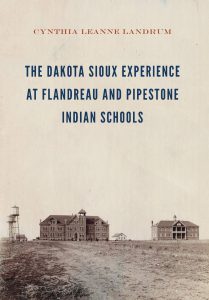 The Dakota Sioux Experience at Flandreau and Pipestone Indian Schools
The Dakota Sioux Experience at Flandreau and Pipestone Indian Schools
The Dakota Sioux Experience at Flandreau and Pipestone Indian Schools illuminates the relationship between the Dakota Sioux community and the schools and surrounding region, as well as the community’s long-term effort to maintain its role as caretaker of the “sacred citadel” of its people.
Cynthia Leanne Landrum explores how Dakota Sioux students at Flandreau Indian School in South Dakota and at Pipestone Indian School in Minnesota generally accepted the idea that they should attend these particular boarding institutions because they saw them as a means to an end and ultimately as community schools. This construct operated within the same philosophical framework in which some Eastern Woodland nations approached a non-Indian education that was simultaneously tied to long-term international alliances between Europeans and First Peoples beginning in the seventeenth and eighteenth centuries.
Landrum provides a new perspective from which to consider the Dakota people’s overt acceptance of this non-Native education system and a window into their ongoing evolutionary relationships, with all of the historic overtures and tensions that began the moment alliances were first brokered between the Algonquian Confederations and the European powers.
The Image of Elizabeth I in Early Modern Spain (Series: New Hispanisms)

Queen Elizabeth I was an iconic figure in England during her reign, with many contemporary English portraits and literary works extolling her virtue and political acumen. In Spain, however, her image was markedly different. While few Spanish fictional or historical writings focus primarily on Elizabeth, numerous works either allude to her or incorporate her as a character.
The Image of Elizabeth I in Early Modern Spain explores the fictionalized, historical, and visual representations of Elizabeth I and their impact on the Spanish collective imagination. Drawing on works by Miguel de Cervantes, Lope de Vega, Pedro de Ribadeneira, Luis de Góngora, Cristóbal de Virués, Antonio Coello, and Calderón de la Barca, among others, the contributors to this volume limn contradictory assessments of Elizabeth’s physical appearance, private life, personality, and reign. In doing so they articulate the various and sometimes conflicting ways in which the Tudor monarch became both the primary figure in English propaganda efforts against Spain and a central part of the Spanish political agenda.
This edited volume revives and questions the image of Elizabeth I in early modern Spain as a means of exploring how the queen’s persona, as mediated by its Spanish reception, has shaped the ways in which we understand Anglo-Spanish relations during a critical era for both kingdoms.

One Nation Under Baseball
One Nation Under Baseball highlights the intersection between American society and America’s pastime during the 1960s, when the hallmarks of the sport—fairness, competition, and mythology—came under scrutiny. John Florio and Ouisie Shapiro examine the events of the era that reshaped the game: the Koufax and Drysdale million-dollar holdout, the encroachment of television on newspaper coverage, the changing perception of ballplayers from mythic figures to overgrown boys, the arrival of the everyman Mets and their free-spirited fans, and the lawsuit brought against team owners by Curt Flood. One Nation Under Baseball brings to life the seminal figures of the era—including Bob Gibson, Marvin Miller, Tom Seaver, and Dick Young—richly portraying their roles during a decade of flux and uncertainty.
This Fish Is Fowl 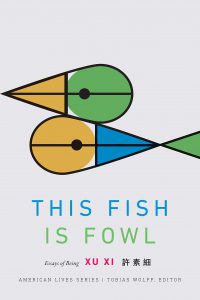 (Series: American Lives)
(Series: American Lives)
In this volume, Xu Xi offers the transnational and feminist perspective of a contemporary “glocalized” American life. Xu’s quirky, darkly comic, and obsessively personal essays emerge from her diverse professional career as a writer, business executive, entrepreneur, and educator. From her origins in Hong Kong as an Indonesian of Chinese descent to her U.S. citizenship and multiple countries of residence, she writes her way around the globe.
Caring for her mother with Alzheimer’s in Hong Kong becomes the rhythmic accompaniment to an enforced, long-term, long-distance relationship with her partner and home in New York. In between Xu reflects on all her selves, which are defined by those myriad monikers of existence. As an author who began life as a novelist and fiction writer, she also considers the nature of genre, which snakes its way through these essays. In her linguistic trip across the comic tragedy that is globalism, she wonders about the mystery of humanity and the future of our world at this complicated and precarious moment in human existence.
This Fish Is Fowl is a twenty-first-century blend of the essayist traditions of both West and East. Xu’s acerbic, deft prose shows her to be a descendant of both Michel de Montaigne and Lu Xun, with influences from stepparent Jonathan Swift.
 A Year with Mordecai Kaplan : Wisdom on the Weekly Torah Portion (Series: JPS Daily Inspiration)
A Year with Mordecai Kaplan : Wisdom on the Weekly Torah Portion (Series: JPS Daily Inspiration)
You are invited to spend a year with the inspirational words, ideas, and counsel of the great twentieth-century thinker Rabbi Mordecai Kaplan, through his meditations on the fifty-four weekly Torah portions and eleven Jewish holidays.
A pioneer of ideas and action—teaching that “Judaism is a civilization” encompassing Jewish culture, art, and peoplehood; demonstrating how synagogues can be full centers for Jewish living (building one of the first “shuls with a pool”); and creating the first-ever bat mitzvah ceremony (for his daughter Judith)—Kaplan transformed the landscape of American Jewry. Yet much of Kaplan’s rich treasury of ethical and spiritual thought is largely unknown.
Rabbi Steven Carr Reuben, who studied closely with Kaplan, offers unique insight into Kaplan’s teachings about ethical relationships and spiritual fulfillment, including how to embrace godliness in everyday experience, our mandate to become agents of justice in the world, and the human ability to evolve personally and collectively. Quoting from the week’s Torah portion, Reuben presents Torah commentary, a related quotation from Kaplan, a reflective commentary integrating Kaplan’s understanding of the Torah text, and an intimate story about his family or community’s struggles and triumphs—guiding twenty-first-century spiritual seekers of all backgrounds on how to live reflectively and purposefully every day.
Your Body is War (Series: African Poetry) 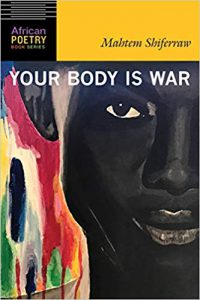
Your Body Is War contemplates the psychology of the female human body, looking at the ways it exists and moves in the world, refusing to be contained in the face of grief and trauma. Bold and raw, Mahtem Shiferraw’s poems explore what the woman’s body has to do to survive and persevere in the world, especially in the aftermath of abuse.
A groundbreaking collection, the poems in Your Body Is War embody elements of conflict, making them simultaneously a place of destruction and of freedom.
Pictures and synopses courtesy of University of Nebraska Press.
Book Briefs: New University of Nebraska Press Books at the Nebraska Publications Clearinghouse
 The Nebraska Publications Clearinghouse receives documents every month from all Nebraska state agencies, including the University of Nebraska Press (UNP). Beginning today, and each month as we receive them, we will be showcasing the UNP books that the Clearinghouse receives. The UNP books, as well as all Nebraska state documents, are available for checkout by libraries and librarians in Nebraska.
The Nebraska Publications Clearinghouse receives documents every month from all Nebraska state agencies, including the University of Nebraska Press (UNP). Beginning today, and each month as we receive them, we will be showcasing the UNP books that the Clearinghouse receives. The UNP books, as well as all Nebraska state documents, are available for checkout by libraries and librarians in Nebraska.
Here are UNP books the Clearinghouse received in January:
 Citizen Akoy: Basketball and the Making of a South Sudanese American
Citizen Akoy: Basketball and the Making of a South Sudanese American
Akoy Agau led Omaha Central High School to four straight high school basketball state championships (2010–13) and was a three‑time All‑State player. One of the most successful high school athletes in Nebraska’s history, he’s also a South Sudanese refugee. At age four, Akoy and his family fled Sudan during the Second Sudanese Civil War, and after three years in Cairo, they came to Maryland as refugees. They arrived in Omaha in 2003 in search of a better future. In a fluid, intimate, and joyful narrative, Steve Marantz relates Akoy’s refugee journey of basketball, family, romance, social media, and coming of age at Nebraska’s oldest and most diverse high school. Set against a backdrop of the South Sudanese refugee community in Omaha, Marantz provides a compelling account of the power of sports to blend cultures in the unlikeliest of places.
Come Fly with Us: NASA’s Payload Specialist Program (Series: Outward  Odyssey: A People’s History of Spaceflight)
Odyssey: A People’s History of Spaceflight)
Come Fly with Us is the story of an elite group of space travelers who flew as members of many space shuttle crews from pre-Challenger days to Columbia in 2003. Not part of the regular NASA astronaut corps, these professionals known as “payload specialists” came from a wide variety of backgrounds and were chosen for an equally wide variety of scientific, political, and national security reasons. Melvin Croft and John Youskauskas focus on this special fraternity of spacefarers and their individual reflections on living and working in space. Relatively unknown to the public and often flying only single missions, these payload specialists give the reader an unusual perspective on the experience of human spaceflight. The authors also bring to light NASA’s struggle to integrate the wide-ranging personalities and professions of these men and women into the professional astronaut ranks.
 Echo of Its Time: The History of the Federal District Court of Nebraska, 1867-1933
Echo of Its Time: The History of the Federal District Court of Nebraska, 1867-1933
Throughout its existence the Federal District Court of Nebraska has echoed the dynamics of its time, reflecting the concerns, interests, and passions of the people who have made this state their home. Echo of Its Time explores the court’s development, from its inception in 1867 through 1933, tracing the careers of its first four judges: Elmer Dundy, William Munger, Thomas Munger (no relation), and Joseph Woodrough, whose rulings addressed an array of issues and controversies echoing macro-level developments within the state, nation, and world. Echo of Its Time both informs and entertains while using the court’s operations as a unique and accessible prism through which to explore broader themes in the history of the state and the nation. The book explores the inner workings of the court through Thomas Munger’s personal correspondence, as well as the court’s origins and growing influence under the direction of its legendary first judge, Elmer Dundy. Dundy handled many notable and controversial matters and made significant decisions in the field of Native American law, including Standing Bear v. Crook and Elk v. Wilkins. From the turn of the century through 1933 the court’s docket reflected the dramatic and rapid changes in state, regional, and national dynamics, including labor disputes and violence, political corruption and Progressive Era reform efforts, conflicts between cattle ranchers and homesteaders, wartime sedition and “slacker” prosecutions, criminal enterprises, and the endless battles between government agents and bootleggers during Prohibition.
Hearing Voices: Aurality and New Spanish Sound Culture in Sor Juana Inés 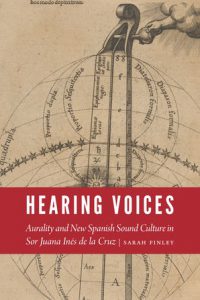 de la Cruz (Series: New Hispanisms)
de la Cruz (Series: New Hispanisms)
Hearing Voices takes a fresh look at sound in the poetry and prose of colonial Latin American poet and nun Sor Juana Inés de la Cruz (1648/51–95). A voracious autodidact, Sor Juana engaged with early modern music culture in a way that resonates deeply in her writing. Despite the privileging of harmony within Sor Juana’s work, however, links between the poet’s musical inheritance and subjects such as acoustics, cognition, writing, and visual art have remained unexplored. These lacunae have marginalized nonmusical aurality and contributed to the persistence of both ocularcentrism and a corresponding visual dominance in scholarship on Sor Juana—and indeed in early modern cultural production in general. Hearing Voices focuses on these aural conceits in highlighting the importance of sound and—in most cases—its relationship with gender in Sor Juana’s work and early modern culture. Sarah Finley explores attitudes toward women’s voices and music making; intersections of music, rhetoric, and painting; aurality in Baroque visual art; sound and ritual; and the connections between optics and acoustics. Finley demonstrates how Sor Juana’s striking aurality challenges ocularcentric interpretations and problematizes paradigms that pin vision to logos, writing, and other empirical models that traditionally favor men’s voices. Sound becomes a vehicle for women’s agency and responds to anxiety about the female voice, particularly in early modern convent culture.
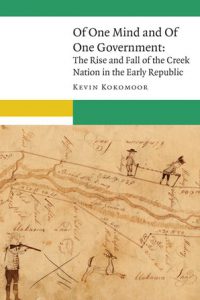 Of One Mind and Of One Government: The Rise and Fall of the Creek Nation in the Early Republic (Series: Early American Places, and, New Visions in Native American and Indigenous Studies)
Of One Mind and Of One Government: The Rise and Fall of the Creek Nation in the Early Republic (Series: Early American Places, and, New Visions in Native American and Indigenous Studies)
In Of One Mind and Of One Government Kevin Kokomoor examines the formation of Creek politics and nationalism from the 1770s through the Red Stick War, when the aftermath of the American Revolution and the beginnings of American expansionism precipitated a crisis in Creek country. The state of Georgia insisted that the Creeks sign three treaties to cede tribal lands. The Creeks objected vigorously, igniting a series of border conflicts that escalated throughout the late eighteenth century and hardened partisan lines between pro-American, pro-Spanish, and pro-British Creeks and their leaders. Creek politics shifted several times through historical contingencies, self-interests, changing leadership, and debate about how to best preserve sovereignty, a process that generated national sentiment within the nascent and imperfect Creek Nation.
Based on original archival research and a revisionist interpretation, Kokomoor explores how the state of Georgia’s increasingly belligerent and often fraudulent land acquisitions forced the Creeks into framing a centralized government, appointing heads of state, and assuming the political and administrative functions of a nation-state. Prior interpretations have viewed the Creeks as a loose confederation of towns, but the formation of the Creek Nation brought predictability, stability, and reduced military violence in its domain during the era.
One Size Fits None: A Farm Girl’s Search for the Promise of Regenerative 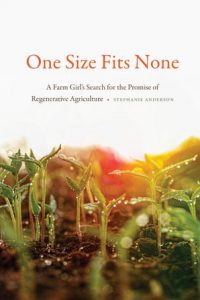 Agriculture
Agriculture
“Sustainable” has long been the rallying cry of agricultural progressives; given that much of our nation’s farm and ranch land is already degraded, however, sustainable agriculture often means maintaining a less-than-ideal status quo. Industrial agriculture has also co-opted the term for marketing purposes without implementing better practices. Stephanie Anderson argues that in order to provide nutrient-rich food and fight climate change, we need to move beyond sustainable to regenerative agriculture, a practice that is highly tailored to local environments and renews resources. In One Size Fits None Anderson follows diverse farmers across the United States: a South Dakota bison rancher who provides an alternative to the industrial feedlot; an organic vegetable farmer in Florida who harvests microgreens; a New Mexico super-small farmer who revitalizes communities; and a North Dakota midsize farmer who combines livestock and grain farming to convert expensive farmland back to native prairie. The use of these nontraditional agricultural techniques show how varied operations can give back to the earth rather than degrade it. This book will resonate with anyone concerned about the future of food in America, providing guidance for creating a better, regenerative agricultural future.
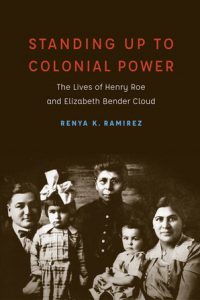 Standing Up to Colonial Power: The Lives of Henry Roe and Elizabeth Bender Cloud (Series: New Visions in Native American and Indigenous Studies)
Standing Up to Colonial Power: The Lives of Henry Roe and Elizabeth Bender Cloud (Series: New Visions in Native American and Indigenous Studies)
Standing Up to Colonial Power focuses on the lives, activism, and intellectual contributions of Henry Cloud (1884–1950), a Ho-Chunk, and Elizabeth Bender Cloud (1887–1965), an Ojibwe, both of whom grew up amid settler colonialism that attempted to break their connection to Native land, treaty rights, and tribal identities. Mastering ways of behaving and speaking in different social settings and to divergent audiences, including other Natives, white missionaries, and Bureau of Indian Affairs officials, Elizabeth and Henry relied on flexible and fluid notions of gender, identity, culture, community, and belonging as they traveled Indian Country and within white environments to fight for Native rights. Elizabeth fought against termination as part of her role in the National Congress of American Indians and General Federation of Women’s Clubs, while Henry was one of the most important Native policy makers of the early twentieth century. He documented the horrible abuse within the federal boarding schools and co-wrote the Meriam Report of 1928, which laid the foundation for the Indian Reorganization Act of 1934. Together they ran an early college preparatory Christian high school, the American Indian Institute. Standing Up to Colonial Power shows how the Clouds combined Native warrior and modern identities as a creative strategy to challenge settler colonialism, to become full members of the U.S. nation-state, and to fight for tribal sovereignty. Renya K. Ramirez uses her dual position as a scholar and as the granddaughter of Elizabeth and Henry Cloud to weave together this ethnography and family-tribal history.
Words Like Birds: Sakha Language Discourses and Practices in the City  (Series: Borderlands and Transcultural Studies)
(Series: Borderlands and Transcultural Studies)
What does it mean to speak Sakha in the city? Words Like Birds, a linguistic ethnography of Sakha discourses and practices in urban far eastern Russia, examines the factors that have aided speakers in maintaining—and adapting—their minority language over the course of four hundred years of contact with Russian speakers and the federal power apparatus. Words Like Birds analyzes modern Sakha linguistic sensibilities and practices in the urban space of Yakutsk. Sakha is a north Siberian Turkic language spoken primarily in the Sakha Republic (Yakutia) in the northeastern Russian Federation. For Sakha speakers, Russian colonization in the region inaugurated a tumultuous history in which their language was at times officially supported and promoted and at other times repressed and discouraged. Jenanne Ferguson explores the communicative norms that arose in response to the top-down promotion of the Russian language in the public sphere and reveals how Sakha ways of speaking became emplaced in villages and the city’s private spheres. Focusing on the language ideologies and practices of urban bilingual Sakha-Russian speakers, Ferguson illuminates the changes that have taken place in the first two post-Soviet decades, in contexts where Russian speech and communicative norms dominated during the Soviet era. Weaving together three major themes—language ideologies and ontologies, language trajectories, and linguistic syncretism—this study reveals how Sakha speakers transform and adapt their beliefs, evaluations, and practices to revalorize a language, maintain and create a sense of belonging, and make their words heard in Sakha again in many domains of city life. Like the moveable spirited words, the focus of Words Like Birds is mobility, change, and flow, the tracing of the situation of bilinguals in Yakutsk.
Pictures and synopses courtesy of University of Nebraska Press.
#BookFaceFriday – “Maria Czaplicka: Gender, Shamanism, Race” by Grażyna Kubica
We tip our hat to this week’s #BookFaceFriday.
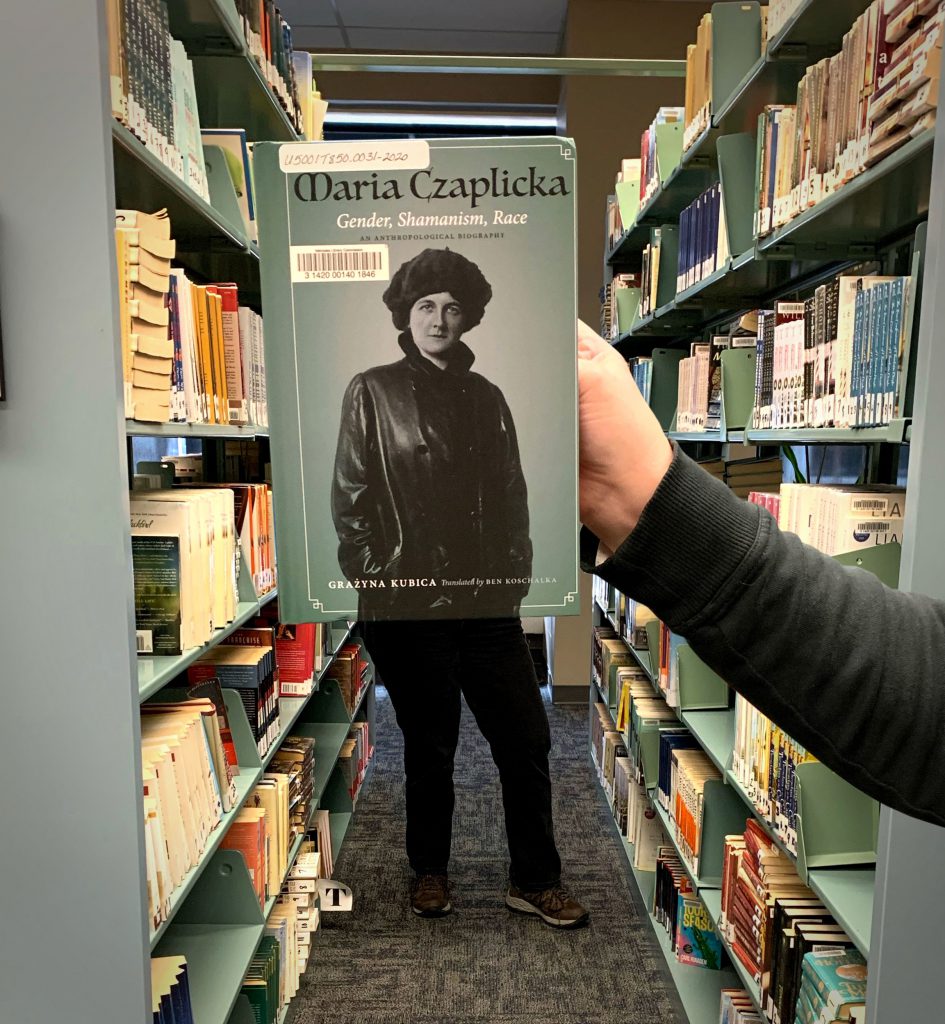
If expanding your worldview or knowledge through reading was on your list of New Year’s goals, check out “Maria Czaplicka: Gender, Shamanism, Race (Critical Studies in the History of Anthropology)” written by Grażyna Kubica, translated by Ben Koschalka (University of Nebraska Press; Illustrated Edition, 2020.) The Nebraska Library Commission’s Collection is always growing, the Nebraska Publications Clearinghouse receives documents every month from all Nebraska state agencies, including the University of Nebraska Press (UNP). UNP books, as well as all Nebraska state documents, are available for checkout by libraries and librarians for their patrons.
“Grazyna Kubica examines Maria Czaplicka’s unfinished scientific legacy in this page-turner history of anthropology during wartime Britain. One review of Czaplicka’s account of her 1915 Siberian expedition proclaimed that she ‘could not be dull if she tried.’ Kubica offers a full and fitting tribute to Czaplicka’s indomitable spirit, her contributions to continuing debates, and the meaning of a truncated life in anthropology.”—Sally Cole, professor of sociology and anthropology at Concordia College and author of Ruth Landes: A Life in Anthropology
This week’s #BookFace model is Mary Sauers, NLC’s Government Information Services Librarian. Mary writes the monthly Book Briefs blog post showcasing the latest UNP books that the Clearinghouse has received.
Love this #BookFace & reading? Check out our past #BookFaceFriday photos on the Nebraska Library Commission’s Facebook page!
What’s Up Doc? New State Agency Publications at the Nebraska Library Commission
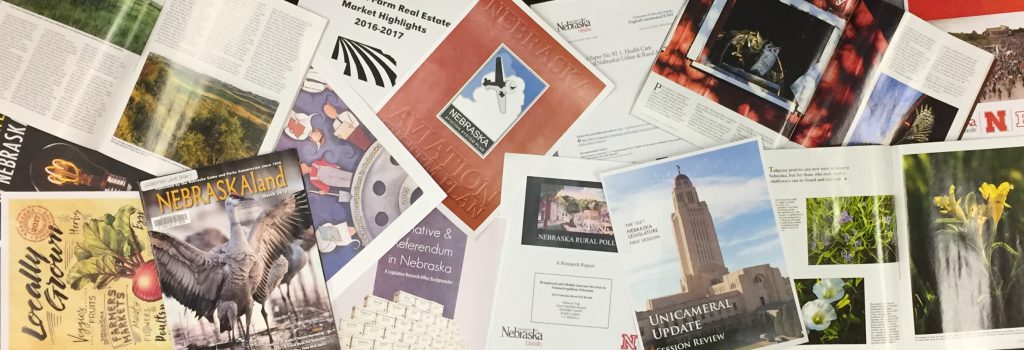
New state agency publications have been received at the Nebraska Library Commission for November and December, 2023. Included are reports from the Nebraska Environmental Trust, the Nebraska Crime Commission, the Nebraska Department of Transportation, and new books from the University of Nebraska Press, to name a few.
Most items, except the books from the University of Nebraska Press, are available for immediate viewing and printing by clicking on the highlighted link above, or directly in the .pdf below. You can read synopses of the books received from the University of Nebraska Press in the Book Briefs blogposts.
The Nebraska Legislature created the Nebraska Publications Clearinghouse in 1972 as a service of the Nebraska Library Commission. Its purpose is to collect, preserve, and provide access to all public information published by Nebraska state agencies. By law (State Statutes 51-411 to 51-413) all Nebraska state agencies are required to submit their published documents to the Clearinghouse. For more information, visit the Nebraska Publications Clearinghouse page, contact Mary Sauers, Government Information Services Librarian; or contact Bonnie Henzel, State Documents Staff Assistant.
Posted in Books & Reading, Education & Training, General, Information Resources, What's Up Doc / Govdocs
Tagged books, GovDocs, Reading
Leave a comment

